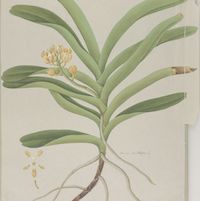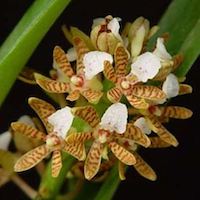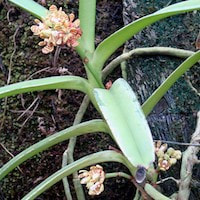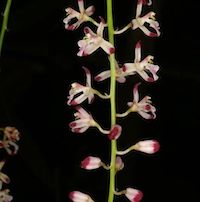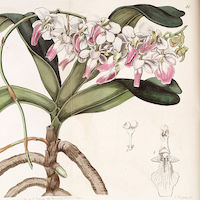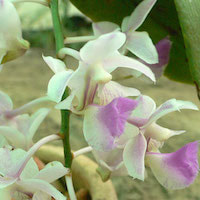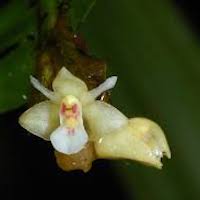Therapeutic Orchids A-P
We have been researching on Fragrant Orchids and our quest lead us to various Orchid genomes that were not only Fragrant but also Medicinal.

Ancient Chinese medicine philosophy, known as the “qi” was discovered by the Yellow Emperor, father of Chinese medicine. It explores the body’s capacity to heal itself.
Today's medicines have many forms of complementary and alternative medical practices to help relieve pain. These alternative medicines have turned to the medicinal benefits of orchids discovered ages ago.
Many orchids have been found to have medicinal properties, whether used in drugs, taken due to tonic potential, or used to cure chapped skin and bleeding sores.
For example, Salep, a drug made from orchids Orchis Mascula and Orchis Militaris, was once extremely popular in Turkey. It was and is used in the Turkish ice cream bastani. Salep flour was also used in desserts and beverages mainly in the Ottoman empire, and in Syria and Palestine, it is a traditional winter beverage.
Another instance is dendrobium, an orchid that is taken because of its tonic potential. Dried Dendrobium is believed to possess medicinal properties that can help treat cancer, strengthen the immune system, and improve eyesight.
Additionally, orchids have also been used in food. One such example is the vanilla orchid, who’s bean is used for flavoring in the much loved classic vanilla ice cream. Another example is the genus Dendrobia, which is commonly used as a food ingredient or garnish.
So, in conclusion, though orchids are known mostly as decorative items to beautify our homes, they have many more uses than we may think.
List of most popular Therapeutic Orchids of Asia:
|
Acampe Lindl. |
Acampe carinata (Griff.) Panigrahi
Indian Name: Kano Kato. OR Thai name: Phaya mue lung
The name Acampe or Greek akampes means (rigid), which is the character of the plant. Also called ‘rigid air flower’, Acampe is a robust, monopodial epiphyte with coriaceous leaves and rigid flowers. It is easily found in throughout Thailand, and is also found in Myanmar, Sikkim, Mumbai, the Western Ghats and Sri Lanka. Herbal Usage: The entire plant is used in rural Thailand as a tonic to strengthen the body. Root paste is applied externally on scorpion and snake bites in the eastern peninsular Indian state of Orissa. Here, leaf paste is consumed with a clove of garlic daily for 7 days to obtain relief from chest or epigastric pain. At Uttarakhand in Western Himalaya, A. carinata is used to treat rheumatism, sciatica and nerve pain. Some of the phytochemicals like alkaloid, anthocyanins, arundinan, bibenzyl, cypripedin, dendrobine, gigantol, glucoside, glycoside, gymopusin, hircinol, jibantine, kinsenoside, loroglossin, nidemin and orchinol, phenanthrene, phenanthropyran, rotundatin and moscatin, stilbenoid, triterpenoid are reported from Acampe Genome. |
|
Acampe praemorsa |
Acampe praemorsa Indian names: Marabale, Maravasha, Khanbher, Nakul, Rasna, Taliyamaravada, Rasna, Kano-kato, Gandhata ; Nepali names: Parajivi (name is widely applied to epiphytic orchids) Chinese name: Duanxucui Lan (short crispy orchid) Myanmar name: Mee ma long pan Thai name: Chang saraphi noi Rasna, a decoction of the roots of A. praemorsa, is a bitter tonic that is considered to be a specific remedy for rheumatism in India. Its usage also extends to the treatment of sciatica, neuralgia, syphilis and uterine disorders in the country. The primitive Dongria Kandha tribe from Niyamgiri Hills consume a tablespoon made from the roots of A. praemorsa on an empty stomach, twice daily for 15 days, when they suffer from arthritis. Koya tribe from Andra Pradesh uses the pulverised plant, mixed with egg white and calcium to produce a paste for application on fractured limbs to promote healing. In Nepal, the powdered root of A. praemorsa is used to treat rheumatism or to produce a cooling effect. Acampe Praemorsa contains natural flavidinin (CAS Number: 83925-00-2) and the phenanthropyran named praemorsin (CAS Number :159736-36-4) |
|
Acampe rigida Hunt OR Acampe multiflora |
Acampe rigida Hunt OR Acampe multiflora Chinese names: Duohuacui Lan or Jiawandailan, Taiwanhouchun Lan, Changyejiawandai Lan Hongkong Name: Banana orchid Taiwan, Jiao Lan, pa chio lan Thai names: Chaang sarapee, Ueang sarapi, Ueang jed poi Perhaps the most important name is its Chinese medicinal name: Heishanzhe. The Chinese herb Heishanzhe (A. rigida) is obtained from Guangdong, Guangxi and Yunnan. Chinese medicinal texts state that its roots and leaves relax muscles and joints, promote blood circulation and relieve pain, hence it is used to treat traumatic injuries and fractures. In Laos, leaves were used in making mats. In Thailand, the entire plant is used as a tonic to strengthen the body. Active Ingredients that made it medicinal are: 4-hydroxybenzoic acid, 4- hydroxybenaldehyde and 4-methoxymethyl phenol. |
|
Acriopsis liliifolia |
Acriopsis liliifolia Malay Names: Anggerek darat, Sakat Ubat Kepialu, Pemolek The name is derived from Greek acris (locust) and opsis (resembling). They are common in low- land forests and on roadside trees throughout Southeast Asia. Ants often build gardens around its pseudobulbs, because lipids on the seed coats of the orchid attract ants that assist in their dispersal. A decoction of the leaves and roots was used as an antipyretic in Malaya (Ridley 1907; - Head of Singapore Botanical Garden and Burkill 1935). In Indonesia, juice from the pseudobulbs was dropped into the ear to cure earache or tinnitus, and pulverised pseudobulb was plastered on the head or abdomen to treat fever and hypertension. Roots are used for treating rheumatism in the Western Ghats in India. |
|
Aerides crispa Lindl. |
Aerides crispa Lindl. The generic name, ‘children of the air’, is derived from Greek aer (air) and eides (resembling), referring to its epiphytic nature and the way such orchids are cultivated. A. crispa is a large, tough, robust epiphyte. Young leaves are typically covered with purple spots. Inflorescence is up to 35 cm long, drooping, branching, loosely many-flowered. Ear-drops prepared by boiling the pulverised plant in neem oil, are instilled 2–3 drops at a time into the ear every night to treat earache in the Western Ghats. A. crispa contains aeridin, a bactericidal phenanthropyran. The contribution of aeridin to the management of earache is undetermined, but it works as a bactericide. |
|
Aerides falcata Lindl. & Paxton |
Aerides falcata Lindl. Chinese name: Zhijia Lan Thai names: Ueang Kulaab Krapao Perd They smell so nice and work so well! A. falcata produces numerous sprays of extremely fragrant, white flowers, about 30 to a spray. A. falcata is distributed throughout Thailand, Indochina and Myanmar, but not further south. In Vietnam, it is fed to weak infants as a tonic. Its seeds are sprinkled on boils and other skin disorders to help heal the lesions. |
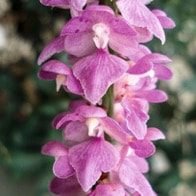
Aerides multiflora Roxb.
|
Aerides multiflora Roxb. Thai names: Uang Kulap Malai Daeng Its leaf paste is applied to cuts and wounds in India and Nepal. But the powdered leaf is made into a tonic. The tubers have an antibacterial effect in vitro and the leaves are believed to have antimicrobial effects. |
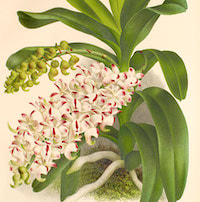
Aerides odorata Lour.
|
Aerides odorata Lour Common name: Fragrant Aerides Chinese name: Xianghuazhijia Lan (fragrant flowered Zhijia orchid) Indonesian names : Angkrek Lilin, Lau Bintang in Kalimantan Thai name: Ueang Kulaab Krapao Pid Indian name: Hameri in Orissa This is a widespread species which grows into a magnificent clump especially if it gets direct sunlight for half a day and is located near water. It is commonly found in Singapore and blooms around Aug-sept. Flowers are in bunch of 20-30, that lasts 2 weeks and are very fragrant. In Nepal, a paste prepared from the leaves is applied over cuts and wounds. Fruits of A. odorata are used to heal wounds in India. Juice extracted from the leaves is used to treat boils in the ear and nose. Vietnamese sprinkle the seeds over the lesions to heal boils and other skin disorders. Hill tribes in Orissa combine the fresh root of A. odorata with root powder from Saraca asoca, bark from Azadirachta indica and common salt to prepare an oral medicine for painful swollen joints. They also use juice from the leaves to treat tuberculosis. How it works? - Extract of A. odorata exhibits inhibitory activity against antibiotic-sensitive, penicillin-resistant and kanamycin-resistant strains of Escherichia coli, common organisms in stools, on skin and in superficial infections. Phytoalexins such as aeridin possess antimicrobial effects. An oral Indian preparation of this Orchid, contained natural salicylate (basis of Aspirin). Chemically speaking - It has gigantol, imbricatin, methoxycoelonin and coelonin. It also contains 5 minor constituents- phenanthropyran, 2 dihydrophenenthrene derivatives and 2 phenenthrenes {aerosanthrene (5-methoxyphenenthrene-2,3,7- triol) and aerosin (3-methoxy-9,10-dihydro- 2,5,7-phenanthrenetriol)} |
|
Medicinal Compounds in Agrostophyllum
|
Agrostophyllum stipulatum ssp. bicuspidatum . Chinese name: Heye Lan The generic name comes from Greek, agrostis (grass) and phyllon (leaf). Flowers are small and self- pollinating and are considered mythical. The Kalabit in Sarawak wear parts of the orchid as talismans to protect against curses. Talismans and charms are very much a part of native Asian medicine. They do not make sense to most medicine practitioners hence we have listed several medicinal chemicals which have been extracted from this or subspecies. This includes-
|
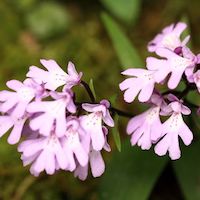
Amitostigma Schltr
|
Amitostigma gracile (Blume) Schltr Chinese names: Xitingwuzhu Lan (slim standing no pillar orchid), Xiewuzhu Lan (slim standing no pillar orchid), Huawuzhu Lan (no pillar/ column orchid) Chinese medicinal name: Duyeyizhiqiang Amitostigma are small, montane, terrestrial orchids of the Himalayas, China and Japan. Plants are small, with spheroid, subterranean tubers. The generic name is derived from three Greek words, a (not) mitos (thread) and stigma (stigma). Herbal Recipes-
|
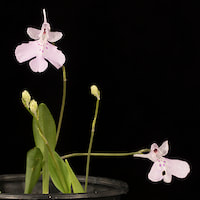
Amitostigma pinguicula
|
Amitostigma pinguicula Chinese names: Dahuawuzhu Lan (big flower no pillar orchid) The entire plant is used in preparing medicine in various forms. It is used as cure for detoxification, to reduce heavy swellings, in the treatment of trauma and snake bites, as an antidote for poisons and to treat haematemesis. This medicinal orchid is found in Fujian, Zhejiang, Hubei and Sichuan. |
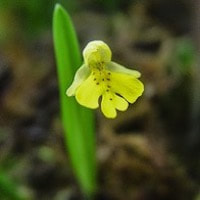
Amitostigma simplex
|
Amitostigma simplex Chinese names: Huanghuawuzhu Lan (yellow flower no pillar orchid) It's found on grassy slopes above 2300–4400 m in western Sichuan and Southwestern Yunnan. Unfortunately, it is on the 2006 IUCN Red List of Threatened Species. This can be substituted by Amitostigma pinguicula as the usage is same. |
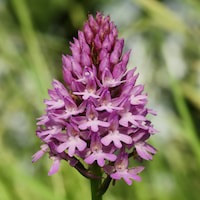
Anacamptis Rich
|
Anacamptis Rich It derives its name from Greek anakamptein (to bend back). A dozen species are distributed in grasslands in the northern Iran, the Middle East and southern and central Europe. Tubers of Anacamptis are harvested to make salep, once thought to be an aphrodisiac and super-nutrient throughout Europe. |

Anacamptis coriophora
|
Anacamptis coriophora Common name: Bug orchid Flowers are small, green to deep wine-red. Tepals are joined to form a hood above the column. P-hydroxybenzyl alcohol, an aglycone of gastrodin, has been isolated from many terrestrial and mycoheterotrophic orchid species. In rats, gastrodin and p-hydroxybenzyl alcohol facilitate memory consolidation and retrieval. p-Hydroxybenzyl alcohol also has skin whitening effects because it inhibits tyrosinase, the enzyme that catalyses the formation of the skin pigment, melanin. |
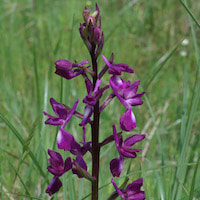
Anacamptis laxiflora
|
Anacamptis laxiflora Common name: Jersey Orchid Indian name: Salep misri , shala misriri In India, the tubers were used as an expectorant, an astringent and as nourishment. Powder prepared from dried tubers was used to prepare salep, a drink that was alleged to boost one’s libido and sexual performance. Salep drinking boomed during the heyday of the Ottoman Empire when even sultans took to eating halva made with salep. Fun fact- No one knows why, but in Iran and Afghanistan, grazing goats and sheep avoid this orchid |
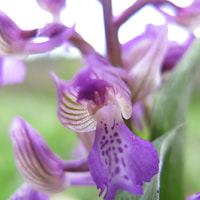
Anacamptis morio ssp. picta
|
Anacamptis morio ssp. picta Tubers are harvested in Iran for use as salep, a health drink and also considered to be super food. In Europe, Anacamptis species are protected. Although untrue, it was once believed that salep contained the greatest amount of nourishment in the smallest bulk. To protect against famine at sea, it was proposed that salep should constitute part of a ship’s provision at all times. Orchid tubers (not salep) are fed to weak children cut off from other supplies . |
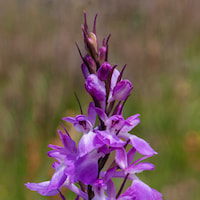
Anacamptis palustris
|
Anacamptis palustris Common name: Bog orchid Salep is made from few types of Anacamptis. This also is harvested in Iran for use as salep . |
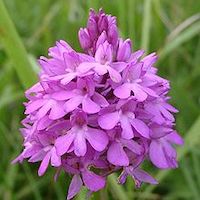
Anacamptis pyramidalis
|
Anacamptis pyramidalis Like mentioned above, Salep is made from few types of Anacamptis. This is harvested in Turkey (and Iran) for use as salep . Best grades of salep should have a mucin content greater than 40 % and an ash content which is lower than 5 %. This orchid has mucin content of 44.72 % and an ash content of 1.72 %, which makes it one of the top 5 choices to make Salep. It produces two phytoalexins, orchinol and p-hydroxybenzyl alcohol and hence is used in skin whitening. It also exhibits antioxidant and scavenging capacities in vitro. |
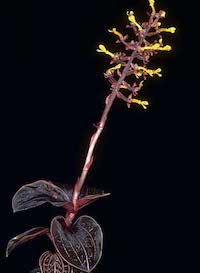
Anoectochilus Blume
|
Anoectochilus Blume Chinese name: Jinxian Lan (gold thread orchid) Chinese medicinal name: Jianxianlan Anoectochilus has beautiful, soft, velvety, almost oval foliage decorated with fine golden veins. They are called Jewel Orchids because as a group they possess distinctive velvety foliage with attractively coloured veins. The generic name, Anoectochilus, is derived from Greek, anoektos (open) and cheilos (lip). There are about 40 sub-species, distributed from Sri Lanka, Singapore, India and across southern China. |
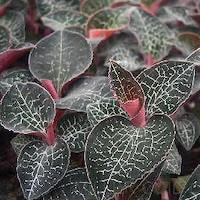
Anoectochilus formosanus Hayata
|
Anoectochilus formosanus Hayata Chinese names: Jinxian Lan (gold thread orchid); Benshanshisong (mountain stone pine), Jinqianzicao (golden currency notes baby grass), Shucan Lian (tree and grass lotus), Yaowang (King of Medicine); Yaofu (strong medicine), Wusen, Taiwan jewel orchid. In Taiwanese (Hokien dialect): Kim soa lian (gold thread lotus), Kim chi a chha (gold streaked herb), Oa ke chahau (black herb) A. formosanus is found throughout Taiwan in primeval forests or in bamboo stands at 500–1500 m, and in the Ryukyu Islands. The entire plant is used in TCM for cooling the blood, to smooth the liver, as an antipyretic and for detoxification. It is also used to treat tuberculosis diabetes, bronchitis, kidney infection, bladder infections, cramps, snake bites and stomach ache. The entire plant is used for treating pain at the waist and knee, numbness, haematemesis, nocturnal emission, nephritis, vaginal discharge and convulsions affecting children. Scientists in China found 8 compounds in Orchid, with their own benefits
Scientist in Tokyo further found that wild A. formosanus grown contained ten compounds including kinsenoside, which has hepato-protective properties.
|
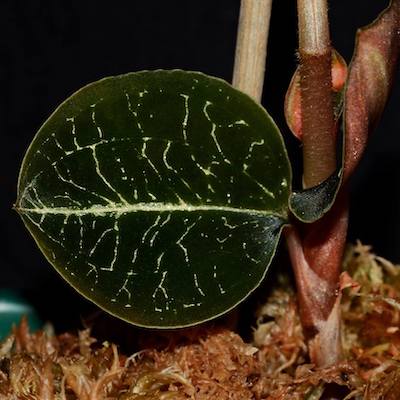
Anoectochilus koshunensis Hayata
|
Anoectochilus koshunensis Hayata Chinese name: Gaoxiong Jinxian Lan (Gaoxiong golden thread orchid) Taiwanese name: Kaohsiung (jewel orchid). Other common names: Hengchunjinxianlian (Hengchun golden thread lotus); Jinxian Lan (golden thread orchid). In Taiwanese (Hokien) dialect: Ko hiong kim soa lian; Heng chhun kim soa lian The whole plant “cools the blood and smoothes the liver”. It is antipyretic and removes toxins. Commonly used to treat haemoptysis from tuberculosis, diabetes, bronchitis, nephritis, cystitis, convulsions and snake bites. Kinsenoside and Five sterols, including a new one with a non-conventional side chain [26-methylstigmasta-5,22,25, (27)-trien-3 beta- ol], together with a megastigmane glucoside and 20-deoxyadenosine, was isolated from this Orchid. |
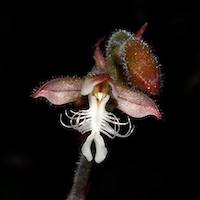
Anoectochilus reinwardtii Blume
|
Anoectochilus reinwardtii Blume A. reinwardtii is found in Sumatra, Java, Borneo and Maluku at 1400–1700 m and it is believed to have magical powers. The Iban and Kelabit tribes of Borneo use the orchid to treat infertility. Supposedly infertile woman would conceive if leaves of a single plant are placed under their sleeping mat. |
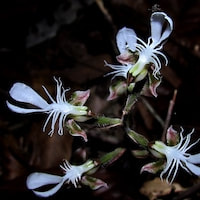
Anoectochilus roxburghii (Wall.) Lind
|
Anoectochilus roxburghii (Wall.) Lindl. Sri Lankan name: Wanna rajah (“that which glistens in the woods”). Taiwanese name:Yaowang (King medicine) This Orchid has dark velvety-green/purplish-red with a complex network of golden veins. This small, terrestrial, jewel orchid thrives in humus rich soil in continental East Asia including China, Vietnam, Laos, Myanmar and also the Himalayan foothills and Sri Lanka. It is a medicinal herb that enjoys widespread provincial usage in Taiwan and Fujian. It is used to treat hepatitis, splenic disorders, hypertension, cancer, tuberculosis, impotence, fever, snake bites and even slow development in children. In Fujian, it is considered to be a panacea for numerous ailments. It is also used in Indian medicines. Several therapeutic compounds have been isolated from this therapeutic orchid. · Zhonghua Bencau Kinsenoside, a glycoside and a major component has anti-glycaemic activity. · Other medicinal compounds are- beta-D-glucopyranosyl-3R)-hydroxybutanolide. · stearic acid · palmitic acid · beta-sitosterol · succinic acid · p-hydroxybenzy-laldehyde, daucosterol, · methyl 4-beta-D- glucopyranosyl-hutanoate, · p-hydroxycinnamic acid · 0-hydroxy phenol · Ferulic acid, · quercetin, · daucosterol, · cirsilineol, · p- hydroxybenzylaldehyde · 2 novel sorghumol triterpenoid acyl esters · a new alkaloid (anoecochine) · and a known triterpenoid (soghumol) |
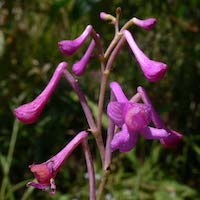
Anthogonium Lindl.
|
Anthogonium gracile Wall ex Lindl. Chinese name: Tongban Lan (barrel petal orchid) Chinese medicinal name: Honghuaxiaodusuan Thai name: Wan phrao It is a small, slender, terrestrial Orchid which is found in Sri Lanka and the eastern Himalayas to the southern Chinese provinces of Xizang, Yunnan, Guizhou and Guangxi, and also in the northern parts of Myanmar, Thailand, Laos and Vietnam. The plant produces Batatasin III (Batatsin II is a phytoalexin with antifungal properties.) and is used to treat menstrual disorders and to prevent pain. |

Apostasia nuda R. Br.
|
Apostasia nuda R. Br. Malay names: Si sarsar bulang, Si marsari sari, Duhut bane-bane, Poko pulumpus bedak, Dudulu ingap, Kniching pelandok Apostasia is a genus of seven primitive terrestrial orchids. It is fairly common in lowland dipterocarp forests in Malaysia but is not easily recognised as an orchid. It is also distributed in Myanmar, southern Thailand and Indonesia in lowland forests. Roots are boiled and made into poultices to treat diarrhoea in Malaysia, and an infusion of the fruit was a local remedy for sore eyes (Burkill). Mr Burkill and also his father were directors of the Singapore Botanic Gard |
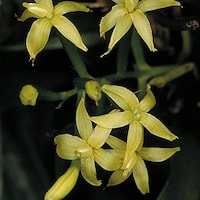
Apostasia wallichii R. Br.
|
Apostasia wallichii R. Br. Chinese name: Jianyeni Lan Thai name: Tan khamoi, Ma thon lak Indonesian name: Djukut mayang kasintu (grass like tail feather of jungle cockerel) Malay name: Hanching fatimah, Kenching Fatimah It is distributed from Nepal, Assam (India), Sri Lanka, Thailand, Hainan and south-west Yunnan (in China) and through Southeast Asia to even New Guinea and Australia. Flowering is not seasonal. The root is used as a tonic in Thailand. It was used as an antidiabetic agent in Malaya |
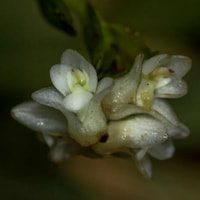
Appendicula Blume
|
Appendicula cornuta Blume Appendicula is a genus with 163 species, distributed from India and China throughout Southeast Asia to the Pacific. Being a fairly common and widely distributed lowland species in Southeast Asia, it is not surprising that Appendicula cornuta Blume was used in Indonesian folk medicine. Alkaloid was detected in this Orchid and its stem-juice is used in Maluku as a medicine for whitlow. |
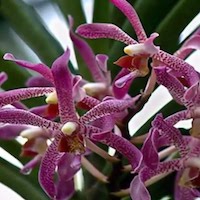
Arachnis
|
Arachnis Blume Chinese name: Zhizhu Lan The Greek word arachne (spider, scorpion) Members of the genus are commonly known as Scorpion Orchids. Arachnis is distributed in Peninsular Thailand, Malaysia, Singapore and Indonesia. Hybrids between Arachnis and other monopodial orchids travel well, and they were used to initiate the transcontinental cut flower orchid industry. Intergeneric hybridisation involving Arachnis is extensive. |
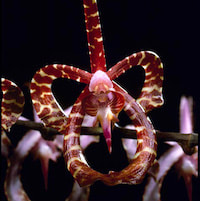
Arachnis moschifera
|
Arachnis moschifera Thai name: Ueang maeng mum It is found in Malaysia, Thailand, Sumatra and Borneo. Although this species is not native to Singapore, Mr. Cedric Errol Carr managed to collect its natural hybrid, A. maingayi, which was growing on coastal mangrove in Pulau Seletar. A. maingayi is a natural hybrid between A. flosaeries and A. hookeriana They have very strong musk scent. The species was previously known as A. moschifera because of the scent. Ibans of Sarawak apply sap from the orchid plant onto the painful site to relieve toothache |

Arundina Blume
|
Arundina Blume Chinese name: Zhuye Lan (bamboo leaf orchid). In Taiwanese (Hokien) dialect: chiau a hoe Arundo is Latin for ‘reed’. Arundina is a grass-like, terrestrial orchid which resembles bamboo in vegetative form, and Cattleya in the appearance of its flowers. Arundina is a familiar orchid in Southeast Asia. It is found in India, Nepal and Sri Lanka, southern China and Southeast Asia to the Ryukyu Islands and Tahiti. |
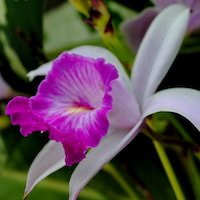
Arundina graminifolia
|
Arundina graminifolia - It was one of 3 orchid that reappear in Krakatoa after the massive volcanic eruption in 1883 . Common name: Bamboo Orchid Chinese names: Zhuye Lan (bamboo leaf orchid); Changgan Lan (long stem orchid) Shiyu Lan (jade stone orchid); Hu Lian (lake lotus); Caojiang (ginger grass); Dayeliaodiaozhu (big leaf bamboo); in Taiwan: bird orchid Indonesian name: Anggerik Bamb; in Sundanese: Handjuwang Sapu Malaysian name: Phanyar among the aboriginal Jakuns of Johor Myanmar name: Wah thitkhw Thai name: Ueang Pai Vietnamese name: Lan say It flowers throughout the year in Malaysia, Singapore and Indonesia. In Thailand, the flowering season extends from August to March, but in the Kachin and Shan states of adjacent Myanmar, the flowering season is reversed, March to July. The herb is bitter, neutral, anti-inflammatory and diuretic. It is also thought to have antibacterial properties. In India the bulbous stem- scrapings are used to heal cracks on the skin. In Hong Kong the whole plant or pseudobulb is used both- fresh or sun-dried. The orchid is used for a variety of conditions ranging from hepatitis and jaundice to urinary tract infections, oedema, rheumatic pain, trauma and snake bites. In China (particularly in Yunnan & Guangxi), a decoction prepared by boiling 9–15 g of the whole plant is used for pain relief, the treatment of bruises, oedema, abdominal pain, intestinal parasitic infestation, jaundice, pulmonary tuberculosis, mental illness, rheumatism and bleeding from knife wounds. What makes it medicinal-
5 phenanthrene were also isolated. Their properties are still under research :
Important antitumour activity was exhibited by the first three compounds, maxi- mal in compound 3 which possesses an open bibenzyl ring:
|
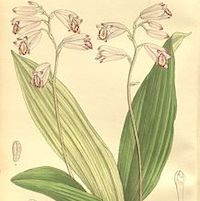
Bletilla foliosa
|
Bletilla foliosa Chinese name: Xiaobaiji (small Baiji; small white root) Vietnamese name: Bach cap; Hoa lan tia Flowering season is May to June. The species is found in Yunnan, Myanmar and Thailand. It is an outstanding astringent and promotes wound healing. It is also an excellent embolic material. |

Bletilla formosana
|
Bletilla formosana Chinese names: Taiwanbaiji (Taiwan Baiji), hyacinth orchid, Chinese ground orchid, white rhizome orchid, Xiao Baiji (Small Baiji) Japanese name: Shi-ran (purple orchid) Traditional Chinese medicine (TCM) uses the stems to strengthen the lungs, stop bleeding and reduce swelling. It is also used to treat patients suffering from tuberculous cough, bronchiectasis, bleeding peptic ulcers and nose-bleed. In India, scrapings of the stem are applied to treat cracks on the heel. What makes it medicinal?- 12 dihydrophenanthrenes including blestriarene B have antimicrobial effects on two pathogenic bacteria: Staphylococcus aureus, a common cause of skin infections, and Streptococcus mutans, which causes dental decay. |
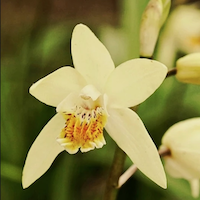
Bletilla ochracea
|
Bletilla ochracea Chinese name: Huanghua Baiji (yellow flower white mucilaginous root) Phenanthrenes with antimicrobial activity against three Gram-positive bacteria (Staphylococcus aureus, S. epidermidis and Bacillus subtilis) are present in Bletilla ochracea . |
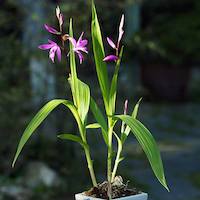
Bletilla striata
|
Bletilla striata Chinese name: Baiji (white mucilaginous root, white chicken), Gangen (sweet root), Baigen (white root), Baijiertou (white hen’s head/ top), Shantianji (mountain frog) Lian Ji Cao. Bak-kup in Hong Kong, Taiwanese (Hokien) dialect: Peh kiu (white ginger) Japanese: Shiran (purple orchid, Japanese Urn Orchid) Korean name: Jaran Vietnamese names: Bach cap; Hua lan tia It is distributed in China, Korea and Japan. To meet demand, it is also commercially grown in Guizhou, Yunnan, Jiangxi and Guangxi. Guizhou produces the largest quantity of top-quality Baiji. Its taste is stated as bitter, sweet and acerbic. According to TCM its nature is slightly cold, hence it benefits the lungs, liver and stomach meridians. According to TCM, the tubers need to be cut into thin slices or crushed into a fine powder after cleaning and drying. This when chewed become gluey. The cut surface is brittle, translucent-white and somewhat sticky with faint odour. The powder is different and is slightly yellowish, odourless and bitter. This powder when mixed with water it turns gluey hence it should be stored in air-tight containers. Tubers are used in the treatment of swelling and haemorrhage. It reduces swelling and promotes regeneration of muscle and other tissues. It is given to patients with tuberculosis that cough up blood due to bleeding in bronchiectasis. It also helps with gastric bleeds, bleeding from trauma or burns, bleeding pustules, bleeding ulcers, fissure-in-ano and skin fissures of extremities caused by exposure to cold. They are used to treat sores, scaling and chapped skin. In Vietnam, it is made into an emollient for burns. Five antimicrobial agents consisting of 3 bibenzyls & 2 dihydrophenanthrenes were found in this orchid. Bibenzyls Are:
Scientists have isolated antihelminthic substance from the tubers of B. striata growing on Gangweondo (Korean peninsula), which workks against Clonorchiasis. Clonorchiasis is a disease caused by eating raw freshwater fish or snails that carry the encysted cercaria of the liver fluke. Clonorchiasis leads to cholecystitis (infection of the gall blad- der), bilary adenomatous hyperplasia, bile duct obstruction, cholangiofibrosis, cirrhosis of the liver and an increased risk of cholangiocarcinoma A novel gene carrier has been developed from bioactive glucomannan, a polysaccharide isolated from B. striata (BSP). In the experiment, they successfully inhibited the expression of TNF-alpha. Scientists expect cBSP to be capable of conveying antisense nucleotides (e.g. oligodeoxynucleotide and small inter- ference RNA) for anti-inflammatory therapy. Conjugated B. striata polysaccharide is a promising avenue for the delivery of cytotoxic agents to tumours. It is also used as an embolization agent to treat unresectable liver tumours. |
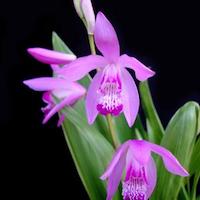
Bletia hyacinthina
|
Bletia hyacinthina It is used as a remedy for dysentery, haemorrhoids and ague in Malaya region. It was also applied as a soothing medication over the abdomen of children with dyspepsia. It is commonly considered demulcent and is used in the diseases of a dyspeptic character. It is also used in treatment of burns, wounds and other skin diseases. |
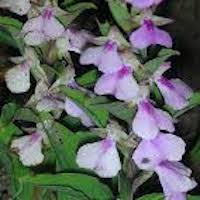
Brachycorythis
|
Brachycorythis obcordata Chinese name: Baoye Lan Nepali name: Gangdol Common name: Heart shaped Brachycorythis Brachycorythis is a genus of over 30 predominantly terrestrial orchids distributed in Africa and tropical Asia. The name is derived from the Greek brachy (short) and korys (helmet). B. obcordata is distributed in India, Bhutan, Bangladesh and Myanmar. It flowers June to August in Bangladesh; July to August in Nepal; July to September in Bhutan. The root is an astringent, expectorant, antidiarrhoeal, with use as a tonic in Nepal. Boiled pseudobulbs are eaten as food. Leaves and shoots are also cooked and eaten as a vegetable. |
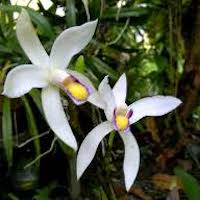
Bromheadia finlaysoniana
|
Bromheadia finlaysoniana Malaysian names: Seraman in Kelabit, Wi buntak (Iban), Busak paya (Malay) There are 17 species distributed from Sri Lanka across Southeast Asia to Australia. Two Malaysian species, B. brevifolia and B. ruprestris, occur in the highlands. finlaysoniana is a Malaysian lowland species. On some days the flowers are plentiful whereas on other days there are no flowers. This is because when flower buds reach 12 mm in length, their growth abruptly slows down and this allows younger buds to catch up. An unusually cool day accelerates their development and 7 days later the orchid flowers gregariously. Mr. Burkill reported that in Malacca, a decoction of the roots was consumed for rheumatism. In Peninsular Malaysia, flower stalks was chewed for treating asthma. In Sarawak, it was used to treat body aches |
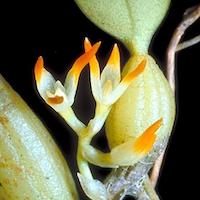
Bulbophyllum Thouars
|
Bulbophyllum Thouars Chinese name: Shi duo Lan The generic name is derived from Greek bulbo (bulb) and phyla (leaf). Bulbophyllums are very easy to grow and they flower readily, usually following a drop in temperature occasioned by a storm. Medicinal usage have been reported for only 23 species. |
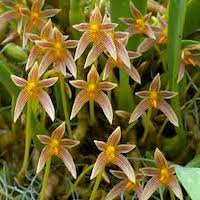
Bulbophyllum affine
|
Bulbophyllum affine Chinese name: Chichunshidou Lan (red lip stone bean orchid), Gaoshifodou Lan (Gaoshifo bean orchid), Wenxing Lan (stripe star orchid) Widely distributed from the Ryukyu Islands of Japan through China, Indochina, Thailand and Myanmar to the foothills of the Himalayas. In Taiwan, the entire plant is used as a tonic, antipyretic, to reduce phlegm, and to stop bleeding . |
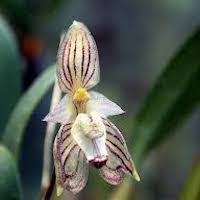
Bulbophyllum ambrosia
|
Bulbophyllum ambrosia Chinese name: Fangxuianshidou Lan (fragrant stone bean orchid), Xiangshidou Lan (fragrant stone bean orchid) Chinese medicinal name: Fangzhucao Fragrant flowers are borne singly, 2 cm across, white with crimson longitudinal stripes during February to May. Herbs are obtained from Fujian, Guangdong, Guangxi and Yunnan and may be harvested throughout the year. They are used fresh , steamed or dried. Taste is dry, bland and cold in nature. Chinese CTM uses a decoction of the plant, prepared by boiling dried herb to treat hepatitis, coughs and heat in the lungs. |
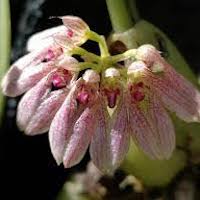
Bulbophyllum andersonii
|
Bulbophyllum andersonii also Cirrhopetalum andersonii and Cirrhopetalum henryi Rolfe Chinese names: Shumaojuanban Lan (comb hat roll petal orchid), Chenhongjuanban Lan (orange color roll petal orchid) Chinese medicinal name: Yipicao This pretty Cirrhopetalum is native to Guangxi, SW Sichuan, Guizhou and Yunnan in China, and in Vietnam, Myanmar, Sikkim and India. In China, flowering period is February to October, in Sikkim, September to October. The entire plant is used for expelling wind and removing dampness, improving blood flow, stopping coughs and clearing retention of food. A decoction of 6–15 g of the plant is used to treat rheu matism. For feminine weakness, the prescription calls for a soup to be prepared with 6–15 g of the herb and chicken meat or pork. B. andersonii contains
|

Bulbophyllum careyanum
|
Bulbophyllum careyanum Foul smelling pseudobulb is conical with a single elliptic leaf at its apex. Inflorescence arises from this base. It is distributed in Nepal, Bhutan, Myanmar, Thailand and Vietnam. Herbal Usage: Poultices made with the pseudobulbs and leaves are used to treat burns on the skin. |
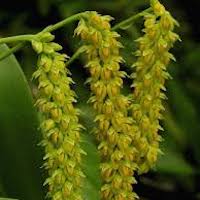
Bulbophyllum cariniflorum
|
Bulbophyllum cariniflorum and Bulbophyllum densiflorum Chinese name: Jianyeshiduo Lan Indian name: Sumura It is found in China northern Thailand, northeast India, Bhutan and Nepal. It grows in moist habitats, and between May and June, following the arrival of the monsoon rains. A paste made from the dried roots, black pepper and cow’s milk is taken for several days to induce abortion during the first trimester in the districts of Mondanala and Sutanguni in the Niyamgiri Hill Ranges of Orissa, India. |

Bulbophyllum cylindraceum
|
Bulbophyllum cylindraceum Chinese Name: Dabaoshidou Lan (large bud stone bean orchid) Dense dark purple flower look like catkin. In China, it flowers from October to January, in October to January in Bhutan and November in Nepal. It is obtained from Sichuan and Yunnan. Entire plant is used to treat painful joints and numbness. |

Bulbophyllum flabellum-veneris
|
Bulbophyllum flabellum-veneris Syn. Bulbophyllum lepidum (Blume) J.J. Sm., Cirrhopetalum lepidum (Blume) Schltr. Thai names: Phet phra in, Sa mai, Khon dam phi Widely distributed in Southeast Asia but not further east than Borneo. The olive-green flowers are found throughout the year with a peak during the rainy seasons which are determined by monsoons. In Thailand, the pseudobulb is widely used to treat oedema whereas the entire plant is used to treat liver dysfunction. |
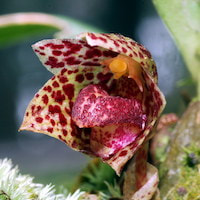
Bulbophyllum griffithi
|
Bulbophyllum griffithi Syn. Bulbophyllum calodictyon Schltr., B. chitoense S.S. Ying, Sarcopodium griffithi Lindl Chinese name: Duanchishiduo Lan (stone bean orchid), Xiaolushidaolan (small green stone bean orchid) Chinese medicinal name: Shichuanlian Grows in central Taiwan, south- east Yunnan, Vietnam, northeast India, Bhutan and Nepal. It flowers in February, August and October to November in China, and in August at the Khasia Hills and in Sikkim in northeast. Main usage is to treat chronic coughs, bronchitis and sore throat. Fresh or dry pseudobulbs are used for treating pulmonary condition to relieve coughs, pain and reduce inflammation. Paste can also applied to fractures, infected breasts, abscesses and all types of sores. |
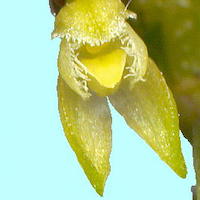
Bulbophyllum inconspicuum
|
Bulbophyllum inconspicuum Japanese name: Mugiran (Wheat Orchid) Chinese medicinal names: Maihu (Wheat epiphyte), Guoshanye (leaf over fruits) Yiguayu (one hanging fish); Yangnaicao (goat’s milk herb); Yaquezui (bird mouth), Linzhijiao; Shiyangmei (rock berry); Wangniantao (10,000 peach); Zishangye (leaf on paper); Guazilian(seed lotus); Shilongshiwei (stone dragon and stone tail); Qixiantao (seven immortal peach); Shixiantao (stone immortal peach); Xiaokuozi Lan (small button orchid); Shiwenchong (rock mosquito) Huangdoubian (soyabean whip) Loushanglou (building over building) Shilianzi (stone lotus seeds) Genshangzi (seeds above the roots); shi yu (stone bean). It can cure fever and coughs, hundred-day cough (whooping cough, pertussis), bronchiectasis , coughs associated with tuberculosis , Damage of yin by febrile illness and polydipsia. It can also be used for Painful, swollen joints , children’s frightfulness, coughs with hoarse voice, external injuries , facial acne and skin ulcers. They have also been known to cure menstrual irregularities and tooth ache. |
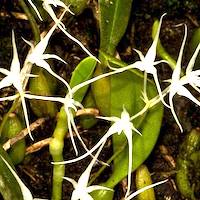
|
Bulbophyllum kwangtungense Chinese name: Guangdongshidou Lan (Guangdong Province stone bean orchid) A miniature Bulbophyllum that flowers from May to August. It thrives on rocks in forests of China, Hong Kong and Lantau Islands. Pseudobulbs can be used fresh or steamed & powdered. The entire plant is used to treat coughs, reduce “heat”, clear “wind”, and convulsions in children. Taste is dry, bland and cold in nature. It releases heat, nourishe yin and relieves swelling. It is also used for rheumatism and arthritic pain, traumatic injuries and mastitis. For external use, pounded pseudobulbs are apply to affected parts. The Chinese Materia Medica advises that should be used with caution by people who have a “cold body”. It contains
|
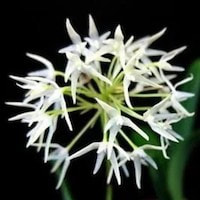
|
Bulbophyllum laxiflorum Syn. Bulbophyllum radiatum Chinese names: Fusheshidou Lan (radiating stone bean orchid); Yashe Lan (Duck tongue orchid) Chinese medicinal names: Shizao (Stone date); Shiduo (stone bean); Yanduo (stone bean); Jinduo (golden date); Shimi (Stone rice); Duyiyanzhu (Single leaf cliff pearl) Found in southeastern China, Myanmar, Thailand and Peninsular Malaysia. B. laxiflorum is believed to enrich the Yin and benefit lungs by clearing phlegm and stopping haemoptysis. It also helps stomach by improving appetite, helping digestion and relieving dry throat. |
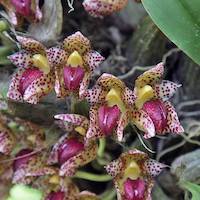
|
Bulbophyllum leopardinum Chinese name: Duantingshiduo Lan Widely distributed in Nepal, Bhutan, India, China . Poultice made with the pseudobulbs is used in Nepal to treat burns on the skin . Active compound - phenenthrine and bulbophyllanthrin. |
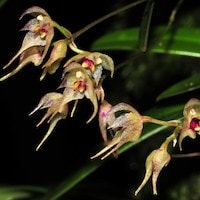
|
Bulbophyllum levinei Chinese name: Chibanshidou Lan (tooth petal stone bean orchid) Chinese medicinal name: Duyeyanzhu It is used to treat swellings. It “benefits yin, reduces heat”, hence used to treat sore throat, tonsillitis, mouth ulcers and fever. For decoction, 6–15 g dried herb or 30–60 g of fresh herb is boiled. For external usage, plant pulverised to make a paste. |
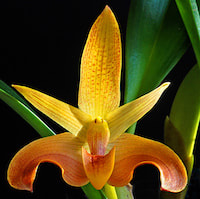
|
Bulbophyllum lobbii. Syn. Bulbophyllum siamense. Thai name: lin fa in Ubon Rachthani In Thailand, leaves are used to treat burns. This has a very unique with a very distinct smell. Bulbophyllum is parent to at least 1800 orchids, but lobbii is special. |
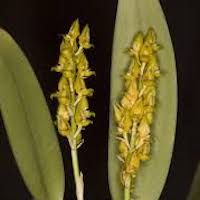
|
Bulbophyllum neilgherrense Yellow flowers appear in February, in the southern states of India, in Malabar and Nilgiri Hills. Pseudobulbs are used as a tonic for rejuvenation. |
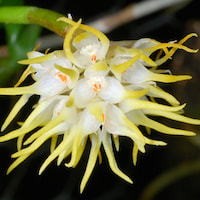
|
Bulbophyllum odoratissimum Chinese names: Mihuashidou Lan (small flow- ered stone bean orchid), Xiaohaoshi Ganlan (small stone olive), Shimi (stone rice); Mitoushidou Lan (dense head stone bean orchid) Medicinal name: Guoshangye (leaves on fruit); Xiaoguoshangye (small Guoshangye); Shicuanlian (rock string lotus) Myanmar name: Thazin hmwe Distributed China and Tibet, to Nepal, Bhutan, Sikkim, Laos, Vietnam, Thailand and Myanmar. In China, it flowers from April to August; Myanmar, April to June; Bhutan, May to September; Nepal, April to August; and in Thailand, May to July. The flowers smell sweet and very nice. Herbal prescriptions:
Compounds extracted:
|
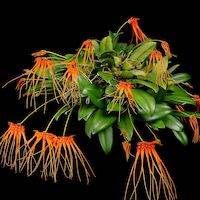
|
Bulbophyllum pectenveneris Chinese name: Huanghuajuanban Lan (yellow flower folding petal orchid), Huanghuashitou Lan (yellow flower stone bean orchid) The whole plant is supposed to have ability to improve circulation and to stop pain in the joints, muscles and bones. |
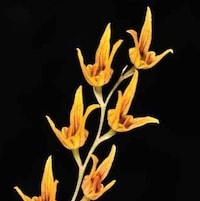
|
Bulbophyllum reptans Chinese name: Fushengshidou Lan (conceal life stone bean orchid); Baihuashidou Lan; Shidou Lan Chinese medicinal name: Shilianzi It enriches yin, and helps in clearing phlegm. It also improves appetite, helps digestion, relieves dry throat. Several phenanthrenes have been isolated including coelonin, flavanthrin, confusarin, gynopusinblestriarene A (flavanthrin), cirrhope- talanthrin, reptanthrin and isoreptanthrin. |
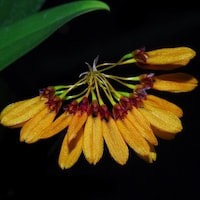
|
Bulbophyllum retusiusculum Chinese name: Yellow Comb Orchid Thai name (in Ubon Rachthani): Ma tak khok Widely distributed from Hunan, Taiwan, Hainan, Sichuan and Yunnan southwards to Myanmar, Thailand, Indochina and Peninsular Malaysia, to Nepal, Sikkim and Bhutan. Thai herbalists use the whole plant to make a tonic . |
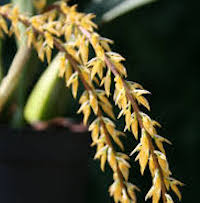
|
Bulbophyllum rufinum Thai names: Ma tak khok, Ueang kip ma ya, hang krarok, om hin (in Ubon Rachthani) In Thailand, the entire plant is used as a tonic and to treat asthma |
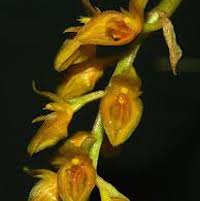
|
Bulbophyllum sterile Also Bulbophyllum nilgherrense Wight; Cirrhopetalum neilgherrense (Wight) Wight,; B. rosemarianum Leaf and pseudobulb extracts of B. sterile inhibited the growth of five strains of bacteria, namely Escherichia coli, Staphylococcus aureus, Bacillus pumilus, Pseudomonas aeroginosa. Tubers of this orchid are eaten for good health by the Valmikis tribe of India. |

|
Bulbophyllum umbellatum Syn. Cirrhopetalum maculosum. It is distributed in the western Himalayas and Thailand. Cirrhopetalanthrin, a dimeric phenanthrene derivative, has been isolated from the orchid. It is used as swarna jivanti in Ayurvedic preparations The roots of the orchid are said to promote longevity . |
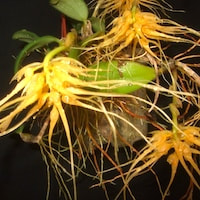
|
Bulbophyllum vaginatum Syn. Cirrhopetalum vaginatum Malay name: Magrah batu (stone orchid) It is a common lowland orchid and in Singapore, their favourite place are on the Rain Tree, along roadside. In Malaysia, it is found on old Angsana, Jambu Laut and few other trees. Flowering is triggered by a sudden drop in temperature generally after a rainstorm. Phytochemistry: 21 phenanthrenes, dihydrophe- nanthrenes, bibenzyls, phenanthrofuran and other aromatic compounds were extracted. It has 4 unique chemicals which have not been found in other Orchids. One such unique compound is a very complex molecule, phenanthro(4,3-b)furan. Bulbophyllums are rich in phenanthrenes and stilbenoids. 18 different chemical compounds from 6 species of Bulbophyllum Scientists believe that phenenthrenes from Bulbophyllum should be investigated for antitumour activity. Herbal Usage: In Malaya, juice from the roasted pseudobulb of this orchid was dropped into the ear to treat earache. In China and Nepal it is used to treat respiratory infections and fractures. Zhongyao Da Cidian mentions 5 prescriptions to treat various conditions associated with inflammation. In each case, it is used in combination with other herbs. In Myanmar, women prepare a hair tonic and shampoo by mixing ground Bulbophyllum with pulverised bark, seeds and fruit to make a sticky fluid used when washing their hair. This is to cure dandruff, promote hair growth and improve hair colour. |
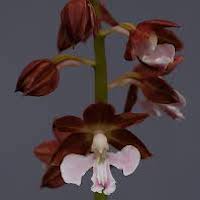
|
Genus: Calanthe Brown Calanthe, commonly called Christmas orchids, is a genus of about 220 species. Chinese name: Xiaji Lan (prawn spine orchid) Japanese name: Ebine They are terrestrial plants with thick roots, small oval pseudobulbs and large corrugated leaves. The sepals and petals are narrow and a similar size to each other and the labellum usually has spreading lobes. Calanthe are sympodial orchids with short stems and several plicate, elliptical leaves that are spirally arranged, or arranged in two rows, ensheathing the stem. Inflorescences arise at the side or from the base and carry many showy flowers on a short raceme. Calanthe is the first orchid species to be artifi- cially hybridised by man. Calanthe, was derived from two Greek words, kalos(beautiful) and anthe (bloom), meaning ‘beautiful flower’. |
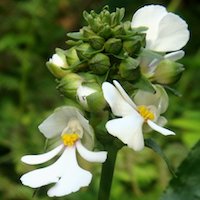
|
Calanthe alismifolia Lindl. and Calanthe nigropuncticulata Fukuyama Chinese names: Zexiexiaji Lan, Xidiangenjie Lan Taiwan: black- spotted Calanthe; white flower Calanthe Chinese medicinal name: Zongyeqi Plants are harvested in summer and autumn, washed clean and sun-dried for future use. For consumption, decoction is made with 6–12 g of the whole dried plant. The herb is acrid, bitter and considered cool in nature. In Traditional Chinese Medicine the whole plant is considered antipyretic. It is believed to detoxify, remove gas, reduce stasis of blood and reduce swellings. It also improves blood circulation, and heals ulcers and traumatic injuries. |

|
Calanthe alpina Hook Syn. Calanthe fimbriata Franch. Chinese name: Liusuxiaji Lan (tassels prawn spine orchid) Medicinal names: Mayaqi (horse teeth seven). The name is same as Calanthe davidii; Jiuxilian (nine son lotus), Daxiancao (large divine herb) Herbal Usage: It is prescribed for stomach ulcer, acute distension of the stomach, hepatitis, scrofula, toothache, sore throat, common colds, painful joints, fatigue, snake bite, and traumatic and chest injuries. Roots and stem are used to remove “heat” and toxins, relieve pain, and dispel “wind” or to hasten the disappearance of ecchymosis. It can be used in three ways- 1- in decoction, using 15–30 g fresh herb 2- in decoction, treat chronic pharyngitis, 30 g together with Ba zhao long 60 g 3- as a paste for external application, just grinding a suitable amount of Mayaqi The herb is collected in summer from Hebei, Shanxi, Hunan, Hubei, Guizhou, Yunnan and Sichuan. |
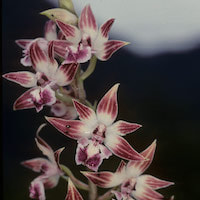
|
Calanthe brevicornu Lindl. Syn. Calanthe lamellosa Rolfe Chinese name: Shenchunxiaji Lan (kidney lips prawn spine orchid) Herbal Usage: CHM employs the root to counter ‘heat’, promote diuresis, arrest bleeding, reduce swelling, and to treat nephritis or the presence of blood in the urine. It is usedused to promote expul- sion of an incompletely delivered placenta, recov- ery after a stillbirth, or to stop abdominal pain caused by ‘poor air’ It flowers from May to June. It is distributed from northeast India, Bhutan and Nepal to Xizang, Yunnan, Sichuan, Hubei and Guangxi in China. Flowers smell like cinnamon. |
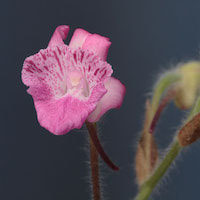
|
Calanthe cardioglossa Schltr. Thai names: Ueang namton, Uang liam Flowering season is November to February and it is distributed in northern, northeastern, eastern and southern Thailand and in Laos and Vietnam. Herbal Usage: The stem is used as a tonic in Thailand. |
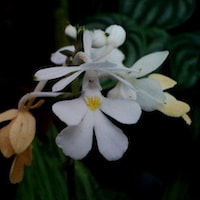
|
Calanthe ceciliae Rchb. f. Malay name: Sebueh The species is distributed in Assam, Thailand, Peninsular Malaysia Sumatra and Java. Herbal Usage: Mr. Burkill (Singapore) reported that in Sumatra the flowers were used as a poultice to relieve the pain of ulcers. |

|
Calanthe davidii Franch. Chinese name: Jianyexiaji Lan (sword leaf prawn spine orchid) Changyegenjie Lan Chinese medicinal name: Mayaqi (the name is shared with Calanthe alpina) Description: Flowers are numerous, crowded, randomly orientated. It is distributed from India across southern China to Taiwan and southern Japan. It is probably seriously endangered or extinct in the Himalayas now. Herbal Usage: Herb (Mayaqi) refers to both C. alpina and C. davidii. They are used in range of Chinese Herbal Medicine . |
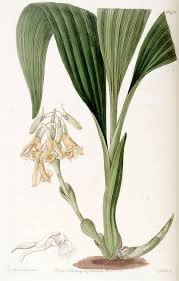
|
Calanthe densiflora Lindl. Chinese name: Zhuyegenjie Lan (bamboo leaf segmented root orchid), Mihuaxiaji Lan (prawn spine flower orchid) It is a terrestrial herb found in shaded hardwood forests of southern Himalayas, China, Indochina and Japan. In Taiwan, it is found below 1500 m throughout the island. It is the last Calanthe to flower in Taiwan, flowering from October to December. Herbal Usage: Taiwanese Chinese Herbal uses whole plant to improve blood circulation, and reduce stasis of blood and swellings. It is also used to remove gas and humidity and to treat rheumatism, backache, pain affecting the lower limbs, running sores and traumatic injuries. |

|
Calanthe discolor Lindl. Chinese names: Xiaji Lan (prawn spine orchid) Chinese medicinal names: Jiuzilianhuancao (nine united sons flowering herb)—this name also refers to Calanthe tricarinata; zhu chuan zhu (string of beads); ye baiji (night white chicken); Roulainhuan (meat in circles); Jiujiechong (nine segment bug); Yichuanniuzi (string of buttons). Phytochemistry: 4 compounds found in this orchid improve blood flow through the skin and promoted hair growth. These are - calanthoside (indole, S,O-bisdesmoside), glucoindican, calaliukiueno-side, calaphenanthrenol. It also has tryptanthrin, indirubin, isatin and indicant. Herbal Usage: Herb is obtained from Huadong (in Guangdong Province). It is used to dissolve extravasated blood and improve circulation. Entire plant, roots and stem are used to improve blood flow, and to heal abscesses, scrofula, rheumatism, bone pain and traumatic injuries. It is also used to treat skin ulcers and haemorrhoids. |
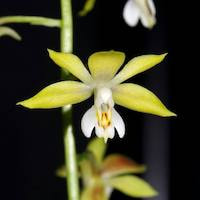
|
Calanthe graciliflora Hayata Syn. Calanthe hamata Hand. Mazz Chinese names: Goujuxiaji Lan (splayed hooks prawn spine orchid), Xiyegenjie Lan (fine leaved, segmented root orchid), Xihuagenjie Lan (fine flowered, segmented root orchid), Zhihuagenjie Lan (brocade flower segmented root orchid), Goujuxiaji Lan(hooked prawn spine orchid) in Taiwan: slender flower Calanthe Chinese medicinal name: Silima Herbal Usage: In Taiwan, the entire plant is used to relieve fever and for detoxification. It boosts yin elements, benefits the lungs, improves blood flow, reduces stasis of blood, detumescence, and stops pain and coughing. On the mainland, the entire plant is used to treat rheumatism, bone pain, traumatic injuries. |
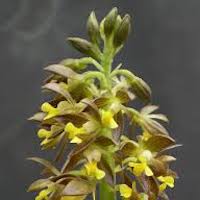
|
Calanthe mannii Hook Chinese Name: Xihuaxiaji Lan (Small Flowers Prawn Spine Orchid) In Chinese herbal medicine, C. manii is used for stomach heat, scrofula and abscess. |
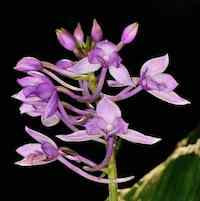
|
Calanthe masuca (D. Don) Lindl. Syn. Calanthe sylvatica (Thou.) Lindl. Chinese names: Changjuxiaji Lan (long spur prawn spine orchid), Zihuaxiaji Lan (purple flower prawn spine orchid), Shankala, Shanzhizhu (mountain spider) Myanmar Name: Thazin gyi myo kywe Nepali Name: Pakha phul Description: This was the parents of the first hybrid orchid to be bred by man. This is a highly variable. Plants from the Chinese mainland are larger. Nepalese plants have flowers of deep violet. Flowers in Bhutan are violet to purple. Herbal Usage: Herb is obtained from Fujian, Jiangxi, Yunnan, Hunan, Guangxi, Guangdong and Xizang. The entire plant is used as an ano- dyne. It also reduces swellings, removes toxins and repairs wounded tissues, removing abscesses. In Nepal, a paste made from the stem is applied to treat dislocated bones. The flowers are used to arrest epistaxis, Pseudobulbs are also used to treat nose bleeds . |
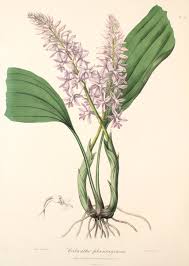
|
Calanthe plantaginea Lindl. Herbal Usage: Harvested tubers are washed, sun-dried and rendered into powder form. In Nepal, the powder is mixed with milk is consumed as a tonic and aphrodisiac |
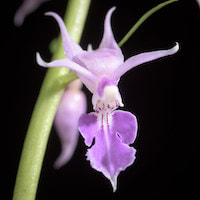
|
Calanthe puberula Lindl. Syn. Calanthe similis Schltr. Chinese names: Lianexiaji Lan (sickle lip orchid), Fanjuangenjie Lan (counter folding root segment orchid), Juanegenjie Lan (fold- ing calyx root segment orchid), Lianyexiaji Lan (sickle leaf prawn spine orchid): Jiaxiaji Lan (fake prawn spine orchid), Xiangsixiaji Lan(similar prawn spine orchid) Zigenjie Lan (purple root orchid) Chinese medicinal name: Lianexiaji Lan (sickle lip orchid) Herbal Usage: Herb is obtained from Yunnan, Guangxi and Guandong. The whole plant is used in Chinese Herbal Medicine to treat scrofula, and sores that itch. It is antipyretic and detoxifies. Used for running sores, it improves blood flow and stops pain. It is used to treat ulcers, scrofula, mange, scarlet fever, amenorrhoea, trauma and dysentery in Taiwan. |
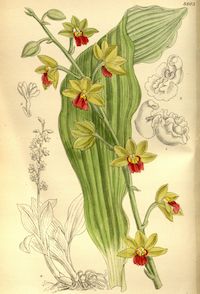
|
Calanthe tricarinata Lindl. Chinese name: Sanlengxiaji Lan (triangular prism prawn spine orchid) Chinese medicinal name: Jiuzilianhuancao (nine united sons flowering herb) This name also refers to Calanthe discolor; Roulianhuan Herbal Usage: It is found in Shanxi, Hubei, Sichuan, Yunnan, Guangxi, Guizhou and Xizang. Leaf paste is used to treat wounds and eczema in Nepal. In that country, leaves and pseudobulbs are valued as aphrodisiacs. In Uttarakhand, West Himalaya, roots and leaves are used to treat jaundice and typhoid. In China, the root is used to stimulate blood circulation, relax muscles and joints, remove wind and stop bleeding. It is used in the treatment of stomachache, arthritis, lumbar muscle degeneration and traumatic injuries. |
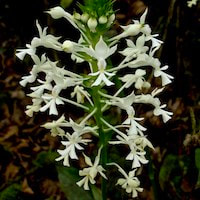
|
Calanthe triplicata syn. Calanthe veratrifolia R. Br. ex Ker Gawl. Chinese names: Sanzhexiaji Lan (three layered shrimp’s spine), Baihe Lan (white crane orchid), Shishangjiao (leaf on the stone), Roulianhuan (meaty chain of rings); Paiwan (put in order and bend in a stream), embossed banana leaf orchid Chinese medicinal name: Shishangjiao (leaf on the stone) Japanese name: Tsuru Ran Thai name: Ueang Kao Tog Indonesian names: Lau Bawang in Kalimantan Barat; Angkrek Popotjongan, Ahan Malona (Amboin); Bunga Tiga Lapis (Maluku); Guru ni Hambing (Batak Toba) Lumbu Hutan (Sumatra and Timor); Seugeundeu (Gajo Singkut in Batak Karo) Anggrek bayi tidur(Sulawesi) Phytochemistry: Leaves of C. triplicata produce indigo when bruised. Herbal Usage: In Taiwan use the root to treat rheumatism, backache and traumatic injuries including fractures. The whole plant is a diuretic. In Karnataka the roots are used for diarrhoea and toothache. In Arunachal Pradesh, the roots are an ingredient in a remedy for swollen hands, and, in a separate combination, used for treating diarrhea. Various parts of the plant are used to treat toothache. Pseudobulbs are a masticatory for a variety of gastrointestinal disorders while flowers are used to relieve toothache. Root extract is used to treat diarrhoea and toothache. Rumphius from 17th century Amboin (Sulawesi) noted that the plant was “quite sharp” and cautioned regarding its use. He said that, the taste of the roots is insipid, but suddenly it becomes quite sharp, “like some Gentiana, burning the mouth, so that one’s lips will swell, one’s throat gets hoarse, and one even feels this sharpness in the leaves, wherein it differs from all Angreks”. Back then, the roots were used together with nutmeg, cloves and two types of ginger “rubbed together and tied to” the swollen hands |
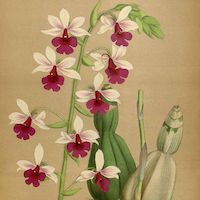
|
Calanthe vestita Wall ex Lindl. Thai name: Khao Malila Myanmar name: Thazin gyi ahphyu Herbal Usage: It reduces stasis of blood, improves blood circulation and detoxifies. In Chinese herbal medicine, it is used for swellings of different kinds- aetiology, abscess, trauma, arthritis, and painful joints. Wine fortified by the roots of some Calanthe species was reportedly used in China to treat traumatic injuries and internal bleeding. In Southeast Asia is used in Vietnam to treat rheumatism. Ayervedic use it to treat rheumatism, backache and trauma. In Amboin, the root of C. triplicata is a component of a remedy for swollen hands. In Sumatra, its flowers are used to relieve pain from dental caries. Phytochemistry: Leaves of C. vestita contain flavone C-glycosides. Herbal Usage: In Vietnam, crushed bulbs are rubbed over aching bones of people suffering from rheumatism. Six bacterial strains belonging to the genera Athrobacter, Bacillus, Mycobacterium and Pseudomonas have been isolated from the roots. Calanthe has two great benefits 1- a hair-restoring property, and 2- a possible anticancer agent. Calanthoside, glucoindican, calaliukiuenoside and calaphenanthrenol present improved blood flow through the skin and promoted hair growth. Calanquinone A from C. arisanensis exhibited potent antitumour activity against lung (A549), prostate (PC-3 and DU145), colon (HCT-8), breast (MCF7), nasopharyngeal (KB) and vincristine-resistant nasopharyngeal (KB-VIN) cancer cell lines. Calanquinone A induces s-phase arrest and apo- ptosis of glioblastoma (brain tumour) cell types A172, T98 and U87 by decreasing cellular glutathione. It also contains other calanquinones (B and C). Four new 9,10- dihydrophenanthrenes, calanhydroquinones A, B, C and calanphenanthrene A, and several other known compounds |
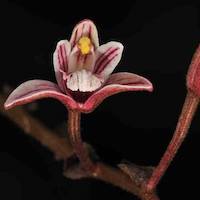
|
Callostylis bambusifolia (Lindl.) S.C. Chen & J.J. Wood Syn. Eria bambusifolia Lindl. Indian name: Mundabai The species is distributed from Vietnam, Thailand, Myanmar and southern Yunnan to northeast India down to Orissa state. Herbal Usage: The entire plant is used to treat stomach upsets in India (Dongria Kandha hill tribe). A plant of Callostylis bambusifolia(syn. Eria bambusifolia) and another of Aegle marmelos (not an orchid) are separately burnt to ashes in earthen pots, and thereafter their ash is mixed in a 1:1 ratio. Half a tablespoon is administered on an empty stomach twice a day for one week to treat hyperacidity and stomach upsets. |
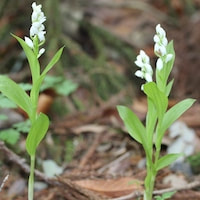
|
Cephalanthera erecta (Thunb.) Blume Chinese name: Yin Lan (silver orchid) Chinese medicinal name: Yin Lan (silver orchid) It is native to the Eastern Himalaya, China and Japan, growing amidst grasses and low shrubbery. Herbal Usage: Herb is obtained from Shanxi, Hubei, Zhejiang, Jiangxi, Guangdong and Sichuan. Plant is used to treat fever, thirst, urinary infection. It is diuretic. |
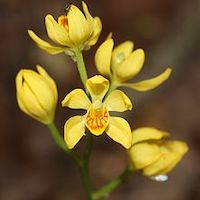
|
Cephalanthera falcata Lindl. Chinese names: Jin Lan (gold orchid), Lianyetourui Lan (pistal above sickle leaf orchid) Chinese medicinal name: Jin Lan (gold orchid) Herbal Usage: Herb is obtained from Hubei, Hunan, Guangdong, Guangxi, Yunnan and Sichuan. The entire plant is anti heat, and relieves fever. It is used to treat sore throat and toothache. |
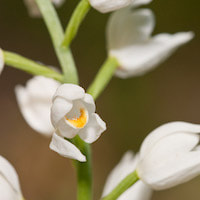
|
Cephalanthera longifolia (L.) Fritsch. Chinese names: Changyetourui Lan (pistal above the long leaf orchid), Tourui Lan Phytochemistry: Alkaloids, quercetin and kaempferol-O-glycosides are present in C. longifolia. Loroglossin is present in this Orchid. Herbal Usage: Roots and stems are used for nocturesis and enuresis in TCM. In Arunachal Pradesh, roots and rhizomes are valued as tonic. Antibiotics might be present in the mixotrophic C. falcata which is used to treat toothache and sore throat. It is on the red list of endangered orchid species. |
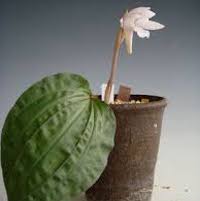
|
Changnienia amoena Chien Chinese names: Duhua Lan (solitary flower orchid) Chinese medicinal name: Changnian Lan Herb is obtained from Zhejiang, Jiangsu, Hunan and Sichuan Herbal Usage: To treat bloody phlegm, a decoction is prepared with 15–30 g of dried or 60–90 g of fresh herb, then sweetened with white sugar and drunk day and night before meals. To treat sores, a poultice is made by mixing fresh pulverised plant with salt. The whole plant together with its roots is regarded as antiheat and antitoxic. It cools the blood. It is used in the treatment of coughs, blood-streaked sputum, sores and furuncles. |
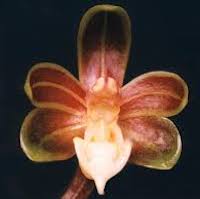
|
Cleisostoma birmanicum (Schltr.) Garay Laotian name: Ka dam phi It occurs in Hainan, Indochina, Thailand and Myanmar. Herbal Usage: The orchid was used to treat orchitis in Laos. |
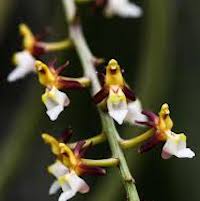
|
Cleisostoma fuerstenbergianum Kraenzl Syn. Cleisostoma flagelliforme (Rolfe ex Downie) Garay Chinese name: Changyegeju Lan (long leaf separate distance orchid) Thai names: Kloi nam thai in Ubon Ratchathani; kang pla Herbal Usage: Herb is obtained from Hainan and Yunnan. The whole plant is used as a remedy for heat and toxins, sore throat and tonsillitis in China. Leaves are used to treat diabetes in Thailand. |
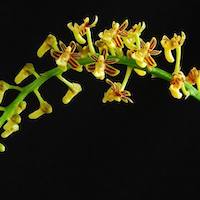
|
Cleisostoma paniculatum (Ker-Gawl) Garay Local names: big centipede orchid; tiger stripes; Taiwan centipede; purple stripes The species is distributed from Taiwan southwards to Fujian, Hong Kong, Vietnam, north- eastern and central Thailand and northeast India Herbal Usage: The entire plant is used to boost yin, treat coughs and to strengthen the lungs in Taiwan. |
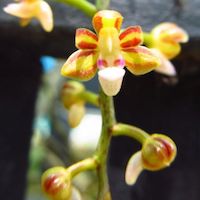
|
Cleisostoma tenuifolium (L.) Garay Common name: delicate leafed Cleisostoma Old Malabarese name: Mau Tsjerou Maravara, Ambo keli; Kolli Tsjerou Mava-maravara, Abo-tia Herbal Usage: It is used in western peninsular India to treat kidney disorders, leucorrhoea, gonorrhoea and scalds. Made into a poultice, Kolli Tsjerou Mava- maravara was used to reduce pain and swelling of abscesses and to promote their rupture. Plant was also blended in vinegar and administered to expel kidney stones, treat dysuria, gonorrhoea, other forms of white vaginal discharge and heavy menstrual loss. |
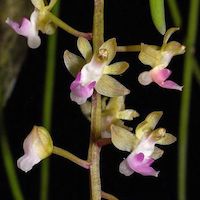
|
Cleisostoma williamsonii (Reichb. f.) Garay Syn. Cleisostoma hongkongense (Rolfe) Garay Common Name: Dianmiangeju Lan (Yunnan - Myanmar separate distance orchid) Chinese medicinal name: Longjiaocao Taste is mildly sweet and sour, and it is neutral in nature. It is mildly sweet and sour in flavour, neutral in nature. Herbal Usage: The Chinese herb is obtained from Guangdong, Guangxi and Yunnan throught out the year. It is sometimes dried for future usage. Plants can be harvested throughout the year. They are washed and sun-dried. The whole plant is used to improve blood circulation, relax muscles and joints, clear phlegm and stop coughs. It is used in treating pulmonary tuberculosis, viral encephalitis, stroke, polio, backache and indigestion in children. It simulates circulation, relaxes muscles and joints, stops coughing and is an expectorant. A Guangxi Materia Medica mentioned that it was used during epidemics of encephalitis B and to treat patients with tuberculosis or paralysis resulting from stroke or poliomyelitis, and malnourished children. |
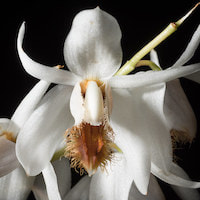
|
Coelogyne barbata Lindl. ex Griff. Chinease name: Xuchunbeimu Lan (beard and lip pearl shell orchid), Ranmaobeimu Lan Chinese medicinal name: Fengian 1- Decoction, use 15–30 g of plant. It is used for cough (lung heat), sore throats, Pain associated with hernia or scrotal swelling. 2- For external use: an appropriate amount, pulverise and apply. The paste is used on Bruises and Sprains, Chapped hands and feet. |
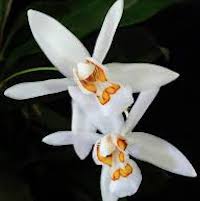
|
Coelogyne corymbosa Lindl. syn Pleione corymbosa (Lindl) Kuntze Chinese name: Yanbanbeimu Lan (eye spotted pearl shell orchid), Beimu Lan (pearl shell orchid), Zhixueguo (haemostatic fruit); Shibajiao (stone palm leaves); Duiyeguo (fruit with a pair of leaves); Xiaoluji (small green Chinese elder) Chinese medicinal name: Beimu Lan (pearl shell orchid); Guoshangye (leaves above the fruit) Newari name: Tuyu kenbu swan Herbal Usage: Herb is obtained from Yunnan and Xizang. It may be collected at any time of the year. Pseudobulbs or entire plant are used to treat fractures and soft tissue injuries. The herb is used as a haemostatic and to relieve pain. It reduces heat, stops coughs, and is taken for coughs, flu and bronchitis. Four common prescriptions are: For bronchitis, flu - entire plant can be used. 15–30 g in decoction For soft tissue injuries- Use sheaths from base of pseudobulbs. Apply as powder or paste externally. Fractures- Grind Coelogyne corymbosa 100 g with Pteris multifidapoir 1 g. Apply to site of fracture after reduction and splinting. Then add Man Shan Xiang powder to wound directly and apply another layer of the mixture. Change medicine daily or on alternate days Bleeding from external wounds- Apply powdered, or a paste of grounded, fresh Coelogyme corymbosa to the wound |
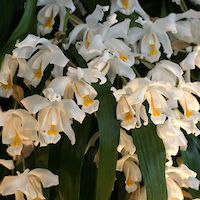
|
Coelogyne cristata Lindl. Coelogyne speciosissmum D. Don Chinese name: Beimu Lan (pearl shell orchid). Note that this name does not distinguish it from the preceding species. Indian name: Hadjojen (bone joiner) Nepali names: ban maiser, jhyanpate in Chepang dialect; chandi gabha (Nepali), syabal (Tamang) Distributed throughout Nepal, Bhutan and north- ern India, Bangladesh, Tibet and Myanmar. Phytochemistry: Ethanolic extract of cristata is strongly bacteriostatic against Staphylococcus aureus and moderately against Escherichia coli . Coelogin and coeloginin, and two novel 9,10-dihydrophenanthrene derivatives, coeloginanthridin and coeloginanthrin, were isolated from air-dried, finely-ground whole plant. 4 compounds possess the biological activities of phytoalexins and endogenous plant growth regulators. Modern research support the notion that the folk tradition of using C. cristata to treat fractured bones in the Kumaon region of Uttarakhand may have a rational basis. Herbal Usage: Hadjogen (means bone joiner) is used in the Himalaya to treat fractured bones in animals. It is used to treat dysentery and diarrhoea in Myanmar. In Nepal an infusion of pseudobulbs is used to correct constipation. Nepalese also use this orchid as an aphrodisiac. Juice squeezed from the pseudobulbs is applied to boils and to wounds on the hooves of animals. |
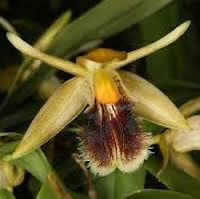
|
Coelogyne fimbriata Lindl. Chinese name: Liusubeimu Lan (tassels pearl shell orchid) Myanmar name: Ngwe hnin phyu myo kywe Herbal Usage: Herb is obtained from Hainan, Guangdong, Yunnan and Xizang. In Chinese herbal medicine, the whole plant is used to reduce heat. |
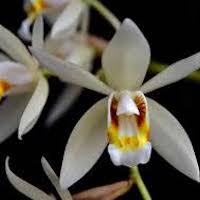
|
Coelogyne flaccida Lindl. Chinese names: Lilinbeimu Lan (chestnut scales pearl shell orchid), Guishangye (the leaf above fruits) Chinese medicinal name: Jidatui Nepali name: Thur gava Phytochemistry: Phenanthrenes and stilbenoids have been isolated from this orchids - flaccidin, soflaccidin and isooxoflaccidin. Herbal Usage: Herb collected from Guizhou and Yunnan is a popular medicine among the minority tribes in both provinces. In China, the whole plant is used to clear heat, counter dryness, promote the production of body fluids, and to clear phlegm and stop coughs. Pseudobulbs are made into a paste in Nepal and applied to the forehead to treat headache, while the juice treats indigestion. |
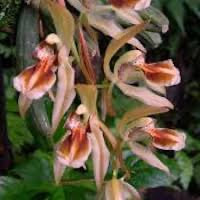
|
Coelogyne fuscescens Lindl. Chinese name: Hechunbeimu Lan Thai names: Sing to, phaya rat, phao hin Herbal Usage: The whole plant is considered aphrodisiac in Thailand.Stems are also used to treat burns and otitis media. In Nepal, abdominal pain is treated with juice extracted from pseudobulbs or a poultice made with it. |
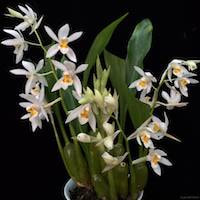
|
Coelogyne leucantha W.W. Sm. Chinese name: Baihuabeimu Lan (white flower pearl shell orchid) Herbal Usage: Herb is obtained from Yunnan. Pseudobulbs and sometimes the entire plant is used to lessen heat, stop coughs, improve blood flow, reduce pain, promote the union of fractured bones and repair torn tendons. |
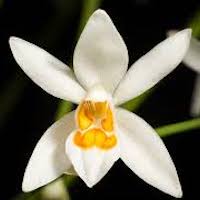
|
Coelogyne nitida (Wall ex D. Don) Lindl. Syn. Coelogyne ochracea Lindl. Chinese name: Mijingbeimu Lan Nepali names: Silver Orchid in English, bhyanpat (Chepang), Salida, Sanit (Gurung), Chandi gabha, para phul (Nepali) Phytochemistry: Ochrolide, a phenanthropyrone, and Ochrone A, 9.10-dihydro-1,4-phenanthraquinone together with coelonin are present in this orchid. Also a ochrolic, a monomeric phenanthrene derivative and a precursor to phenanthropyrones, was isolated. Herbal Usage: Juice of the pseudobulb is recommended for stomach ache in Nepal. |
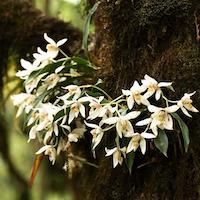
|
Coelogyne occultata Hook. f. syn Pleione occulta (Hook f.) Kuntze Chinese name: Luanyebeimu Lan (ovate leaf pearl shell orchid) Chinese medicinal names: Luanyebeimu Lan (ovate leaf pearl shell orchid); Youguashihu (squashed epiphyte) Usage: Herb is obtained from Yunnan and Xizang. It nourishes yin, protects the kidney, nourishes the stomach and promotes the production of body fluids. Plant is used to treat hot flushes, fever, nocturnal emission, backache, anorexia and gastritis. |
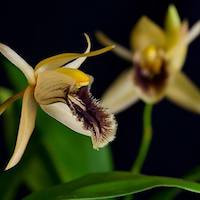
|
Coelogyne ovalis Lindl. Chinese name: Changlinbeimu Lan Indian name: Jeevanti Phytochemistry: Lot of molecules are present, namely- 2,7-dihydroxy-3,4,6- trimethoxy-9,10-dihydrophenanthrene, coelogin, coeloginin, flavidin, flavidinin, batatasin III, imbricatin, beta-sitosterol and its glycoside and a new bibenzyl compound, 30-o-methylbatatasin III. Flavidin and coelogin showed spasmolytic activity. Flavidin produced 50% and 90% inhibition of barium chloride-induced spasm of the guinea pig. Herbal Usage: It is known as Jeevanti which means ‘promoting life’, and in this respect it is used as a tonic. In Nepal, pseudobulbs are regarded as aphrodisiacs, hence the name Jeevanti. It is also used in western and southern India to treat coughs, urine infections and eye disorders. |
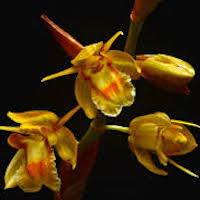
|
Coelogyne prolifera Lindl. Syn. Coelogyne flavida Hook. f. Chinese name: Huanglubeimu Lan Nepali names: Liso in Gurong dialect, Thurgaujo (Nepali) Phytochemistry: Flavidin, 9,10- dihydrophenanthrene derivative, has been isolated. Four related compounds, flavidinin and oxoflavidinin a 9,10-dihydrophenanthropyran named flaccidin and imbricatin are also present in the orchid. Herbal Usage: Paste made with pseudobulbs of C. prolifera is rubbed on the back to relieve backache and to treat boils in Nepal. |
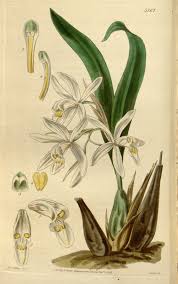
|
Coelogyne punctulata Lindl. Usage: Pseudobulbs are dried and made into powder for use to treat wounds and burns in northern India. It is used to treat dry coughs and bleeding resulting from trauma in Vietnam. |
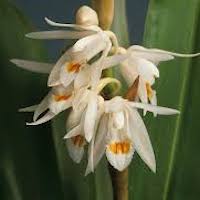
|
Coelogyne stricta (D. Don) Schltr. Syn Coelogyne elata Lindl. Indian name: Harjojan Phytochemistry: A 9,10- dihydrophenanthropyrone and a 9,10- dihydrophenanthrene named coelonin was obtained from this orchid. The phytoalexins exhibit bacterostatic and fungistatic activities. Usage: In northeast India, it is used to promote healing of bones and is applied externally to fractured limbs. Poultice made with pseudobulbs is applied to relieve headache and fever in Nepal . |
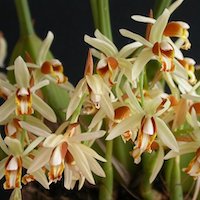
|
Coelogyne trinervis Lindl. Thai name: Ueang mak It is sacred in some parts of Indonesian Borneo (Kalimantan) and here it was believed that the abundance of the rice harvest could be predicted by seasonal profusion of its flowers. Herbal Usage: In Thailand, the tuber is used to treat fractures and sprains. It is used to treat dysentery and diarrhoea in Myanmar whereas infusion of its pseudobulbs is used to treat constipation or indigestion in Nepal. This suggests that the pseudobulbs of the orchid may contain heat-labile and heat-stable compounds with opposing actions, as is the well-known case with Angelica sinensis. C. cristata contains coelogin (a 9,10-dihydrophenanthrene derivative) which has been shown to reduce intestinal spasms. The observation supports the Burmese herbal usage of the orchid. C. cristata is sometimes used to treat headache and fever in Nepal. Three species of Coelogyne are regarded as aphrodisiacs. Uniflorin, a steroidal ester, 4 phenanthrene derivatives, coelogin, coeloginin, coeloginanthridin and coeloginanthrin were extracted from this plant. The last four compounds possess the biological activities of phytoalexins and endogenous plant growth regulators. |
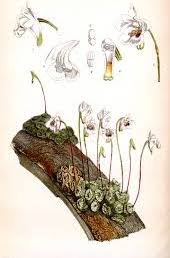
|
Conchidium muscicola (Lindl.) Rausch.Syn. Eria muscicola (Lindl.) Lindl. Sanskrit Name: Jivanti Herbal Usage: The Sanskrit word Jiva means ‘life’ and the term Jivanti is used for many herbs which are considered to be powerful tonics possessing rejuvenating and life- prolonging properties. They also act as aphrodisiacs. The pseudobulbs are used in India to treat diseases of the heart and lungs, disorders of the nervous system, eye, ear and skin, facial tumours, fever and rabies. Usage in Nepal is fairly similar: it is used to treat heart, lungs and psychiatric disorders. |
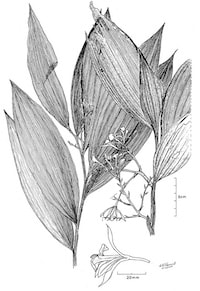
|
Genus: Corymborkis Thouars. Chinese name: Guanhua Lan The five species in this genus are widely distributed in the lowlands throughout the tropics. They are rarely cultivated because their flowers are ephemeral. |
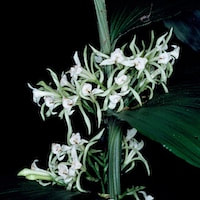
|
Corymborkis veratrifolia (Reinw.) Blume Chinese name: Guanhua Lan Malaysian name: Kayu Hok in aboriginal Semang Phytochemistry: Alkaloid is present in Corymborkhis veratrifolia. Herbal Usage: In India, juice freshly extracted from the leaves is used as an emetic. It is used to treat cuts on the feet in the British Solomon Islands. |
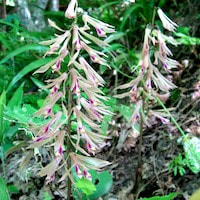
|
Genus: Cremastra Lindl. Chinese name: Dujuan Lan (Azalea orchid) The generic name is derived from Greek kremastra (flower stalk) which is the conspicuous feature of the genus. |
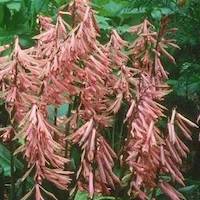
|
Cremastra appendiculata (D. Don) Makino Syn. Crematra variabilis (Blume) Nakai; Cym- bidium wallichiana Lindl. Chinese name: Mabian Lan (horse whip orchid), Dujuan Lan (Azalea orchid); Shancigu (kind mountain lady), Maocigu (kind furry lady), Sandangu (three layer hoop) Japanese: Sai-hai ran (purple orchid standard), Sanjiko Korean: Sanjago, Yaknancho Medicinal names: The Chinese Shancigu also refers to Pleione bulbocoides. It is Sanjiko in Japanese, and Sanjago in Korean. Their similarity denotes an ancient common origin. Phytochemistry: It has 5,7-dihydroxy-3-(3-hydroxy- 4-methioxybenzyl)-6-methoxychroman-4-one is the homoisoflavanone that inhibits basic fibroblast growth factor. It also inhibits inflammatory and allergic response in mast cells, and ultraviolet beam-induced skin inflammation by reducing cyclooxidagenase-2-expression and NF-kappa B nuclear localization. Tyrosine is the enzyme that promotes melanin formation, darkening of skin and UV protection. Scientists isolated several compounds , some of which can be used in cancer treatment. Herbal Usage: It was first listed as a medicinal herb in Chen Can Qi’s Ben Cao Shi Yi (Omissions from the Medica Medica) compiled around 720 AD, during the Tang Dynasty. Stem was used to treat impotence, tuberculosis, fever, frostbite, snake bites and poisoning in general. It was also used to treat abscesses and swellings. Paste made with the pseudobulb was spread over a boil to heal it. In Japan, the Ainu chew on a pseudobulb of C. appendiculata to relieve a toothache. They also use it to treat snake bites and insect bites |
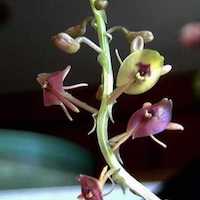
|
Crepidium acuminatum (D. Don.) Szlach. Syn. Malaxis acuminata D. Don., Microstylis wallichii Lindl. Indian names: Jeevak in Hindi, Jivak (Tamil), Jivakam (Malayalam), Jivakam (Tekugu, Jivakamu (Kannada), Jivaka (Sankrit): Lahsunia(vernacular name in Kumaun Himalaya) Ayurvedic names: Jivak, Rishvak, Rishbhaka, Bandhura, Dhira, Durdhara, Gopati, Indraksa, Kakuda, Matrika, Visani, Vrisa, Vrisnabha Pseudobulbs are used to treat bleeding disorders, fever, tuberculosis and a sensation of heat, emaci- ation, dysentery, rheumatism and insect bites. It is incorporated into the Ayervedic tonic “Chyavanprash”, a popular herbal preparation for promoting health and preventing illness . Jeevak or Jivak (C. acuminatum) features in the following formulations: Astavargha churna, Chyanprash rasayan, Chitrakadi taila, Vachadi taila, Mahakalyan ghrita, Mahamayura ghrita, Mahapadma taila, JIvaniya ghrita, Vajkaran ghrita, Brahini gutika and Himvana agada. Malaxis cylindrostachya (Lindl.) Kuntze and Malaxis mackinnoni (Duthie) Ames are some- times used when C. acuminatum is not available. Other substitutes are Pueraria tuberosa (Vidara kand), Centaurea behen (Safed behmen), Centaurium roxburghii (D. Don) Druce (or Lal behmen) and Tinospora cordifolia (Guruchi). |
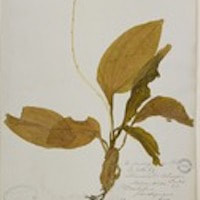
|
Crepidium resupinatum (G. Forst.) Szlach. Syn. Seidenfia rheedii (Sw.) Szlach. (see Liparis rheedii Sw.); Seidenfia versicolor Marg. & Szlach. Phytochemistry: Pseudobulb of C. acuminatum contains an alkaloid, glycosides, flavonoids, beta sitosterol, piperitone, 0-methylbatatasin, 1,8-cineole, citroenelal, euge- nol, glucose, rhamnose, coline, limonene, p- cymene and ceryl alcohol. An alkaloid, grandifoline, isolated from this orchid is a glycosidic derivative of nervogenic acid esterified with laburnine. Pseudobulb extracts of C. acuminatum contain polyphenols which possess antioxidant activity. Herbal Usage: In the western part of the Indian peninsula, a potion made with the plant is used to treat fever, biliousness and infantile epilepsy. |

|
Cymbidium aloifolium (L.) Sw. Syn. Cymbidium pendulum (Roxb) Sw. Chinese name: Wenban Lan (stripe petal orchid), Yingyediao Lan (stiff leaf hanging Cymbid- ium), Chuihuadiao Lan (pendulant flower Cymbidium), Diao Lan (hanging Cymbidium), Dabi Lan (lean-on-the-wall Cymbidium) Chinese medicinal name: Yingyediao Lan (stiff leaf hanging Cymbidium) Thai name: Ka Re Ka Ron Vietnamese Name: Kim bien Laotian names: Lung khao, Huan so pet, Kin loum, Khi mot top Indian name: Supurn in Orissa State, boat orchid; panaipulluruvi (Valaiyans in Tamil Nadu) Myanmar name: Thit tet lin nay Nepalese name: Harjor in Tharu English name: boat orchid Phytochemistry: C. aloifolium contains several phenanthrenes: aloifol I and II, coelonin and 6-methoxycoelonin, cymbinodin A, cymbinodin B a polyoxygenated phenanthrene derivative designated pendulin, and a 3,7-dihydroxy-2,4,8-trimethoxyphe-nanthrene named denthyrsinin. Herbal Usage: Leaves have anti-inflammatory and analgesic effects. In Indian traditional medicine, juice is extracted from the whole plant by pounding it with ginger and a small amount of water is used to induce vomiting and diarrhoea, or to cure chronic illness, weakness of the eyes, vertigo and paralysis . Tribes Konda of East Godavari district used the roots for treating cracks on the feet. Tribal Koyas of Khammam district used a similar preparation for setting fractures. Tribal residents at Kudremukh National Park in Karnataka use the mucilage extracted from the orchid leaves to stop bleeding from leech bites. |
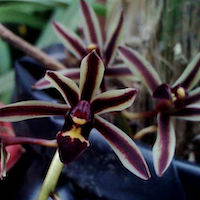
|
Cymbidium bicolor Lindl. Sri Lankan name: Visa Dhooli (Poison Dust); Beyudhuru (not specific; also used forPholidota imbricata) It is distributed from India, Sri Lanka, the Andaman and Nicobar Islands to Sumatra, Malaysia, Kalimantan, Philippines and Sulawesi. Herbal Usage: Leaves are used for treating fractures in southern China. |
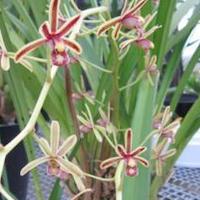
|
Cymbidium crassifolium Herb. Syn. Cymbidium mannii Rchb. Chinese name: Rouye Lan (tender leaf Cymbidium) The medicinal plant is collected from Guangxi and Yunnan. Herbal Usage: Leaves of C. bicolor are used for treating fractures. |
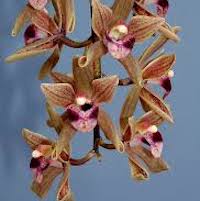
|
Cymbidium devonianum Paxton Chinese name: Fu Lan Nepali name: Thir gava Vietnamese name: Gam ngu sac The species is distributed in Nepal, Bhutan and Bangladesh, Yunnan, Myanmar, Thailand and Vietnam on mossy rocks and trees. Herbal Usage: In Nepal, a paste of the root is applied on boils. Plant is decocted until it is reduced to half. The decoction is consumed in small amounts three times a day for coughs and colds. |
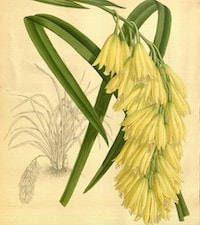
|
Cymbidium elegans Lindl. var. elegans Syn. Cymbidium longifolium D. Don. Chinese name: Suocao Lan They have numerous flowers on the rachis. Lamellae on the lip are without any appendages. Herbal Usage: Salep made with the plant is used as demulcent or emetic in India. Fresh juice extracted from the leaves is used to arrest bleeding, especially from deep wounds. |
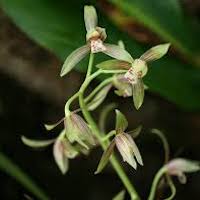
|
Cymbidium ensifolium (L.) Sw. Thai name: Chu lan Chinese names: Lan (orchid), Guo Lan (National Orchid), Gog Lan (Nation’s Orchid), Jian Lan (Jian orchid), Dajing Lan (large, lush orchid), Jinbaolisuxin Lan (golden centered, quietly elegant orchid), Suxin Lan (quietly elegant heart orchid), Guanlanhua (official orchid flower), Lancao (orchid herb, orchid grass), Shanlanhua (mountain orchid flower), Kienlan (Fukien or Fujian Orchid), four sea- son orchid, rock orchid, etc. Medicinal names: Jian lan hua (famous orchid flower); Jian lan gen; Qiu Lan (autumn Cymbidium); Ba Yue Lan (Eighth month Cymbidium); Guan Lan (official Cymbidium) It is frequently featured in Chinese paintings of the orchid that suggest grace and contentment. A standard advice to aspiring Chinese artists is to “Paint Cymbidium ensifolium when you are happy; bamboo when you are angry.”. This is the popular, fragrant Cymbidium which many oriental scholars identified with Confucius when he likened the company of good friends to a room full of fragrant orchids. The species is widely distributed throughout subtropical Asia.The herb is collected in autumn. TCM states that its taste is acrid; neutral. The entire plant is decocted and used to reinforce the body fluids, nourish blood (yin), ‘smooth the lungs’, reduce phlegm and stop coughing. It also stops pain, especially dysmenorrhoea, and corrects amenorrhoea, leucorrhoea (vaginal discharge), giddiness, coughing and haemoptysis in tuberculosis. In India, rhizomes are boiled and consumed to treat gonorrhoea. |
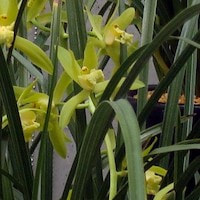
|
Cymbidium faberi Rolfe Chinese names: Jiuhua Lan (nine flower orchid), Yijingjiuhua (nine splendour flower), Tubaibu (wild hundred steps); Taiwanyijingjiuhua (Taiwan Jiuhua blossom), Hui Lan (pure heart orchid), Changye Lan (long leaf orchid), Huaqi Lan (clearing gas orchid) . In Taiwan: multi-flowered orchid Medicinal name: hua qi lan It occurs south of the Yellow River in China, in Taiwan, and in Nepal, Bhutan and northeast India. Herbal Usage: Herb is collected in autumn. After washing, leaves and roots are removed from the pseudobulbs which are sun-dried for storage. The root is bitter, sweet, mild and slightly poisonous. It is used for the relief of headache or coughs, and to destroy insects, worms and lice. A decoction is taken for headache, while 6 g in decoction is consumed with white wine once a day to relieve coughs. To clear the bowel of ascaris (round worms), 500 g of powder is added to wheat powder and made into buns. These are consumed over 3 days. |
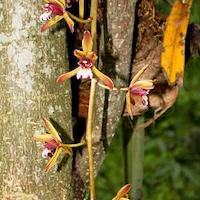
|
Cymbidium finlaysonianum Lindl. Malay name: Sepuleh Thai name: Ka Re ka Ron Pak Pet Phytochemistry: 7-O-glycosides of vitexin and isovitexin was identified from C. finlaysonianum. Herbal Usage: Mr. Burkhill reported that the Malay medicine men used it to remove bewitchment in Telok Anson, in the northwest of Peninsular Malaysia. Malay name for treating illness is, sepuleh which translates as “restorative”, i.e. restoring to health. |
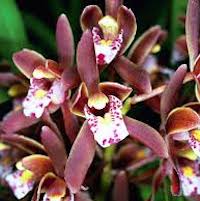
|
Cymbidium floribundum Lindl. Syn. Cymbidium floribundum Lindl. var. pumilum (Rolfe) Y.S. Wu et S.C. Chen; Cymbidium pumilum Rolfe Local name: Duohua Lan (many flowered Cymbidium) This epiphytic, occasionally terrestrial or saxicolous Cymbidium is widely distributed through central and southern China. Plants are found in at the edge of forests or on sunny cliffs and along ravines, and very rarely on rocky soil. Herbal Usage: Herb is obtained from Huadong, Huanan and Tibet. Japanese honey bees are attracted by fragrances emitted by C. floribundum which resemble compounds present in their mandibular glands. These are a mixture of 3-hydroxy octanoic acid and 10-hydroxy (E)-2-decenoic acid. |
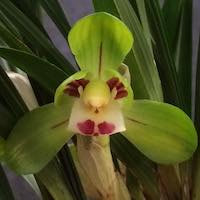
|
Cymbidium goeringii (Rchb. f) Rchb. f. Local names: Chun Lan (spring orchid), Riben Chun Lan (Japanese spring orchid), Diaolanhua (hanging orchid flowers); Cao Lan(grass orchid); Shan Lan (mountain orchid); Shuangfeiyan (twin flying sparrow) Japanese: Hokuro (black seeds/age spots); Jiji- baba (grandpa and grandma) C. goeringii is admired for its faint floral fragrance. This is constituted by a blend of methyl-cis(z)-dehydrojasmonate, (E) neroldol, 1,2,4-trimethoxybenzene, 1,2,3,5-tetramethox- ybenzene and other jasmonates . It is widely distributed throughout most of China, Bhutan, India, Korea and Japan. flowers from January to March and prefers stony habitats, shrubby slopes or sparse forests. Phytochemistry: Cymbidine A, a monomeric peptidoglycan-related compound isolated from C. goeringii, possesses diuretic and hypotensive activities. Gigantol isolated from whole plants exhibits inhibitory effects of LPS-induced nitric oxide and prostaglandin E2 (PGE2) production in macrophages. It is a potent inhibitor of tumour necrosis factor-alpha (TNF-alpha), interleukin-1beta (IL-1beta) and interleukin-6(IL-6) release, and it influences mRNA expression of these cytokines in a dose- dependent manner. These effects are produced through its ability to block nuclear factor kappa B (NF-kappaB) activation. Herbal Usage: According to TCM, roots improve blood flow, cool the blood and detox- ify. The herb is used to treat traumatic injuries, bleeding from such injuries, and fractures, clear heat in the lungs, and relieve coughs and sore throat, stop the production of blood streaked phlegm, and treat haematuria and rabies. The entire plant is used to treat fever, large round worm infestation (ascariasis), abdominal colic associated with worm infestation, poor health, weak kidneys, dizziness, backache, sweating and piles. |
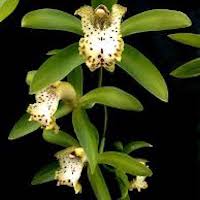
|
Cymbidium hookerianum Rchb. f. Chinese name: Hutou Lan Chinese medicinal name: Hutou Lan It flowers from February to May in Bhutan; January to April in China. Herbal Usage: Seeds are applied on cuts and injuries as a haemostatic in India. The Chinese herb which consists of the whole plant obtained from Yunnan is used to treat fractures and traumatic soft tissue injuries. |
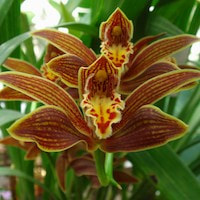
|
Cymbidium iridioides D. Don Syn. Cymbidium giganteum Wall ex Lindl. Chinese name: Huang chan Lan Phytochemistry: C. iridioides contains a triterpene glucoside, cymbidoside and a taraxerane triterpenoid, taraxerone, gigantol and sitosterol. Taraxerone was inactive against leukaemia, or renal and ovarian cancer cell lines. Herbal Usage: In Nepal, juice from the leaves of C. iridioides is used as a haemostatic on wounds. In the Khasi Hills in India, leaf juice is used to stop bleeding from wounds and for diarrhea. |
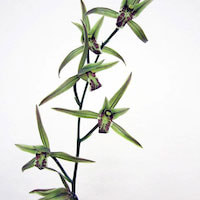
|
Cymbidium kanran Makino Local Name: Han lan (frigid Cymbidium orchid), winter orchid, Cao Lan (grass orchid) This magnificent species enjoys much popu- larity among Chinese growers on account of its elegant form and strong fragrance. It flowers from August to January but mostly in December and January. Herbal Usage: Herb is obtained from Huadong, Huanan and Yunnan. Chinese herbalists employ the entire plant to “purify the heart”, smooth the lungs, or to stop coughs and asthma. Roots are used for treating gastroenteritis and ascariasis. |
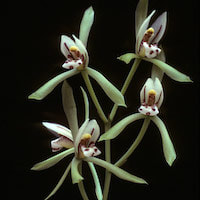
|
Cymbidium lancifolium Hook. Chinese names: Soushan Hu (searching moun- tain tiger), Zhupo Lan (bamboo and pine): Tuer Lan (rabbit ear orchid); Diqingmei(green floor plum); Xuli Cao (Through-the-ages herb, everlasting Herb). In Taiwan: white bamboo-leaf orchid. Indonesian name : Ki Adjag in Sunda It flowers in April in Hong Kong and from May to August on the Chinese mainland. This is possibly the least attractive species in Cymbidium. Phytochemistry: Saponins are present in C. lancifolium. Alkaloids are absent. Herbal Usage: In China, the entire plant is used to relieve rheumatism, improve blood flow, and to treat traumatic injuries. |
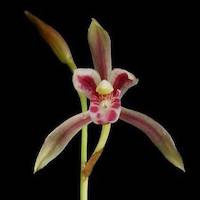
|
Cymbidium macrorhizon Lindl. It occurs along riversides, at forest margins or on open grassy slopes from southern China, Vietnam and Thailand to Myanmar and the southern Himalayas up to Pakistan. Herbal Usage: In northern India, rhizomes of C. macrorhizon are used as diaphoretic and febrifuge, and also to treat boils and rheumatism. |
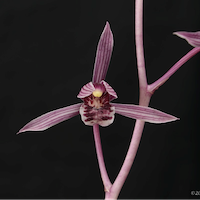
|
Cymbidium sinense (Jacks.) Willd. Syn. Cymbidium chinense Heynh. Chinese names: Baisui Lan (New Year Greeting Orchid, Pay a New Year’s Call Orchid), Baosui Lan (Congratulations for the New Year), Chun Lan (spring orchid), Mo Lan (dark orchid). Its appears from India to Myanmar, northern Thailand, Vietnam and east China to the Ryukyu Islands of Japan. In China, it has a long flowering period that extends from October to March. Herbal Usage: The whole plant or just the roots may be used. Roots are collected in autumn and sun-dried for storage. They purify the heart and lungs, and stop coughs and asthma. A decoction prepared with 30 g of the herb is used to treat dry coughs. |
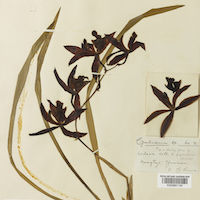
|
Cymbidium wilsonii (Rolfe ex De Cock) Rolfe Chinese names: Duanyechutou Lan (short leaf tiger head orchid), Diannanhutou Lan The lip becomes purplish-red after pollination. Flowering season is February to April. Herbal Usage: Herb is collected from Yunnan. Roots used to treat weak lungs, coughs, bronchitis, tonsillitis and body ache. Cymbidiums have been cultivated as house plants in the Far East for more than 2000 years. Ten aromatic glycosides were isolated from fresh flowers of the hybrid Cymbidium Great Flower ‘Marie Laurencin’, and two of these were new discoveries, namely marylaurensinosides D and E . An interesting group of compounds in Cymbidium are the lectins, a new class of antivirals which bind to N-linked oligosaccharide elements of enveloped viruses. Test tube experiments showed that mannose-specific lectins from a Cymbidium hybrid and Epipactis helleborine prevent human immunodeficiency (AIDS) viruses (HIV-1 and HIV-2) and cytomegalovirus (CMV) from reproducing themselves. |
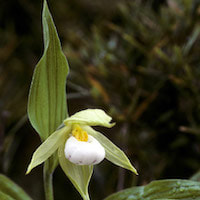
|
Cypripedium cordigerum D. Don Chinese name: Baichunshao Lan Nepali Name: Jibri Cypripedium cordigerum occurs in grassland, meadows and pine forests in central and western Nepal, southern Tibet, Bhutan, Kashmir and Pakistan. Herbal Usage: Roots are used as a tonic in Nepal. Young leaves of Cypripedium cordigerum D. Don are cooked and eaten as a vegetable . |
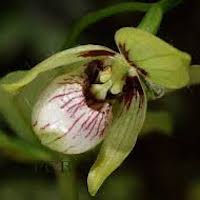
|
Cypripedium debile Reichb. f. Chinese names: Duiyeshao Lan (two leafed spoon orchid), Xiaoxipuxie Lan (small Xipu shoe orchid), Shuangyeshao Lan (two leaf spoon orchid), Erye Lan (two leaf orchid) Herbal Usage: The entire plant is used in Taiwan. It improves blood flow, reduces swelling, relieves pain and is diuretic. |
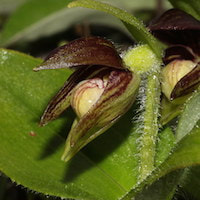
|
Cypripedium elegans, Rchb. f. Chinese name: Yazhishao Lan It is a small plant, 10 cm tall with an erect stem that is densely covered with fine, white hairs. Flowering period is June to July. Herbal Usage: In India, the root is used to treat disorders of the nervous system. It is used as a nerve tonic and also in hysteria, spasms, fits, insanity, and epilepsy, and in rheumatism in the Himalayan region. |
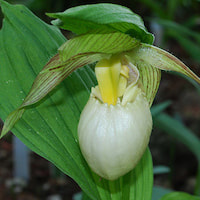
|
Cypripedium fasciolatum Franch. Chinese name: Dayezhuo Lan (big leaf spoon orchid) Chinese medicinal name: Wugongqi Herbal Usage: Herb is collected from Sichuan, Hebei and Shanxi. Roots and stems are diuretic and they are used to reduce swelling, improve blood flow, clear phlegm and stop joint pains. It is often used to treat generalised oedema, swelling of the lower extremities, fractures and other traumatic injuries. |
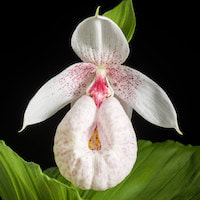
|
Cypripedium formosanum Hayata Chinese name: Taiwanshao Lan (Taiwan spoon orchid), Taiwanpuxie Lan (Taiwan ordinary shoe orchid), Yidianhong (One Spot of Red), Taiwanjiapuxie Lan (Taiwan ordinary shoe orchid) It is an endemic, terrestrial species. Herbal Usage: The entire plant improves blood flow, regulates the menses, expels gas, stops pain and relieves itching. The root and stem also expel gas, improve blood flow, and they are used to treat malaria, snake bites, traumatic injury and rheumatism. |
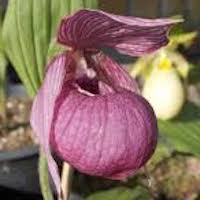
|
Cypripedium franchetii Rolfe Chinese name: Maozhuo Lan (hairy spoon orchid), Maoshao Lan Chinese medicinal name: Wugongqi It occurs in humid, humus-rich soil on shrubby slopes and sparse woods. Herbal Usage: Herb is credited with the ability to regulate the flow of vital energy (qi) to eliminate obstruction to its flow, and improve blood circulation. It is used to stop coughs, relief pain, “wind stagnation”, chest and epigastric pain. |
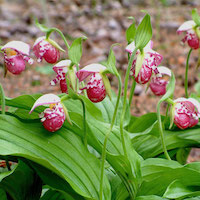
|
Cypripedium guttatum Sw. Chinese name: Zidianshao Lan Chinese medicinal name: Banhuashaolan The small pink flowers appear from May to July. It can be found in both open and shady habitats over a wide geographical. Herbal Usage: The roots and leaves have been used in eastern Russia and Siberia to treat epilepsy. |
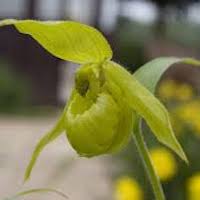
|
Cypripedium henryi Rolfe Chinese names: Luhuazhuo Lan (green flower spoon orchid); Chinese medicinal name: Longshejian (dragon tongue sword); Jinlongqi (gold dragon seven) Flowers appear in April and May and have the scent of spicy honey and attract a small black wasp, Lasioglossum sauterum. It is an elegant, endemic, terrestrial herb found in open scrub in the Chinese highlands. It thrives in damp humus-rich soil in fairly open places. Herbal Usage: Herb is collected from China’s southwest areas. Roots are used to improve qi and blood circulation, reduce swelling and pain, “cold in the stomach”, pain around the waist and thighs and pain resulting from injury. |
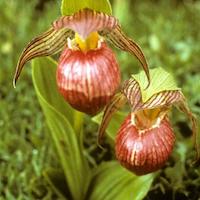
|
Cypripedium himalaicum Rolfe Chinese name: Xiaezhuo Lan (narrow calyx spoon orchid), Gaoshanshao Lan Nepali name: Khujukpa It has uneven broadly elliptic leaves and fragrant flowers with lips. Flowering season is June to August in Nepal, June to July in China. It is widely distributed from the western Himalayas through Nepal, Bhutan, Sikkim, Tibet and northern Burma. It is used in CHM to treat female infertility, hernia and pain at the waist in women. In Nepal, juice extracted from fresh plants or a drink made with dried plants are used. It is also used to treat difficulty in passing urine, urinary stones, heart and lung disease and coughs. |
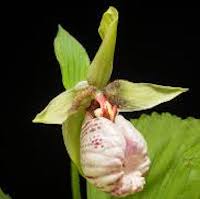
|
Cypripedium japonicum Thunb. Chinese name: Shanmaishao Lan Chinese medicinal name: Shanziqi Japanese name: Kumagiso The herb is said to dispel wind, remove toxins, moderate qi, improve blood cir- culation and relieve pain. It is used in the treat- ment of tertian malaria, menstrual irregularities, pain arising from physical injuries and pruritus. Chinese Herbal Prescriptions include: 1. Tertian malaria- Pulverizse 1.5 g of roots for consumption with cold water 1 h before onset of symptoms. 2. pruritic rash - Boil whole plants to clean the skin 3. snake bite and low backache – Mix with wine to eat and also to apply |
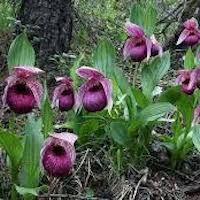
|
Cypripedium macranthos Sw. Chinese names: Qilaixipuxie Lan (big flowered spoon orchid), Dahuashao Lan (big flowered spoon orchid), Dakoudaihua (large pocket orchid) Chinese medicinal name: Dunshengcao, Wugongqi Japanese name: Atsumoriso Phytochemistry: Lusianthrin and chrysin were isolated. They are both are antifungal compounds. Herbal Usage: Chinese Herbals state that roots and stem promote diuresis, reduce swelling, clear ecchymosis, expel gas, stop pain and improve blood flow. Pulverised, dried flowers are used to stop bleeding from wounds. For oral consumption, the decoction is prepared with 6–9 g of the orchid plant and consumed with, or without, wine. |
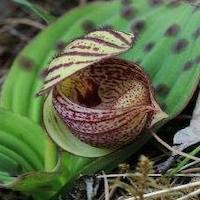
|
Cypripedium margaritaceum Franch. Chinese names: Banyeshao Lan; Chinese medicinal name: Lanhuashuangyecao It grows in deep shade and the leaves are held horizontally across the forest floor. Herbal Usage: It is used to nourish the liver and kidneys. It moderates qi (vital energy) and blood, promotes diuresis and relieves oedema, and improves blurred vision or night blindness. A commonly used folk herb in Yunnan, decoction is prepared by boiling 9–15 g of the herb. |
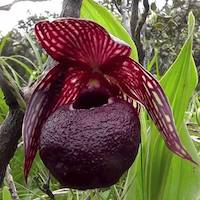
|
Cypripedium tibeticum King ex Rolfe syn. Cypripedium corrugatum Franch. Chinese name: Xizang Zhuolan (Tibetan scoop orchid) Chinese medicinal name: Wugongqi; Zhoushao Lan (crepe spoon orchid) It flowers from May to August in open forests and on grassy or rocky slopes. Herbal Usage: Herb is collected from Yunnan. Roots of C. tibeticum are thought to be anti-inflammatory and capable of preventing pain. They are used to increase urine output, relieve painful swellings, or to improve blood circulation and to treat menstrual disorders. Phytochemistry : Cypripediums are attracting lot of attention from taxonomists, gardeners and biochemists. Cypripedium has been used medicinally in western medicine in Europe and in North America. Many Cypripedium species are distributed in North America, and American Indians used roots of C.s as sedatives and antispasmodics. In US, the extract was used to treat nerve disorders and sometimes used as an aphrodisiac. Historically, in India, there is a similar usage, to treat such disorders of the nervous system as hysteria, spasms, fits, madness and epilepsy. Chinese herbalists use it to treat malaria. |

|
Cyrtosia septentrionalis (Rchb. f.) Garay Syn. Galeola septentrionalis Rchb. f. Chinese name: Xue hong rou guo lan Chinese medicinal name: Shanshanhu Japanese name: Tsuchi-akebi, Dutuusoo In the shaded and sparse understory of forests where this orchid grows, insect pollinators are limited. Hence, the orchid has adapted and has an effective self-pollinating system. Phytochemistry: Several glycosides amd 8 phenolic derivatives were isolated. These are- 1- 2,4-bis(4-hydroxybenzyl) phenol 2- Bis[4(beta-D-glucopyranosyloxy)-benzyl](S)- (-)-2-isopropylmalate 3- Bis[4-(beta-D-glucopyranosyloxy)benzyl](S)- (-)-2-sec-butylmalate 4- 4-hydroxybenzylaldehyde 5- 4,40-dihydroxydiphenyl-methane 6- 4-hydroxybenzylalcohol 7- 4-(beta-D-glucopyranosyloxy)benzyl alcohol or gastrodin 8- 5-methoxy-3-(2-[phenyl-E-ethenyl)-2,4-bis (4-hydroxybenzyl)phenol Herbal Usage: It's used to treat stiffness or spasm of the muscles. Paste made with the whole plant and vegetable oil is used for sores and fungal infection of the skin with ulceration; and fruit with liquorice and prepared in decoction for treating gonorrhea. Decoction of the root of Galeola septentrionalis was formerly used in Japan to treat gonorrhoea. Ash produced by burning the plant was used as a hair tonic for diseases of the scalp. |
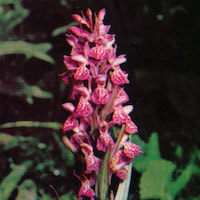
|
Dactylorhiza hatagirea (D. Don) Soo syn. Orchis latifolia Lindl. Common name: Marsh Orchid Chinese names: Kuanyehongmen Lan (broad leaf red door orchid), Hongmen Lan (red door orchid), Mengguhongmen Lan (Mongolian red door orchid), Zhanglie Lan Chinese medicinal name: Hongmen Lan (red door orchid) Indian names: Munjataka in Ayurveda, Panja, Salampanja, Salep, Salap (Hindi), Salap (Sanskrit), Salimpanja (Kashmir Himalaya), Hathazari (Uttarakhand) Nepali names: Hathejadi is the common name; Lob, Panchaunle (Gurung), Panchaunle (Nepali), Ongu lakpa (Sherpa), dbang-po-lag (Tibetan), Wonglak (Amchi), Lovha (Kham), Airalu (Sanskrit) Spanish name: Palma Christi Herbal Usage: Rhizomes of D. hatagirea are a source of salep in Turkey. They are used as expectorant, tonic, astringent and nutrient in India. Tubers are eaten raw for their aphrodisiac properties in India. In Kashmir Himalaya, it is also used in the treatment of diabetes, chronic diarrhoea, dysentery, coughs, hoarseness of voice, paralysis, impotence, and during convalescence and to correct malnutrition. In Uttarakhand and a paste made with tubers is applied on fractures. In Nepal decoction of the root is taken for stomach ache. It was considered to be highly nutritious! In Chinese herbal medicine, the entire plant is used as a cardiac stimulant. It is alleged to benefit the kidney, stomach and spleen. It relieves thirst, improves appetite and is used to treat irregular menstruation, anaemia and dizziness. |
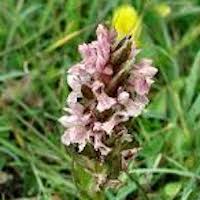
|
Dactylorhiza incarnata (L.) Soo Common name: Early marsh orchid D. incaranata grows in bogs and wet meadows from Ireland and Sweden across Europe to the Middle East, Iran and Xinjiang (China). Usage: Tubers are collected for salep in Iran but the main consumer is Turkey. |

|
Dactylorhiza romana (Schltr.) Soo subsp. georgica Herbal Usage: Tubers are collected in Turkey and Iran for use as salep. In Turkey, it is also used as a tonic, as nourishment (used in ice-cream and drinks) and to treat constipation. |
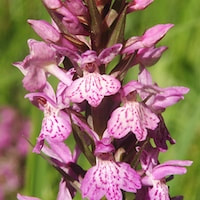
|
Dactylorhiza salina (Turez exLindl.) Soo Mongolian name: Martsnii tsakhiram Tibetan name: Ban lag In Mongolia, it is found in damp, swampy alkaline meadows in almost all natural zones. Herbal usage: Root tubers are reported as sweet and astringent. They are used to treat oedema and inflammation, to give strength and enhance life. There is a special demand for this orchid in Mongolia and it is an ingredient in several traditional Mongolian prescriptions. |
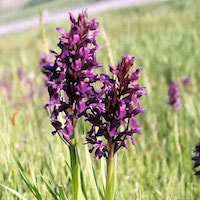
|
Dactyloriza umbrosa (Kar and Kir.) Nevski Common name: Dark Dactylorhiza Chinese name: Yin Sheng Zhang Lie Lan This is a robust species which thrives in temperate and sub-artic regions of Asia. It is also distributed in Pakistan, Afghanistan and northern Iran. Usage: It is used to prepare salep and is being harvested in Iran. |
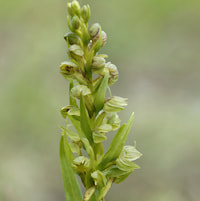
|
Dactylorhiza viridis (Linn.) R.M. Bateman, Pridgeon and M.W. Chase syn. Coeloglossum viride Hartm. Chinese names: Woshe Lan (nest tongue orchid), Luhua-woshe Lan (green flower nest tongue orchid, Nanhulinyuzi Lan (South Lake orchid), Aoshe Lan (nest tongue orchid), Shoushen (hand ginseng), Aoshezhanglie Lan Tibetan medicinal name: Wangla Alaskan name: frog orchid It's a winter orchid. In Alaska, the temperature may drop to minus 50 oC in winter, with severe desiccation during long winter months, yet the orchid survives. Phytochemistry: The functional groups of the compounds suggest that D. viride extracts may have a neuroprotective effect. Aphrodisiacal properties of D. hatagirea were studied in Wistar strain male albino rats. Rats fed the orchid had a 2.5-fold increase in attraction to females compared with the testosterone-treated. In Singapore and other parts of southern Asia, one may find the orchid among the constituents of health supplements which are marketed as revitalising, rejuvenating, or aphrodisiac. Dactylorhiza as salep is also considered to be an aphrodisiac in Iran, Turkey and the Colchis Forest area of Georgia in the Caucasus. |
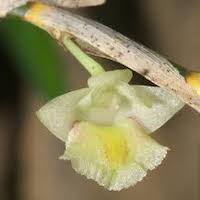
|
Dendrobium acinaciforme Roxb syn. D. spatella Rchb.f, D. banaense Gagn., Chinese name: Jianye Shihu (sword leaf Dendrobium) Thai name: Uang Takhap It is a common Dendrobium in the Chiangmai area of northern Thailand, Indochina, Myanmar, northeast India and south China (from Yunnan to Hong Kong and Lantau Island), Malay Peninsula and Malaku. Herbal Usage: The entire plant is used in TCM as a tonic during the recuperation period of an illness to eliminate fever, thirst, lassitude and malaise. This is a standard application of shihu. |
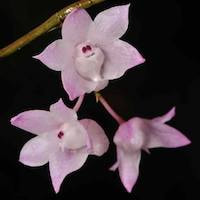
|
Dendrobium aduncum Lindl. Syn D. scorianum W. W. Smith, D. faulhaberianum Schltr. Chinese names: Gouzhuangshihu (noble hook Dendrobium), Huangcaoshihu (yellow herbal Dendrobium); Dahuangcao (large yellow herbal Dendrobium); Honglancao (red orchid herb); Jishengcao (parasitic herb) It is widely distributed from the Himalayan foothills to Kwangtung Province and Hong Kong, Lantau and Hainan Islands in southern China, southwards into Myanmar, northern Thailand and Vietnam. Herbal Usage: as Shihu. The stem is nourishing and promotes vitality. Antipyretic, it also benefits the stomach and stops thirst. It is commonly used to help patients who are weak because of illness, and those who have a poor appetite. |
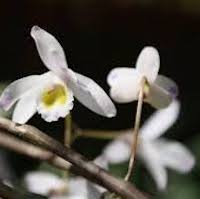
|
Dendrobium amoenum Wall ex Lindl. The species is distributed from Himalaya to Myanmar. Herbal usage: Stems are used as a tonic in Nepal. Fresh paste prepared with pseudobulbs of D. amoenum is applied to treat burns and dislocated bones. |
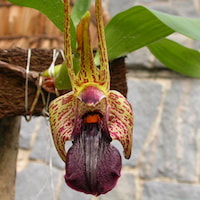
|
Dendrobium amplum Lindl. syn. Epigeneium amplum (Lindl.) Summerh. Chinese names: Kuanyehouchun Lan (broad leaved, thick lipped orchid); Guoshangye (leaves above fruit) Thai names: Kra chiang, Si thiang It is found on tree trunks and rocks in mountain forests. Herbal Usage: The whole plant is used in Chinese herbal medicine to enrich yin, stop coughs and improve blood flow. |
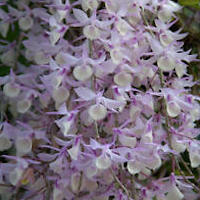
|
Dendrobium aphyllum (Roxb.) C.E.C. Fisch, syn. D. macrostachyum Lindl. Thai names: Uean sai, Ueang sai long laeng, Ueang yumai, Ueang khai nao, Ueang saimai, Ueang lawng laeng The species is widespread in continental Southeast Asia, spreading to southwest China, Sikkim and Nepal. Herbal Usage: It is used as shihu. Stems are used to prepare a tonic in Nepal. Eardrops prepared with juice of young pseudobulbs are used by the Valmikis tribe of Visakhapatnam district in Andhra Pradesh to treat earache. Dried stems are used as shihu. |
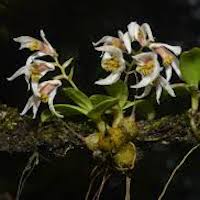
|
Dendrobium appendiculatum (Blume) Lindl. syn. Flickingeria bifida A. Hawkes; Ephemeranta bifida (Ridley) Hunt et Summerh. Chinese name: Youzhua shihu (Claw Dendrobium) It is distributed in Peninsular Thailand, Peninsular Malaysia, Sumatra and Java. Usage: The entire plant is used in TCM to enrich yin. It benefits the lungs and stops coughs. It is used to treat troublesome tuberculous cough and asthma. |
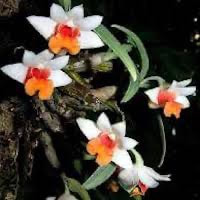
|
Dendrobium bellatulum Rolfe Thai name: Uang Sae Mon This small, epiphytic species is widespread throughout Myanmar, Thailand, Laos and Vietnam, extending to Sikkim and southern Yunnan. Herbal Usage: It is used as shihu |
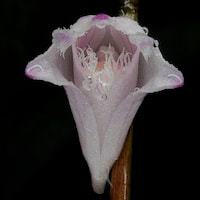
|
Dendrobium blumei Lindl. It is found in Peninsular Thailand, Peninsular Malaysia (in Perak), Java, Borneo and the Philippines. Herbal Usage: A poultice made from the pounded leaves and pseudobulbs of the orchid is applied on itching skin and eruptions for relief. |
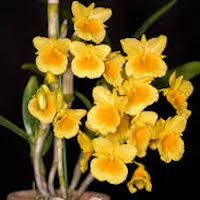
|
Dendrobium capillipes Rchb. f. Chinese name: Duanbang Shihu It is distributed from Nepal and Northeast India to Yunnan, Myanmar, Thailand, Laos and Cambodia Phytochemistry: Scoparone (6,7-dimetho xycoumarine) which is present in D. capillipes has vasodilatory effects on the rat aorta. Phytohaemagglutinin stimulates white blood cells to undergo rapid replication and the process is used in the laboratory for chromosomal analysis. Scoparone suppressed the response of human mononuclear cells. Scoparone also stimulates dopamine biosynthesis by PC12 cells which are nerve cells from a pheochromocytoma (tumour) of the rat adrenal medulla. Dopamine is an important chemical messenger of the brain. Loss of dopamine-secreting cells in the brain is thought to be a cause of Parkinson’s disease. Herbal Usage: It is used as shihu. |

|
Dendrobium cariniferum Rchb. f. Common name: Keel carrying Dendrobium Thai names: Ueang sae dong, Ueang ngoen daeng, Ueang kachok, Ueang tueng Myanmar name: Mahar deiwi Flowers are scented, white, borne singly or in pairs. Herbal Usage: as shihu |

|
Dendrobium chrysanthum Lindl. Syn Dendrobium paxtonii Lindl. Chinese name: Banchunshihu (spotted lip noble Dendrobium), Suhuashihu (bouquet Dendrobium) Dahuangcao (large yellow herb); Mabiancao (horse whip herb); Shuidabang (water trashing stick); Jin Lan (golden orchid). |
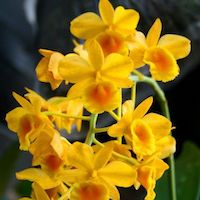
|
Dendrobium chrysotoxum Lindl. Syn Dendrobium sauvissimum Rchb. f Thai names: Uang Khan, Ueang kham Vietnamese name: Kim diep Myanmar names: Shwe tu, Mout khan war Stems are clustered, fusiform and many angled. It is distributed across Vietnam and Laos to Thailand, southern Yunnan, Myanmar and Sikkim. Phytochemistry : Erianin, a bibenzyl from D. chrysotoxum has potent anti-oxidative action in lipid peroxida- tion and hemolysis assays. It induces apoptosis in human leukemia HL-60 cells. Erianin retards the growth of xenografted human hepatoma Bel 7402 and melanoma A 375. It induces significant vascular shutdown within 4h following administration of 100 mg/kg and shows similar anti-angiogenic activities in vitro. Herbal Usage: It is used as shihu in Taiwan. D. chrysotoxum flowers are being sold in China for making tea. |
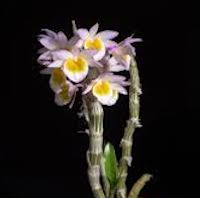
|
Den crepidatum Lindl. & Paxton Chinese name: Meigui Shihu (rose Dendrobium) Thai name: Uang sai nam khieo. Phytochemistry: 3 alkaloids, crepidine, crepidamine and dendrocrepine were isolated from D. crepidatum. Herbal Usage: In TCM, stems are used to enrich yin, benefit the stomach, and clear dry or itchy throat. Stems are used to treat fractures in Nepal. The orchid is among 199 medicinal plants used by the Hani ethnicity in the Naban River Watershed National Nature Reserve in Yunnan, China. The orchid is commonly cultivated in home gardens by the Hani whereas they usually collect other medicinal plants from the forest. |
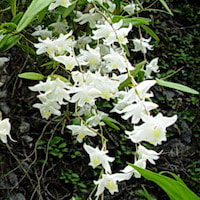
|
Dendrobium crumenatum Sw. syn. Dendrobium caninum Merrill, D. kwashotense Common names: pigeon orchid, dove orchid Malay: bunga angin (wind orchid); Daun sepuleh tulang when it is used as a protective charm (bone restoring leaf) Indonesian: Anggerik Merpati (dove orchid); Anggerik Bawang (onion orchid); Bunga Angin (wind flower) Thai: Wai tamoi; Bua klang hoa; Sae phra in; Thiam ling; Dawk mai wai, Ueang Mali Vietnamese: Tuyel mai Indian name: Jivanti The beautiful, fragrant, white Pigeon Orchid is found growing on trees in exposed places all over Malaysia and is extremely common on mature roadside trees in Singapore, even right in the heart of the city. Phytochemistry: Alkaloids are present in D. crumenatum. Herbal Usage: Juice from the crushed pseudobulbs, fresh, boiled or roasted, was dropped into the ear to treat pain caused by small abscesses, boils or other intractable swellings in the external ear (bunting telinga, Malay) in Malaysia and earache in Indonesia. A poultice made from the residue is applied around the external ear. This practice might be of Indian origin. Under the name Jivanti, it is also used for affections of the brain and nerves. Patients suffering from cholera are fed a conserve of the flowers and leaves. |

|
Dendrobium crystallinum Rchb. f. Chinese name: Hainanjinmao Shihu (Hainan Province crystal hat Dendrobium) Thai Names: Ueang sai sam si, Ueang nang fawn Myanmar Name: Setkhu pan Herbal Usage: Entire plant is used as medicine. It has a long history of usage as shihu and goes by the name, zhong huan cha. |
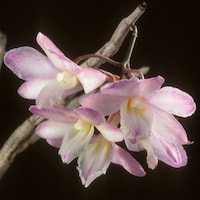
|
Dendrobium cumulatum Lindl. Thai names: Thian phaya in, thian thong, Uang sai si dok It is found Nepal, Bhutan, northeast India, Myanmar, Thailand, Indochina and Borneo. Phytochemistry: Two bibenzyl derivatives, cumulatin and tristin, were isolated from the orchids D. cumulatum and Bulbophyllum triste. Herbal Usage: Stems are used to treat asthma. |
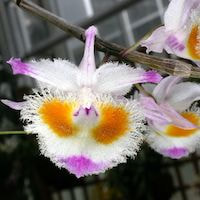
|
Dendrobium denneanum Kerr syn. Dendrobium aurianticum Rchb Chinese name: Ma pien Shihu (horse whip Dendrobium) In China, the plants are found as an epiphyte on trees in forests in Yunnan, Guizhou, Guangxi, Hainan and Taiwan. Phytochemistry: It has oxidant and immune-modulatory activities on in vitro testing. Herbal Usage: D. denneanum is used as a tonic. |
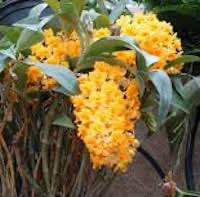
|
Dendrobium densiflorum Lindl. Syn Dendrobium clavatum Roxb. Thai names: Ueang Mon Kai Liam, Uang Min Khai Luang. Vietnamese name: Thy-tien Myanmar name: Ta khun lone shwe Nepali name: Sungabha, Sungava Herbal Usage: In India, leaves of D. densiflorum are ground into a paste with salt and applied on fractures to help set bones. Pulp of the pseudobulbs is used to remove pimples and boils in Nepal. |

|
Dendrobium denudans D. Don Lip is striped with purple. Flowering season is August to September. Herbal Usage: Pseudobulbs are eaten raw to treat fever and body ache in Darjeeling Himalaya. They are also employed to make a narcotic preparation. |
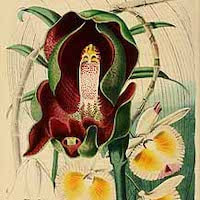
|
Dendrobium devonianum Paxton D. pulchellum Lindl. Chinese name: Chiban Shihu (teeth pedal Dendrobium) Thai names: Miang; Ueang sai man pra in, Ueang sai pha kang, Ueang sai luat Flowers appear in April or May and last a fortnight. Phytochemistry: Two out of nine compounds isolated from D. devonianum, possessed antioxidant activity. The orchid also contained a unique flavonol glycoside, 5-hydroxy-3-methixy-flavone-7-O-[beta-D- apiosyl-(1–6)]-beta-D-glucoside. Herbal Usage: As for Shihu. In Nepal, pulp of the pseudobulb is applied to boils and pimples to encourage healing. |
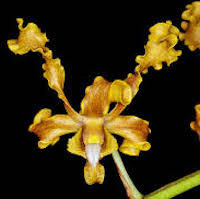
|
Dendrobium discolor Lindl. Syn. Dendrobium undulatum R. Br., D. elobatum Rupp., D. fuscum Fitzg. Common Australian name: golden orchid Papuan names: Rigo twist, Moresby gold, Bensbach yellow. Herbal Usage: In Mackay, Queensland, aborigines prepared a poultice from young canes of D. discolor and used it to draw a boil. A liniment for ringworm was prepared with the juice of old canes. |
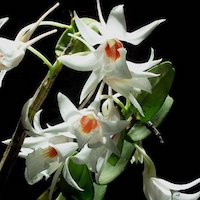
|
Dendrobium draconis Rchb.f. Thai names: Ueang ngoen, ueang ngum Myanmar Name: Kein na ri The Burmese name is probably derived from Sanskrit kinnari, a Buddhist mythical half-bird, half-human creature with a beautiful voice, referring to the delicate outspread-winged form of the white flowers; kinnari is female for kinnara. Phytochemistry: Gigantol, a common bibenzyl, was isolated from D. draconis. It is cytotoxic to several cancer cell lines. Herbal Usage: The stem is used as an antipyretic and haematinic in Thailand. |
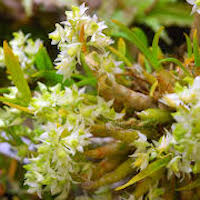
|
Dendrobium eriiflorum Griff. Herbal Usage: Dried powdered pseudobulb is used as a tonic, and paste is used to treat fractures and dislocations in Nepal. D. eriiflorum was included among 21 samples of Herba Dendrobii collected from various herbal sources, but it is not included in standard Chinese Materia Medica as shihu. |
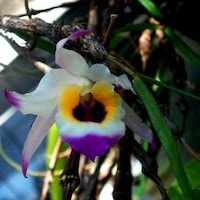
|
Dendrobium falconeri Hook.f. syn Dendrobium erythroglossum Hayata Chinese names: Xinzhushihu (Xinzhu noble Dendrobium), Honglishihu (red crane Dendrobium); Chuanzhushihu (string Dendrobium), and in Taiwan: red oriole Dendrobium Taiwanese name: Xin Zhu Shi Hu (new bamboo Dendrobium) Thai Names: Ueang sai wisut, Rot rueang saeng, Ueang mieng, ueang ya phaet. A magnificent Dendrobium with pendulous, terete, long, slender, branched and knotted stems. D. falconeri reduced protein levels of migrating human lung cancer H460 cells in a dose- dependent manner. Usage: TCM states that stem nourishes the yin elements, benefits the stomach, stops thirst and relieves the feeling of heat, dry mouth and dry throat. It is used to treat people recovering from illness or who are suffering from anorexia. |
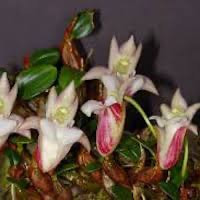
|
Dendrobium fargesii Finet. syn. Epigeneium fargesii (Finet) Gagnep Chinese names: Danyehouchun Lan (single leaf, thick-lipped orchid), Maihu (wheat Dendrobium); Guoshangye (leaf above fruit); Shiduo (stone bean); Danyeshizao (single leaf stone date); Shi Lan (stone olive) Taiwanese name: Lian Zhu Lan (chain of pearls orchid), Xiao Pan Long (coiled dragon) San Xing Shi Hu (three stars Dendrobium) Herbal Usage: The entire plant is used for clearing heat and moistening dryness. It clears phlegm and stops coughs. It is used to treat tuberculous cough, bronchitis, pneumonia, diph- theria, sore throat, gastritis, knife wounds and night sweats. |
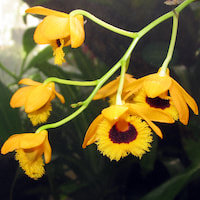
|
Dendrobium fimbriatum Hook. f. syn. Dendrobium normale Fale. Chinese names: Liusushihu (tasseled stone orchid), Mabianshihu (Mabian stone orchid) Indian names: fringed lip Dendrobium Thai name: Ueang waew mayura, Ueang kaam ta daam Herbal Usage: In TCM, D. fimbriatum is used as shihu to improve eyesight. This particular shihu polysaccharide is said to enhance T-cell and macrophage immunity, and it possesses anti-oxidant activities, enhances superoxide dismutase (SOD) and reduces lipid peroxidation. The whole plant is used to treat liver disorders and nervous debility in Nepal. The bibenzys exhibited cytotoxic activity against five human cancer cell lines. |

|
Dendrobium flexicaule Chinese name: Qujing Shihu Usage: The plant qualifies for shihu since it is a Dendrobium which is exclusively saxicolous. Discovered only in 1986, efforts are now being made to cultivate this “rare medicinal plant” by simulating its habitat at the Xixia Forestry Bureau in Henan Province. |
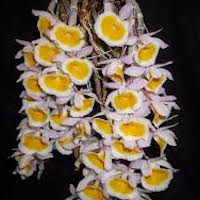
|
Dendrobium gratiosissimum Rchb. f. Thai name: King Dam Vietnamese names: Hoa thao, huang thao, Long tu Herbal Usage: It is used as shihu in Indochina. |
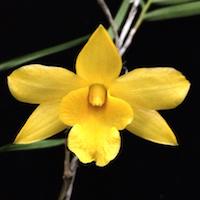
|
Dendrobium hancockii Rolfe syn. Dendrobium odiosum Finet. Common Name: Xiyeshihu (slim leaf Dendrobium) Herbal Usage: Entire plant is served in pork porridge to treat ordinary coughs and asthma. |
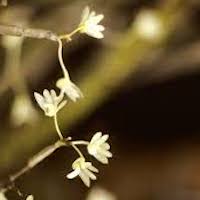
|
Dendrobium herbaceum Lindl. Chinese name: grass Dendrobium Common Indian name: Sasanga in Orissa Description: This species has the smallest flowers in the genus. D. herbaceum occurs in southern India from the Western Ghats eastwards to Orissa, Bangladesh and the Andaman Islands. Phytochemistry: Flavonoids, sugars, cyanogenic glycosides and tannins have been isolated from its leaves, but their structures and function have not been elucidated. Herbal Usage: InIndia, leaves of are pounded with an equal amount (by weight) of the young shoot of Andrographis paniculata into a paste which is applied twice a day for a week on syphilitic ulcers. After 30 min, the paste is removed and the infected part is washed with a leaf decoction of Azadirachia indica. |
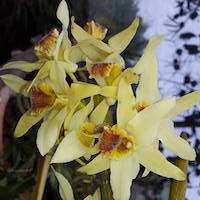
|
Dendrobium heterocarpum Wall. ex Lindl. Chinese name: Jiandaochun Shihu It is distributed from Bhutan, central Nepal to Thailand, Indo-China, Malaysia, Indonesia and the Philippines. Herbal Usage: Paste of stems mixed with wheat flour is applied on fractures and dislocations. |
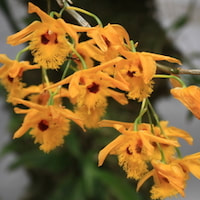
|
Dendrobium hookerianum Lindl. Chinese Name: Jiner Shihu (gold earring Dendrobium) This is one of the largest Dendrobium in terms of pseudobulb length. Flowers measure up to 10 cm across, and are among the largest in the Dendrobium genus. It occurs in central Nepal, northeastern India, Bangladesh, Myanmar, Yunnan and Xizang and China. Herbal Usage: The pseudobulbs are used to treat malaria and high fever. |
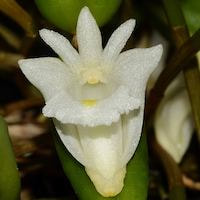
|
Dendrobium hymenanthum, Rchb.f. syn. Dendrobium quadrangulare C.S.P. Parish & Rchb. f. Description: Pseudobulbs are club-shaped, four-angled, numerous and tightly clustered. They are found in Myanmar (Tenasserim), Peninsular Thailand, Indochina, Malaysia, Kalimantan and the Philippines. Herbal Usage: Used to treat oedema in Peninsular Malaysia. |
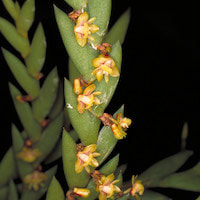
|
Dendrobium indivisum (Blume) Miq. Thai Name: Kang pla It is a tiny Dendrobium. It gorws in Thailand, Laos, Vietnam, Malaysia and Indonesia. Although this is a free-flowering species, it has no horticultural value owing to the insignificant size of its flowers. Herbal Usage: The whole plant is used to treat headache in Thailand. |
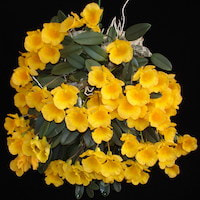
|
Dendrobium jenkinsii Wall. ex Lindl. Thai name: Ueang phung noi Myanmar name: Yadanar shwe ket lay This miniature species is distributed from the eastern Himalayas to Myanmar, Thailand, southern Yunnan, Laos and Vietnam. Herbal Usage: As shihu. |
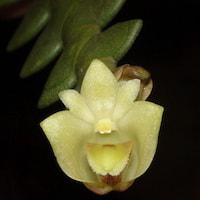
|
Dendrobium leonis (Lindl.) Rchb.f. Thai Names: Uang takhap yai, kang pla Flowers are 1 cm across, yellow, borne singly, and smell of vanilla. Herbal Usage: The entire plant is used to treat headache in Thailand. |
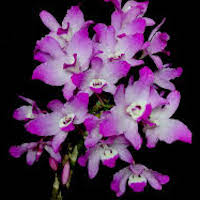
|
Dendrobium linawianum Rchb. f. Chinese names: Yinshihu (oriental cherry Dendrobium), Jinshihu (gold Dendrobium), Lishishihu (Mr. Lee’s Dendrobium), Juchunshihu (lip Dendrobium) Dendrobium linawianum is a small to medium-sized species with a confined distribu- tion being found only in Wulai in broad-leaved forests, at low altitude, in the mountainous north of the Taiwanese island. Herbal Usage: The stem nourishes the yin elements, benefits the stomach, stops thirst, and removes the feeling of heat, dry mouth, weakness, poor health, night sweats and joint pain. |
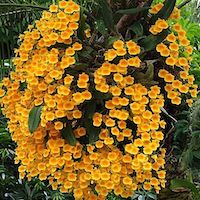
|
Dendrobium lindleyi Steub. syn. Dendrobium aggregatum Roxb. Flowers last a week only. D. lindleyi is distributed in deciduous and evergreen forests at from northeast India to Bhutan, Myanmar, southern China, Thailand, Laos and Vietnam. Herbal Usage: as shihu. |
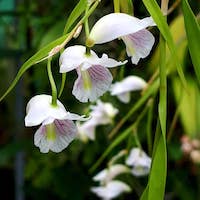
|
Dendrobium linearifolium Teijsm.& Binn. Herbal usage: Pseudobulbs are pounded and squeezed to extract the juice which is instilled into the ear for the relief of earache by the Sepang community in Bali. |
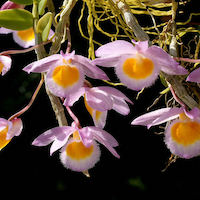
|
Dendrobium loddigesii Rolfe Chinese names: Fenhuashihu (pink flower Dendrobium), Meihuashihu (beautiful flow- ered Dendrobium); Xiaohuangcao (small yel- low herb); huanchahu (ring-like hairpin) Fragrant flowers are borne singly, predominantly on leaf- less stems, profusely in April. It grows on trees or rocks in Guangdong, Guangxi, Guizhou, Yunnan and Hong Kong. 2 alkaloids isolated from this Orchids are inhibitors of Na+, K+-ATPase in the rat kidney. Moscatilin isolated from stem cell of this plant possesses strong antiplatelet activity. In addition to its antiplatelet action, it had potent cytotoxic effect on cancers arising from the placenta, stomach and lung but not on tumors arising from the liver. Herbal Usage: According to TCM, the stem benefits the stomach, produces saliva, nourishes the yin elements, and it is antipyretic. It is used to treat thirst, anorexia, dry vomiting, weak bodies and “muddy eyes. Chinese herbal physicians also use it to treat Type 2 diabetes. |
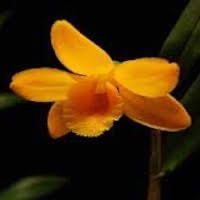
|
Dendrobium lohohense Tang & F.T.Wang Chinese name: Luohe Shihu (Luo River Dendrobium) Japanese herbal name: Chukanso Shihunine present in this plant is used by shamans of the Amazonian Basin in their rituals. Shihunine rapidly and almost totally converts into betaine. Betaine is found in dietary supplements. Physicians sometimes prescribe it, together with vitamins B6, B12 and folic acid, for people who have high levels of homocysteine in their blood, because this increases the risk of coronary heart disease and stroke. However, this does not mean that consuming D. lohoense will help to prevent cardiovascular disease. Herbal Usage: Plants are collected and used in Chinese medicine, as shihu. |
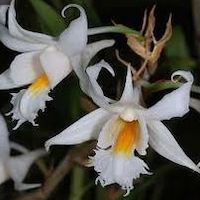
|
Dendrobium longicornu Wall ex Lindl. Syn. Dendrobium bulleyi Rolfe, D. flexuosum Griffith, D. hirsutum Griffith. Chinese name: Changju Shihu Nepali name: Bawar, Kause The species is distributed in Guangxi, Yunnan and southeastern Tibet in China, as well as in Nepal, Bhutan Sikkim and northeast India, Myanmar and Vietnam, all at 1200–2500 m. Phytochemistry: 5 new and 14 known compounds have been isolated from the stems of this plant. Herbal Usage: The Chinese Materia Medica 1999 includes this species as shihu. In Nepal, juice of the plant mixed with lukewarm water is used to bathe children afflicted with fever. Boiled root is fed to livestock to rid them of coughing. Juice of stems is consumed to treat fever. |
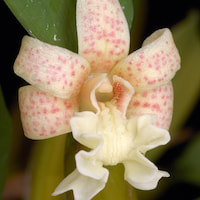
|
Dendrobium macraei Lindl. Desmotrichum fimbriatum Bl., Flickingeria fimbriata (Bl) Hawkes Chinese name: Liusujin Shihu Indian names: Jibai, Jibanti in Bengal, Jivanti, Radarudi, Wajhanti (Gujerati), Jiban, Joivanti, Sag (Hindi), Jivanti (Marathi), Bhadra, Jiva, Jivabhadra, Jivada, Jivani, Jivaniya, Jivanti, Jivapatri, Jivapushpi, Jivavardhini, Jivarisha, Jivdatri, Jivya, Kanjika, Kshurajiva, Madhushvasa, Madhusrava, Mangalya, Mrigaratika, Payaswini, Praanada, Putrabhadra, Ratangi, Shakashreshtha, Shashashimbika, Shringati, Srava, Sukhankari, Supringala, Yashaskari, Yashasya (Sanskrit) Sri Lankan names: Jeevaniya (meaning: supporting life) Saaka shreshtha (best of herbs); Jata Makuta. It usually flowers in March. Herbal Usage: The long list of Indian names is due to the popularity of the plant as a sweet preparation, the much-valued ‘Halwa’. Hailed as a stimulant and tonic, it is taken for debility caused by seminal loss in India and Nepal. In the markets of Bombay, it is known as ruttun-purush and sold at a high price. Apart from its use as a tonic, the plant is used as a remedy for disorders of the bile, blood and phlegm. The fruit is an aphrodisiac. The plant is also used as a counter-poison, however, it could be worthless in this respect. In Nepal, the pseudobulb is used to treat asthma, bronchitis, sore throat, fever, biliousness, diseases of the eye and blood and sexual dysfunction. In Sri Lanka, the whole plant of D. macraei is an ingredient in medicinal oils used in massage for treating paralytic lesions. |
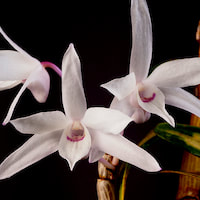
|
Dendrobium moniliforme (L.) Sw. syn. Dendrobium candidum Wallich ex Lindl., Dendrobium wilsonii Rolfe Chinese name: Shihu (Noble Orchid), Shilan (stone orchid), Xijingshihu (thin-stemmed Dendrobium), Xiaoshihu (small Dendrobium), Xiaohuancao (small whorled herb), Jizhua Lan (chicken claw orchid), Jingchacao Tongpi Lan (copper orchid), Tongpishihu (copper Dendrobium) Medicinal names: Shihu, Huan cao (whorled herb), (gold hairpin grass), Erhuancao (ear- ring herb), Xicao (slender herb), Huangcao (yellow herb), Xihuancao (slender whorled herb), Xiaojingcha (small gold hairpin) Taiwanese names: Bai Shi Hu (white Dendrobium), Shi Hu (medicinal Dendrobium), Jie Gu Cao (fixing fracture Dendrobium) Japanese name: Sekkoku Korean name: Seok gok It was developed into a highly desirable ornamental plant in Japan during the early part of the nineteenth century. Phytochemistry: The most important compound isolated is denbinobin. Denbinobin has unique antitumour activity and is also effective against the AIDs virus. The second promising compound is moniliformedequinone which exerts potent cytotoxic activity against hormone-resistant prostate cancer cells in vitro. It induces cellular glutathione depletion leading to DNA damage response and cell-cycle arrest at S-phase (i.e. prevents cell multiplication) and a caspase cascade that culminates in apoptosis. Medicinal materials from both wild and cultured D. candidum improved immunological function. Herbal Usage: It is classic shihu and is the most expensive variety. In his list of 124 important medicinal plants in Chosen, Korea, Ishidoya included only a single orchid, D. moniliforme. The pseudobulb is used to correct body heat, haemoptysis, thirst, malaise, anorexia and to improve the body fluids. Japa- nese and Korean herbalists use it to treat night sweats, weakness, anorexia, lumbago and impotence. It inhibits the release of histamine and aldose reductase. |
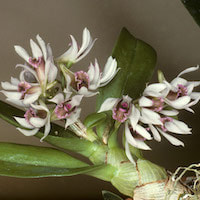
|
Dendrobium monticola P.F. Hunt & Summerh. Indian names: Jiwanti, Bhotia, Lahsan It is a tiny Dendrobium with stumpy, clustered pseudobulbs. The species is distributed from the eastern Himalayas to Laos and Vietnam. Herbal Usage: This is used as an emollient or in the form of a poultice for pimples, boils and other skin lesions in India and Nepal. Sold in the drug markets of Kanpur in the Indian northeastern state of Uttar Pradesh as a nerve tonic and antiphlogistic, it is also used for external application in rheumatism. |
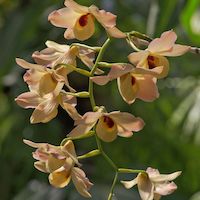
|
Dendrobium moschatum (Buch.–Ham.) Sw. Thai name: Ueang Champa Himalayan Dendrobium with a wide distribution from the foothills of northeast India, Bhutan and Nepal across Myanmar and Thailand to Laos, Vietnam and Yunnan Province in China. Phytochemistry: Moscatin, a phenanthrene derivative, and moscatilin, a bibenzyl derivative, were isolated from the orchid. Moscatilin has cytotoxic effects on placenta, oesophagus, stomach, colon and lung cancer cells. It suppresses tumour angiogenesis and tumour growth. Moscatilin inhibits migration and metastasis of human breast cancer cells (MDA-MB-231) in an animals. Studies with human liver cancer cells showed that markers associated with cell metastases were inhibited by moscatilin. Herbal Usage: Juice from the leaves is squeezed into a painful ear in Meghalaya state. Numerous epiphytic orchids, including D. crumenatum, in Southeast Asia, are used in this manner, possibly reflecting the influence of a strong Indian culture drift in the past. Pseudobulbs are used to treat fractures and dislocations. |
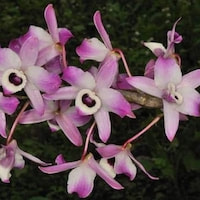
|
Dendrobium nobile Lindl. Syn Dendrobium lindleyanum Griff., D. coerulescens Lindl., D. formosanum Rchb. f. Chinese names: Jinchashihu (gold hairpin Dendrobium), Meihuashihu (pretty flowered Dendrobium), Chunshihu (spring Dendrobium), Yunnanshihu (Yunnan Dendrobium), Diaolanhua (hanging orchid), Bianjincha (flat golden hairpin), Xiaohuangcao (small yellow herb); Dahuangcao (big yellow herb—its name in Guizhou Province); shek huk in Hong Kong. Japanese name: Koki-sekkoku Korean name: Go gwi seok gok Vietnamese names: Thach hoc, Kim thoa thach hoc, Hoang thao, kep thao, hoang thao cang ga, phi diep kep, co vang sao, se kep Thai names: Ueang Gao Giew, Ueang Khao kiu It is an attractive, deciduous epiphyte that grows on trees in sparse forests. Dendroflorin, a molecule found in this orchid, triggers embryonic lung fibroblasts in the G1 phase to enter the S phase and thereby it benefits cell proliferation. It supports ROS degradation. It has large number of sesquiterpenoids. Dendrobine has a slight pain relieving and antipyretic action but it is weaker than standard over-the counter (OTC) painkillers and fever remedies. It raises blood sugar levels, and in large doses it diminishes cardiac activity, lowers blood pressure, suppresses respiration, inhibits rabbit intestinal contractions and contracts isolated guinea pig uterus. It selectively inhibits insulin-like growth factor-1 (IGF-1) in endothelial cells of human umbilical cord. It inhibits HIV-1 replication through an NF- kappaB-dependent pathway. Moscatilin has potential antimutagenic activity. Ephemeranthol A is a potent inhibitor of nitric oxide and pro-inflammatory cytokine production. Herbal Usage: It is the dominant species of shihu. Chinese herbal texts state that the pseudobulb benefits the stomach, encourages secretion of body liquids, and reinforces the yin element. It is used to alleviate dehydration, thirst and poor vision and to hasten recovery after an illness. The medicinal preparation is known as Sek koku in Japan where it is used to treat fever, loss of appetite with nausea and lumbago. The Korean name is Seok gok and its used to treat night-sweat. The World Health Organization (WHO), in its publication, Medicinal Plants of China, selected D. nobile as shihu. |
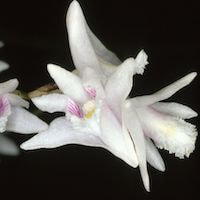
|
Dendrobium nodosum Dalzell. syn. Flickingeria nodosa (Dalzell) Seidenf. Indian names: Purushratna (Kannada) Jiwanti (Ayurveda) This epiphyte has a creeping rhizome stems with well-spaced, slender, erect or pendulous, branching pseudobulbs. Herbal Usage: In Uttara Kanada, Karnataka Province, a sweet-tasting ‘halva’ is prepared from the orchid. The halva is used as an expectorant to treat asthma, bronchitis, “tridosha”, throat infections, and as an astringent for bilousness or to purify the blood. Cold extract of pseudobulbs of Flickingeria nodosa (¼ D. nodosum) exhibited antimicrobial activity against Staphylococcus aureus (a common cause of superficial infections) and Staphylococcus citreus, also a cause of skin infections. Warm extract of pseudobulbs shows antifungal activity against Trichophyton mentagrophytes, an organism that causes skin inflammation and infection of scalp, face, body, feet (“athlete’s foot”) and hair, commonly in rural workers. Matured fruits of D. nodosum are used as an aphrodisiac. |
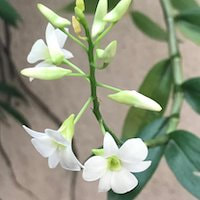
|
Dendrobium ovatum (L.) Kraenzl. Indian Names: Anantali Maravara (van Rheede); Maravar along the Malabar Coast and Uttar Pradesh; Nagli (Marathi) Herbal Usage: In 1703, van Rheede reported that D. ovatum was used for all sorts of chest pain, and especially to relieve stomach ache. In Mumbai, India, it is still used as an emollient, and the juice of the entire plant is prescribed for stomach ache. It acts as a laxative. Tribals of Kudremukh National Park (Karnataka) and in Western Ghats, juice of D. ovatum is obtained by crushing the stems “by hand” and used to treat stomach aches. In northeastern Uttar Pradesh it is reputed to be a tonic, stomachic, pectoral and antiphlogistic. There, it is used to treat rheumatism. There are traces of alkaloid in the leaves. |
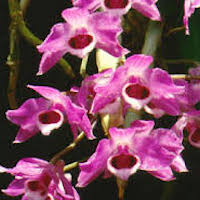
|
Dendrobium. Parishii Rchb. f. Local Name: Xishishihu (named after the classic southern beauty Xishi), Other Common Names: Zibanshihu (Purple feet Dendrobium) Thai Names: Ueang Kraang Sai Sun, Ueang Sai Nam Kraang, Ueang Nam Khrang, Ueang attakrit, Ueang lathakrit, Ueang khrang. Myanmar Name: Khayang yaung twin pyin This striking, rose-purple, fragrant deciduous Dendrobium has a small distribution extending from Indochina into northern Thailand into Yunnan, Myanmar, Bangladesh and Arunachal Pradesh. Its scent has been compared with that of rhubarb. It is very free-flowering. Usage: Pseudobulb benefits the yin element, is antipyretic, stops thirst, and encourages the secretion of body fluids. |
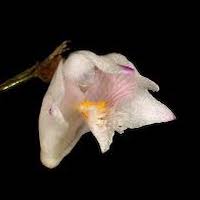
|
Dendrobium planibulbe Lindl. Flowers appear several days after a drop in temperature. Herbal Usage: Pounded into a poultice, it was used to treat sores and infected wounds in Peninsular Malaysia. |
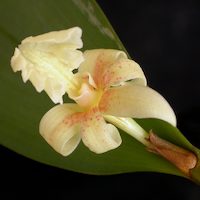
|
Dendrobium plicatile Lindl. syn. Flickingeria fimbriata (Blume) A.D. Hawkes; Dendrobium macraei Lindl., Indian Names: Jibai, Jibanti in Bengal, Jivanti, Radarudi, Wajhanti (Gujerati), Jiban, Joivanti, Sag (Hindi), Jivanti (Marathi), Bhadra, Jiva, Jivabhadra, Jivada, Jivani, Jivaniya, Jivanti, Jivapatri, Jivapushpi, Jivavardhini, Jivarisha, Jivdatri, Jivya, Kanjika, Kshurajiva, Madhushvasa, Madhusrava, Mangalya, Mrigaratika, Payaswini, Praanada, Putrabhadra, Ratangi, Shakashreshtha, Shashashimbika, Shringati, Srava, Sukhankari, Supringala, Yashaskari, Yashasya (Sanskrit), Saka (in Orissa), pourusha rathna or purusha ratana (Kan- nada), Swarn (Uttar Pradesh) Ayurvedic name: Jeewanti in Sarangadhara Sanghita. Sri Lankan name: Jata makuta Chinese name: Liusu Jin Shihu (Tassels gold Dendrobium) Chinese medicinal name: Youguashihu In the markets of Bombay, it is known as ruttun- purush and sold at a high price. But it is not an attractive plant. It has creepy rhizomes with long, branching pseudobulbs, bearing insignificant, white flowers that barely last a day. Phytochemistry: Plant contains an alkaloid, 3 phenanthrenes 5 phenenthrenes, lusianthrin, erianthridin, ephemernthroquinone, a dimethox- ydihydrophenanthrene (related to nudol and showing high cytotoxicity, smooth muscle relaxing effect on the intestine and blood vessels). Plicatol B has anti-coagulant activity. Many compounds showed antioxidant activity. Herbal Usage: Sanskrit writers described the plant as cold, mucilaginous and light. Besides being a tonic, the orchid is used as a remedy for disorders of the bile, blood and phlegm. It is commonly used in decoctions with other plants possessing similar properties. The fruit is considered aphrodisiac. It is used in Rasayana therapy and sold as Jibanti in West Bengal. In the Sushruta, it is a constituent of the local remedy for snake and scorpion bites, but that may not be true. In Sri Lanka, ancient writers called it Jeevaniya (supporting life) and saaka shreshtha (best of herbs). |
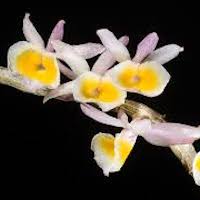
|
Dendrobium polyanthum Wall ex Lind. syn. Dendrobium primulinum Lindl. Chinese name: Xibianshihu (fine petal Dendrobium), Baochunhuangshilan (harbin- ger of spring yellow Dendrobium) Thai names: Ueang Sai Naam Pueng, Sai lueang, Sai prasat, Myanmar name: Thinn kyu kyu Phytochemistry: It contains alkaloids of the indolizidine type, and a high content of hygraine. It also has tetrahydroanthracene was assessed for cytotoxic activity against two human tumour cell lines (A549 and HL-60). Herbal Usage: Whole plant is used to treat burns, eczema and paralysis. |
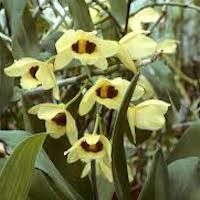
|
Dendrobium pulchellum Roxb. ex Lindl. Thai names: Uang Chang Nao, Uang Kham Ta Kwai Vietnamese names: Hoang thao, Po len, Co anh This attractive Dendrobium is distributed from the eastern Himalaya to Bangladesh, Myanmar, Thailand Indochina and Peninsular Malaysia. Phytochemistry: 4 bibenzyls isolated from D. pulchellum showed to facilitate anoikis (cell death resulting from failure to attach to extracellular matrix) and inhibit growth of lung cancer cells. Herbal Usage: Petelot reported that Chinese living in Indochina at that time used this orchid and D. gratiosissimum Rchb. to make medicine, presumably using them as shihu. It is still being used as shihu in Vietnam. |
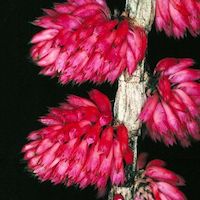
|
Dendrobium purpureum Roxb. Malay name: Angrec cassomba It flowers from June to October corresponding to the driest period of the year. Herbal Usage: The heated pulp of crushed stems of the orchid is used as a poultice for whitlow in Amboin (Sulawesi) (Rumphius, second half seventeenth century). |
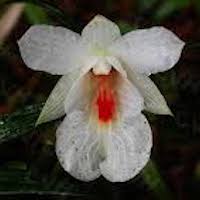
|
Dendrobium sinense T. Tang & F.T. Wang Chinese name: Hua shihu (Chinese Dendrobium) A phenanthre-nequinone, denbinobin B, with antibacterial activity against Staphylococcus aureus, and 3 known phenanthrenes were isolated from whole plant. 4 compounds, 3,4,30-trimethoxy-5,40-dihydroxy- bibenzyl, aloifolI, dihydroxy-3,4-dimethoxy- bibenzyl, and longicornuol A, showed slight cytotoxicity when compared with placitaxil. Herbal Usage: The entire plant is used as shihu. |
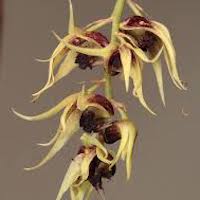
|
Dendrobium strongylanthum Rchb. f. Chinese name: Shuchun Shihu Description: This is an unusual, epiphytic herb, droopy and densely flowered. Flowers do not open widely. They are 1.4 cm across. The species is epiphytic on tree trunks in evergreen forests. Herbal Usage: as shihu. |

|
Dendrobium subulatum (Blume) Lindl. Malay name: Anggerek (orchid) A small lowland epiphyte, distributed in Thailand, Malaysia, Sumatra, Java and Kalimantan. Herbal Usage: Leaves used as a poultice to relieve headache in the Malay Peninsula. This species was identified in 1930, by Mr. Burkhill. This specimen was supplied by a native medicine-man and is used for ear aches. |
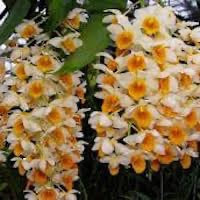
|
Dendrobium thyrsiflorum B.S. Williams Chinese herbal name: Huangcao shihu Vietnamese name: Thuy tien vang Thai names: Uang mon khai liam, Uang mon khai luang It is a beautiful Dendrobium which produces long clusters. Phytochemistry: Chemicals found include found that coumarins that were located mainly in vascular bundles, on the walls of outer fiber cells, with maximum concentration towards the apex of the stem. The plant is found to be bacteriostatic/bactericidal and fungistatic/fungicidal against few pathogenic organism. The bactericidal property was even stronger than that of ampicillin. Herbal Usage: Huangcao shihu is used to nourish yin and remove heat. It benefits the stomach and promotes production of body fluids. |
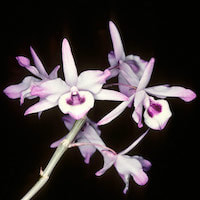
|
Dendrobium transparens Wall ex Lindl. Nepali name: Parajivi, Thuur It is distributed from eastern Himalaya to Yunnan and Myanmar. Herbal Usage: Plant is used to treat fractures and dislocated bones in Nepal. D. catenatum was regarded as the most important and commonest, but other unconventional species in TCM. |
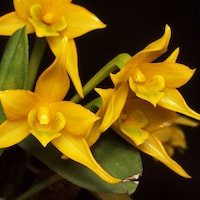
|
Dendrobium umbellatum Rchb. f. Murut name: Tingasu Description: This dwarf species is distributed from Borneo to Papua New Guinea. Herbal Usage: Leaves are boiled and drunk as tea to treat stomachache in Sabah. |
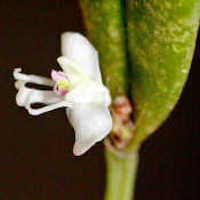
|
Dendrobium trigonopus Rchb. f. Thai names: Uang kham pak kai, Uueang kham liam It is distributed in northern Thailand, Myanmar, southern Yunnan and Laos, on trees in sparse woods. Phytochemistry: Trigonopol A, a compound isolated from the orchid, showed antiplatelet aggregation activity in vitro. Herbal Usage: The stem is used to treat fever and anaemia in Thailand. |
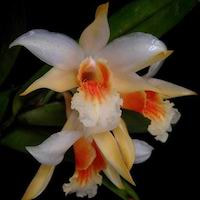
|
Dendrobium williamsonii J. Day & Rchb. f. Herbal Usage: People on Hainan (the Li minority group) island use this as shihu. |
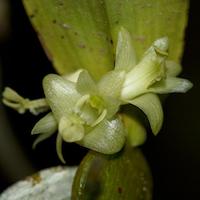
|
Dendrobium xantholeucum Rchb. f. syn. Flickingeria xantholeuca A. Hawkes; Ephemerantha lonchophylla (Hook.f.) P.F.Hunt & Summerh. Chinese name: Jiye Jin Shihu (sharp leaf gold Dendrobium) It is a small epiphyte, distributed throughout Thailand, Malaysia and Indonesia and southern Taiwan from sea level to 1000 m. Phytochemistry: Ephemeranthone, denbinobin and 3-methylgigantol were isolated from this orchid. Ephemeranthone is an anti-oxidant, that inhibits oxidation of human low-density lipoprotein (LDL) in vitro. Two primarne diterpenoids, lonchophylloids A and B, exhibited ability to sensitise cells that expressed multi- drug resistance phenotype to the anticancer drug, doxorubicin. This holds much promise for application to cancer chemotherapy. Denbinobin present in the orchid is cytotoxic against several human cancer cell types, lung, breast, colon. Phenanthroquinone derivative inhibits the formation of blood vessels that support tumour growth, and it prevents spread of the tumour to adjacent or distant parts of the body. Herbal Usage: The entire plant is used as shihu. This has been used as medicinal usage in China for 5000 years. They were the original shihu which grew on rocks in Shen Nong’s Bencao Jing, the classic Chinese Pharmacopoeia. |
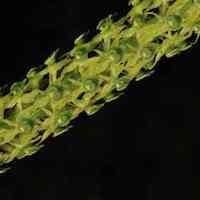
|
Dienia cylindrostachya Lindl. syn. Malaxis cylindrostachya (Lindl.) Kuntze Description: A terrestrial orchid distributed in the Himalayas, Bhutan, Nepal and north-eastern India and a bit in Pakistan. Usage: In Uttar Pradesh and Uttarakhand, it is sold as a nutrient and tonic for use in general debility. Powdered pseudobulb is made into a tonic in. |

|
Dienia ophrydis (J. Koenig) Seidenf. syn. Malaxis latifolia Sm., Anaphora lipaarioides Gagnep. Chinese names: Kuoyezhao Lan (broad-leaf mud orchid) Huazhu Lan (pillar flower orchid), Guangyeruanye Lan (floral pillar orchid), Xiaozhu Lan (small pillar orchid), Guangyexiaozhu Lan (tiny flower, small pillar orchid), Suihuaxiaozhu Lan (broad-leaved, small pillar orchid), Ruanyezhao Lan (soft- leaved mud or terrestrial orchid) Laotian names: Louang Prabang : Van dong. Vientiane: Van nam The shade-loving terrestrial orchid flowers from May to June in Taiwan, August to December in most parts of the continent, but May to June in Assam, India. Usage: It is a common herb in Taiwan. In Taiwan, the entire plant is used as an antipyretic, diuretic, detoxicant and to reduce swelling. Tubers are used to make a paste for application to burns in Vientianne, Laos. |
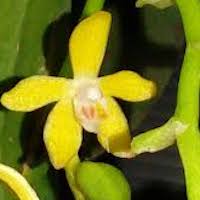
|
Diploprora championii (Lindl) Hook. f. Chinese names: Huangdiao Lan (yellow hanging orchid), Daodiao Lan (hanging upside-down orchid), Daochui Lan (swaying orchid), Niaolaidaochui Lan, Gaoshifodaochui Lan Taiwanese name: Dao Diao Lan, Huang Diao Lan D. championii is a small, pendulous, flat-leaved, vandaceous epiphyte, which flowers in February to September in China, summer in Taiwan, June or August in Thailand, from June to November in India, and February, June, August and December in Sri Lanka. Herbal Usage: The whole plant is used to treat traumatic injuries and fractures in Taiwan. It is also used for the treatment of physical injuries on the mainland China. |
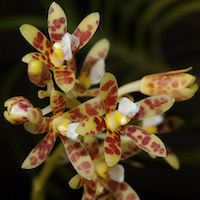
|
Dipodium pandanum F.M.Bailey syn. Dipodium pictum (Lindl.) Rchb. f. The generic name Dipodium is derived from Greek di (two) and podion (foot) and alludes to the twin stipes holding up the pollinia. D. pandanum is a common epiphytic, terrestrial or saxicolous orchid in the lowland rain forests of Papua New Guinea. The species is distributed eastwards and southwards from Borneo to the Philippines, Sulawesi, Java, Papua New Guinea, British Solomon Islands and Queensland. Herbal Usage: Leaves tea is used to treat respiratory infections in Bougainville, Papua New Guinea. |

|
Epipactis helleborine (L.) Crantz. Chinese name: Xiaohuahuoshao Lan (small- flowered flaming orchid) Chinese medicinal name: Yezhulan An alpine, terrestrial orchid that grows across the northern temperate region in Europe and Asia, and in northwest Africa. “Bastard Helleborine” is a common European name for E. helleborine. Phytochemistry: It produces the glucoside, loroglossin, quercetin O-glycosides and Mannose-specific lectins with antiviral and antifungal activities. Alkaloid is present. Herbal Usage: In China, it is used as a tonic. The root is employed in TCM to clear heat from the lungs and liver, stop coughs, clear phlegm, and improve breathing and blood circulation. It is used in the treatment of trauma, sore throat, toothache and painful eyes. It regulates the flow of vital energy. It is also used to treat insanity, gout, headache and stomach disorders in Nepal. In Europe, it was an old folk remedy for gout. |
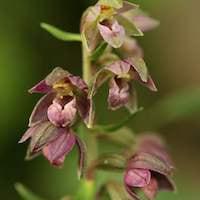
|
Epipactis helleborine, var. helleborine syn. Epipactis teneii Schltr. Chinese name: Huiyanhuoshao Lan (grey rock flaming orchid), Huoshao Lan (flaming orchid) It is widespread throughout Europe, and also occurs in Pakistan and Nepal. Herbal Usage: The medicinal plant is collected from Yunnan, although the species and this variety is widely distributed throughout the temperate regions of the northern hemisphere. In TCM it is principally employed as a tonic. The entire plant is used to clear heat from the lungs and liver, and to stop coughs and clear phlegm, improve blood circulation, relieve toothache, diarrhea, backache and to treat snake bites. Juice of the roots is administered to treat insanity and gout in Nepal. |
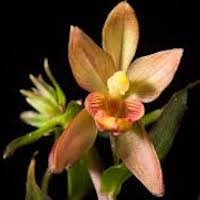
|
Epipactis mairei Schltr. Common name: Dayehuoshao Lan (big flower flaming orchid) Other names (at Emei Shan): Shan chu hua Chinese medicinal name: Xiaozihanxiao An attractive, terrestrial orchid that flowers in June and July in China and until August in the Himalayas. Usage: The plant is used as a tonic in Chinese herbal medicine. A paste made from the vegetative portion is applied to burns. It dissolves extravasated blood and improves the circulation. The medicinal plant is collected from Gansu, Shanxi, Hunan, Hubei, Sichuan, Yunnan and Xizang. |
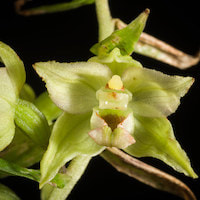
|
Epipactis papillosa Franch et Sav. Chinese name: Ximaohuoshao Lan (fine fur flaming orchid) Chinese medicinal names: Jisuzihua (cockerel crop flower); Niushepian (slice of a cow’s tongue) Usage: In India, the stems and rhizomes were employed to treat insanity. The entire plant is used in Chinese herbal medicine to strengthen the “middle burner” and replenish qi after a spate of illness, and also to treat cholera, testicular swelling and hernia. |
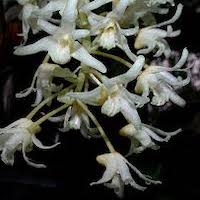
|
Eria bractescens Lindl. This is a showy species. Pseudobulbs are oblong, Tepals are erect, lanceolate recurved at their tips. The species is widely distributed from India to Southeast Asia. Herbal Usage: In the Nicobar Islands, E. bractescens is employed to treat fever, malaria, or body and chest pain. |

|
Eria scabrilinguis Lindl. syn. Eria corneri Rchb. f. Chinese name: Banzhumao Lan (half pillar woolly orchid), Huangrong Lan (yellow woolly orchid), Darong Lan (big woolly orchid, Dayemaihu Lan (big leaf wheat orchid), Rong Lan (wool orchid), Suihuarong Lan (spike woolly orchid), Mengbi Lan (grasshopper legs orchid), Ganshimao Lan (Gan family woolly orchid), Fangguanmao Lan (Fang and Guan woolly orchid). In Hong Kong: Corner’s Eria, Four- corners Eria. Chinese medicinal name: Mengbi Lan A beautiful orchid has long, many-flowered inflorescences carrying small neatly spaced, yellow, star-shaped flowers. It is distributed in southern China, from Taiwan to Fujian, Guangdong, Guangxi, Guizhou and Yunnan and Hainan. It is also present in the Ryukyu Islands and in Vietnam and Laos. Usage: It is sweet in taste, and neutral in nature. The whole plant is antipyretic. It detoxifies, benefits the stomach, produces saliva and is used to treat hot illnesses, lack of salivation, thirst, night sweats and running. Plants are harvested in summer or autumn, washed, steamed, then sun-dried. |
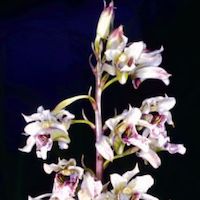
|
Eulophia bicallosa (D. Don) P.F.Hunt & Summerh. Chinese names: Taiwan Meiguan Lan (Taiwan beautiful crown orchid), Lianchiyangersuan (sickle wing goat ear garlic) Japanese name: Yukoku-ran (deep valley orchid) Description: This is widely distributed from Japan (Kyushu and Okinawa) and Taiwan, Fujian, Guangdong, Guangxi, Hunan, Yunnan, Guzhou and Xizang provinces. The whole plant to enrich qi. It enriches the blood. It is employed as an antipyretic and an antidote for the treatment of tuberculosis, tuberculous lymph- adenopathy, sores and ulcers, abdominal pain or distension and schistosomiasis. |
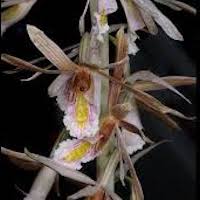
|
Eulophia dabia (D. Don) Hochr. syn. Eulophia campestris Wall ex Lindl. Indian names: Salibmisri, Sung Misrie, Charle-michhri in Bengal, Salum (in Mumbai), Salib- misri (in Punjab); Salu (Gujerati dialect), Salibmisri (Hindi), Salamisri (Marathi), Bongataini (Santal), Salabmisri (Urdu), Amrita, Amritobhava, Jiva, Jivani, Pranabhrita, Pranada, Sudhamuli, Virakanda (Sanskrit) It is distributed from Afghanistan, Baluchistan, Uzbekistan, the southern Himalayas, to south China. Phytochemistry: Tubers contain n-heacosyl alcohol and lupeol. Mucilage of the orchid is suitable for use as a binder in the preparation of tablets for the pharmaceutical trade. Using paracetamol as a model drug, the tablets employing E. dadia mucilage as binder released more than 85 % of the medication within 3 h Herbal Usage: Tubers are eaten as tonic and aphrodisiac in India and Nepal. They are astringent and stimulate the appetite. Ayurveda practitioners prescribe it for stomach ache, poor appetite and to stimulate blood flow in patients suffering from heart disease, albeit its major role is as a tonic and aphrodisiac. For consumption, it is usually mixed with milk and flavored with spices and sugar. |

|
Eulophia epidendraea (J.Koenig ex Retz) C.E.C. Fisch. Indian Names: Katou kaida maravara; Katou theka maravara; Segadomma gaddalu E. epidendraea is an Indian terrestrial species distributed in southern India (Maharashtra, Kerala and the Eastern Ghats from Andhra Pradesh to Tamil Naidu), Sri Lanka and Bangladesh. Phytochemistry: Tubers of this orchid contain beta-sitosterol, beta-sitosterolglucoside, beta- amyrin and lupeol. The leaves contain flavonoids, apigenin, luteolin, kaempferol and quercetin. Herbal Usage: The tubers are sometimes used as vermifuge, demulcent and analgesic. It is applied externally for muscular pain. This is added to make recipe for anorexia and also administered orally once a day for 15 days to treat anthrax in domestic animals. |
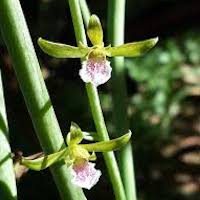
|
Eulophia graminea Lindl. Indian name: Kattuvegaya It is widely distributed from India and Sri Lanka to Southeast Asia, China and Japan (Ryukyu Islands). Herbal Usage: Eardrops made with juice of The orchid are employed by the Paliyan tribes of Sirumalai Hills of southern India to treat earache. |
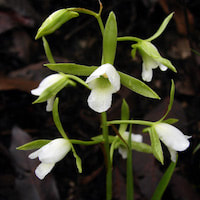
|
Eulophia herbacea Lindl. Chinese name: Maochun Meiguan Lan Thai Name: Wan Mangmum It is a terrestrial, herbaceous orchid occurring in lowlands in Indochina, Thailand, Bangladesh, throughout India. Herbal Usage: Tubers are sold in Indian bazaars as salep misri. It is used as a tonic and blood purifier for illnesses which are thought to be caused by impurities in the blood. In Thailand, the pseudobulbs are used to treat insect bites. |
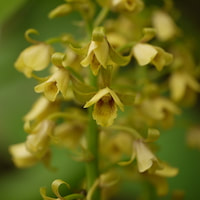
|
Eulophia ochreata Lindl. Indian names: Amarkand, Singadyakand Description: It is a pseudobulbous, terrestrial orchid, endemic in Peninsular India. Phytochemistry: A phenanthrene, 9,10-dihydro- 2,5-methoxyphenanthrene-1,7-diol isolated from the tubers is anti-inflammatory. The phenanthrene, remarkably did not interfere with any cellular process. Herbal Usage: Tubers are used for a variety of conditions in Mumbai. The juice is applied externally to treat rheumatism. Tubers have a high mineral content exceeding 2 % of dry weight and are eaten as a traditional vegetable. In Rajasthan, India, powdered pseudobulbs are mixed with powdered tubers of Chlorophytum borivilianum in equal proportions and a teaspoon of the mix dissolved in milk is consumed daily for a month to boost the immune system. Tuber powder is also administered to patients with leukemia. Tubers are also used as aphrodisiac, and “blood purifier”, to treat |
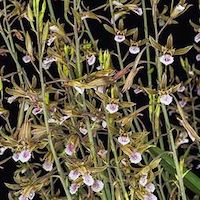
|
Eulophia pratensis Lindl. syn. Eulophia ramentacea Wight Local name: (Marathi): Satavari Herbal Usage: Tubers are used as salep misri. Fresh tubers were pounded and applied over the abdomen to kill worms. They are also applied externally and taken orally to treat enlarged scrofulous glands in the neck. The dried roots were placed in small bags set around a building to drive away snakes. |
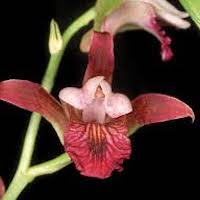
|
Eulophia spectabilis (Dennst.) Suresh Chinese names: Meiguan Lan (Beautiful crown orchid) Zihuameiguan Lan (purple flower beautiful crown orchid) Indian names: Bonga taini in Orissa, Amarcana, Manya (Sanskrit), Ambarkand, Goruma (Hindi), Ambarakand, Bhuikakali, Manakanda (Marathi) Budbar (in Bengal), Mankand (in Bombay); also Balakanda, Granthidala, Kandalata, Malakanda, Panktikanda, Trishikhadala (from Caius 1936: dialects/region not identified) Nepalese name: Amarkand Thai names: Wan hua khru, Wan ung A widespread, terrestrial orchid distributed in tropical and subtropical Asia, it is found in the Western Ghats of India, tropical Himalayas, Myanmar and south China, Indochina, Malaysia, Indonesia, Philippines and the Pacific Islands. Phytochemistry: It contains at least 9 phenanthrenes including coelonin, nudol, eulophiol, nudol, lupeol, 9,10 dihydro-2,5 dimethyl phenanthrene-1, and 9,10 dihydro-4- methoxy-phenanthrene-2,7-diol. Nudol, These phenanthrene showed antiproliferative activity against human breast cancer cell lines MCF-7 (91 %) and MDA-MB-231 (85 %) at 1000 mcg/ml. Tubers also contain alkaloids, saponins, cardiac glycosides, steroids and flavonoids. Herbal Usage: In Malaysia and India, a poultice made from the pseudobulbs is applied to the abdomen to kill intestinal worms, or to treat abscesses and infected wounds. This usage may be derived from Ayurvedic medicine because, in India, tubers were later reported to be used for tumors, scrofulous glands of the neck, bronchitis, and as vermifuge, blood purifier and an antidote for poisoning. Tribal of Kudremukh National Park in Karnataka prepare a decoction with the tubers (amarcana) to treat tumors and bronchitis or merely to be consumed as appetizers. The Dongria hill tribe in Orissa uses its leaves in decoction as vermifuge. |
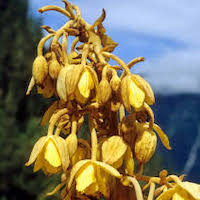
|
Galeola lindleyana (Hook f. and Thomson) Rchb. f. Chinese name: Maoeshanhu Lan (Hair stem coral orchid) Taiwanese name: Shan Hu (mountain coral) It grows in rich, moist, rocky areas in sparse woods and thickets or along ravines. It has wide distribution from Taiwan, across southern Shanxi, Henan, Anhui, Hunan, northern Guangdong, northern Guangxi, Guizhou, Yunnan and Xizang provinces in China to Vietnam, Peninsular Malaysia, Sumatra, Sikkim, Nepal and northeast India. Herbal Usage: Herb is used to combat heat. It promotes diuresis, stops bleeding, reduces swelling and is used in the herbal treatment of nephritis, hematuria and uterine prolapse. |
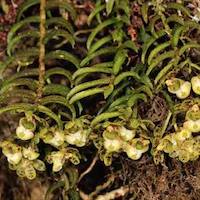
|
Gastrochilus distichus (Lindl.) Kuntze syn. Saccolabium distichum Lindl Chinese name: Lieyepenju Lan (leaves in a row, pot distance orchid) Chinese medicinal name: Fenghuangmao The species occurs in southeast Tibet, western Yunnan, Sikkim, Bhutan and Nepal. Phytochemistry: It contains alkaloid. Herbal Usage: The plant is used to treat mastitis. |
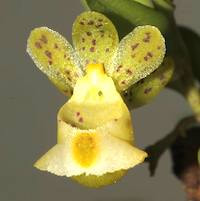
|
Gastrochilus formosanus (Hayata) Hayata Chinese names: Taiwansong Lan (Taiwan pine orchid), Taiwannanchun Lan (Taiwan pocket lip orchid), Taiwan Pengju Lan (Taiwan pot orchid), centipede orchid This small epiphytic orchid has a long flat stem. It occurs in Taiwan Fujian, Hubei and Shaanxi. Herbal Usage: Whole plant is antipyretic, and is used for detoxification. |
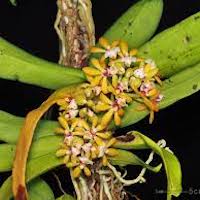
|
Gastrochilus obliquus (Lindl.) Kuntze Chinese name: Wujingpenju Lan Thai names: Lin krabue noi; Sua luang; Chang rop kho The species is distributed from Nepal, Bhutan, Sikkim, southwest Sichuan and southern Yunnan to Myanmar, Thailand, Laos and Vietnam. Herbal Usage: Whole plant is used to treat body aches among village folk in Thailand. |
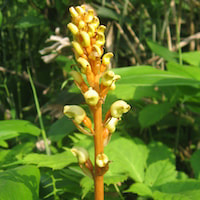
|
Genus: Gastrodia R. Br. Chinese name: Tianma Japanese name: Oni No Yagara Gastrodia is a genus of achlorophyllous, par- asitic orchids. Plant is without green leaves and lives off a mould on the forest floor. Tubers are irregular, somewhat ovoid-shaped, rather like a stomach (hence, gastro, Greek), and subterranean. Chinese tradition has it that 5000 years ago, around the dawn of its civilization, Shen Nong taught people how to grow crops and use various herbs for healing and to promote health and longevity. This included the use of Tianma (G. elata). In a WHO publication of the medicinal plants of Korea, G. elata is the only orchid listed among 150 medicinal plants. |
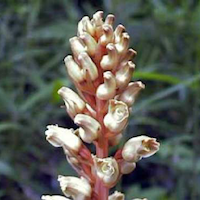
|
Gastrodia elata Blume Local Name: Tianma (Heaven’s fibre, Sky burlap) Other Common Names: Chinese: Ming Tianma (Bright heaven’s fibre); Chi Jian (Crimson arrow); Chijiangen (Red arrow root); Ding Feng Cao (Wind-calming herb); Bai Long Pi (White dragon skin); Bailongcao (White dragon grass) Japanese name: Tenma (Heaven’s fibre); Oni-no- yagara (Orge’s arrow) Korean name: Cheon ma Flowering season is May to July all over China. Tuber of this orchid is one of the oldest drugs in Traditional Chinese Medicine (TCM). The records date only to the Han Dynasty (221 BC–220). Its original name was Chi Jian (Red arrow). The current name, Tianma (Heaven’s fibre), was first mentioned during the Song Dynasty (960-1279) in Kai Bao Bencao published in 973. The relationship of G. elata to fungi Armillaria mellea (honey fungus) is quite complex in the natural setting and not restricted to Armillaria. It is used for For frightfulness of children, For stroke, tetanus, for migraine and various forms of headaches, For malaise, dizziness, sleepiness, headaches For excessive liver yang, surge of liver wind, headaches, dizziness, insomnia For high blood pressure For postpartum blood circulation For stroke with paralysis of extremities For rheumatism with stiffness of extremities in women For backache and pain of the lower extremities For rheumatism, numbness and paralysis For lung “wind poison”, pruritus and skin boils and ulcers For generalized dermatitis Phytochemistry: To date, 47 compounds, of which the majority were phenols, have been isolated from G. elata. On Skin Pigmentation - Korean, Chinese and other Asian scientists are screening medicinal plants for tyrosinase and DOPA auto-oxidation inhibitory activities to possibly employ them as skin whiteners in the cosmetic industry. |
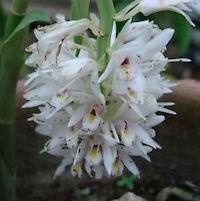
|
Geodorum attenuatum Griff. Chinese name: Dahuadibao Lan Thai Name: Euong po It is found in the edge of lowland forests in Hainan Island, Indochina, Thailand, Myanmar and Yunnan. Herbal Usage: Pseudobulbs are used as a tonic in Thailand. |

|
Geodorum densiflorum (Lam) Schltr. Bangladeshi name: Kukurmuria (Garo tribe) Chinese name: Dibao Lan (precious ground orchid) Indian name: Kukurmuria in Orissa Flowering season is from April to May in Assam, West Bengal and the Andaman Islands. This terrestrial orchid is distributed in Sri Lanka, Myanmar, Thailand, Indochina, Malaysia, Indonesia, the Philippines, the Ryukyu Islands; and in Taiwan, Hainan, Guangdon Guangxi, Guizhou, Yunnan and Sichuan in China; also in Queensland (Australia) and Western Pacific. Herbal Usage: Poultice made from the pseudobulbs of is used as a disinfectant in Philippines. Root paste mixed with ghee and honey is used by a hill tribe of Orissa to correct menstrual disorders. Further south in Andra Pradesh, the Kondareddis of Khammam and the Chenchus of Kurnool apply a root paste for insect bites and wounds. In the Khammam district of the same state, Koyas feed the tubers of the orchid, pepper and garlic to cattle struck down with intermittent fever. It is fed to goats when the animals suffer from diarrhea. Crushed rootstocks are rubbed on cattle to kill flea s in Uttar Pradesh. |

|
Geodorum recurvum (Roxb.) Alston Indian name: Tajraj Burmese name: Thitkhwa Description: A terrestrial herb, it is distributed from Orissa in India to Myanmar, Thailand, Cambodia and Vietnam to south and southeast Yunnan, Guangdong and Hainan. Herbal Usage: A tribe in Orissa uses it to treat malaria. Root paste is used to treat tumors. In India, it is also used internally as an antidiarrhoeal and externally as a pesticide to treat goats and cattle in India. Local practitioners in Myanmar employ pseudobulbs as medicine. Alkaloids are present in this orchid. However, there is no pharmacologic publication on medicinal Geodorum. |
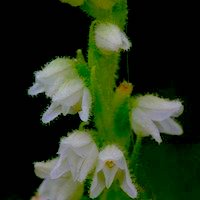
|
Goodyera R. Br. Chinese name: Banye Lan Chinese medicinal name: Banyelan Japanese name: Shusu Ran Members of the genus are known as “rattlesnake plantain” in North America. Like many terrestrial orchids, these orchids are also dependent on specific groups of fungi for their existence. Nitrogen acquisition by the orchid was predominantly through a fungus-dependent pathway. |
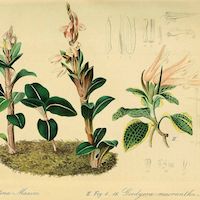
|
Goodyera biflora (Lindl.) Hook f. Syn. Goodyera pauciflora Schltr. Chinese name: Danhuabanye Lan (Big flower spotted leaf orchid) for Goodyera pauciflora from Sichuan and Yunnan: Shaohuabanye Lan (Few flowered spotted leaf orchid) This small, terrestrial orchid has a long creeping rhizome with an erect stem that are distributed from Nepal, Bhutan and India across Xizang, Yunnan, Sichuan, Shanxi, Hubei, Hunan and Guangdong Provinces in China to Japan and Korea. Herb is obtained from Shanxi, Hubei, Hunan, Guangdong, Sichuan, Yunnan and Tibet. Herbal Usage: In China, the whole plant is used to treat haemetemesis associated with tuberculosis, anorexia and neurosis. It enriches yin, and benefits the lungs. Chinese herbalists use the whole plant for detoxification and to treat snake bites, sores and ulcers. The leaves were used in decoction and externally to treat scrofula in the Americas. |
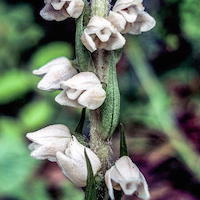
|
Goodyera brachysteia Hand. Mazz Chinese name: Duanbaobanye Lan (Short bud spotted leaf orchid) It is an endemic, small, terrestrial herb found in forests at 1300–2000 m only in southwest Guizhou province and the adjacent northeast Yunnan. Herbal Usage: In TCM, the entire plant is used to prepare the medicine. It is used to “strengthen the middle burner and replenish qi (internal energy or life force)”. A decoction of the orchid plant is used to promote blood flow and to relax the muscles and tendons. It benefits the waist and kidneys, relieves backache, testicular swelling, dizziness, tinnitus and traumatic injuries. |
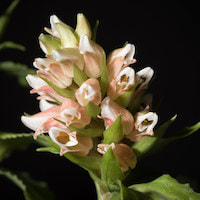
|
Goodyera foliosa (Lindl.) Benth ex C.B. Clarke Chinese names: Houchunbanye Lan (Thick lipped, etched leaf orchid), Gaolinbanye Lan (High mountain ridge etched leaf orchid); Duoyebanye Lan (Multiple etched leaf orchid) It occurs at 300–1800 m, growing on the humus-rich floor of broad-leaved, evergreen forests from the Himalayan foothills of India, Bhutan, Nepal, Myanmar, across southern China (Xizang, Yunnan, Sichuan, Guangxi, Guangdong, Hong Kong, Fujian, Taiwan) to Japan and Korea. Herbal Usage: The whole plant is used in decoction. It is antipyretic, detoxifies, improves blood flow, reduces swellings and is used in the treatment of tuberculosis, hepatitis, weepy sores and snake bites. |
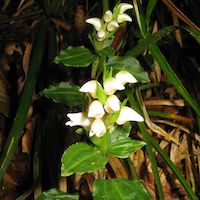
|
Goodyera henryi Rolfe Chinese name: Guangebanye Lan (Naked bud spotted leaf orchid) It has a long, creeping rhizome which terminates in a 10- to 15-cm-tall, erect stem. Herbal Usage: The whole plant is used to promote blood flow, and to treat snake bite, dysentery and lymphatic tuberculosis in Chinese herbal medicine. |
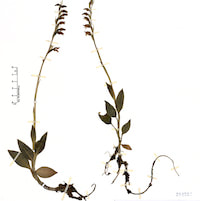
|
Goodyera kwangtungensis C.L. Tso Chinese name: Guangdongbanye Lan (Guangdong province spotted leaf orchid), Huayebanye Lan Description: Medicinal plants are harvested from Guangdong and Guangxi. Flowering period is May to June. Herbal Usage: The entire plant is used to improve the condition of the lungs and to clear phlegm. |
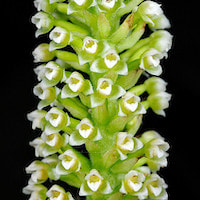
|
Goodyera procera (Ker-Gawl.) Hook. Chinese names: Tushagen (convex yarn root), Gaobanyelan (tall etched leaf orchid) Zhengxijiao (middle brook abaca/leaf), Zhengxi Lan (middle brook orchid) Chinese medicinal name: Shifengdan (stone wind pellet), Lanhuacao (orchid flower herb) Taiwanese names: Peng Sha Gen (borax root), Zheng Xi Jiao (straight stream leaf), Sui Hua Ban Ye Lan (spiking etched leaf orchid) It is an endangered species in India, but is widely distributed in Nepal, Bhutan, China and Hong Kong. Usage: It “dispels wind, eliminates dampness, nourishes blood, relaxes muscles and tendons, removes numbness, and promotes recovery from hemiplegia”. The entire plant relieves rheumatism, relaxes the muscles, enlivens the blood, smooth the lungs, suppresses coughs and stops bleeding. It is used to treat tuberculosis, weak kidneys, backache, jaundice, asthma and traumatic injuries. |
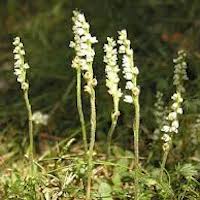
|
Goodyera repens (L) R.Br. Chinese names: Nantoubanye Lan (Pocket-sized, etched/reticulated leaf orchid), Xiuzhenbanye Lan (Pocket-sized etched leaf orchid); Xiaobanye Lan (Small speckled leaf orchid); Huasheyizhijian (Floral snake single arrow.) North American Names: Dwarf rattlesnake plantain; Lesser rattlesnake plantain Pakistani common name: Creeping Ladies Tresses This is a small terrestrial herb with a tall, slim erect stem. It is distributed throughout the north- ern hemisphere from Scandinavia across Russia and China to Canada and northern USA. It grows in shady, leaf-strewn, humus-rich, moist ground in coniferous and deciduous forests or ravines and hill slopes. The life history of the orchid is very interesting. Seed released in autumn stay dormant until spring, after which they germinate. During summer, the seedlings reach 1 mm in diameter but they acquire no roots or leaves until the next summer, their fourth growing season. Individual plants may take up to 8 years to flower, after which the stem dies down, leaving a cluster of axillary shoots which then form a colony. Phytochemistry: A small amount of alkaloid is present. It also produces loroglossin. Herbal Usage: In Chinese herbal medicine, the whole plant is used to nourish the lungs and kidneys and to relieve pain. It is used to treat fever, weepy sores, tuberculosis, coughs, weak lungs, weak kidneys, asthma, dizziness, backache, nocturnal emission, impotence and snake bites. In India, this is used to treat illnesses of women, stomach and bladder diseases. The chewed leaves are applied to reptile bites. The mashed leaves are used to prevent infant rash. It is also used as salep. |
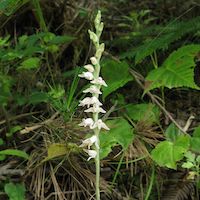
|
Goodyera schlectendaliana Rchb. f. Chinese names: Dabanye Lan (Large speckled orchid); Jinbian Lian (Gold border lotus); Yinherhuan (Silver ear orchid); Yinzong Lian (Silver palm lotus); Mountain jewel orchid Taiwanese names: Da Wu Shan Ban Ye Lan (Mountain dawn etched/speckled orchid), Gao Shan Lian (Mountain lotus) Japanese name: Miyama uzura (Quail of the deep mountain) This dwarf species is native to China, Japan and Southeast Asia. Phytochemistry: It contains a unique, complex flavonol glucoside that was given the name Goodyerin. It is 8-(4-hydroxy-3,5-dimethoxy- phenylmethyl) quercetin-3-O-rutinoside and has sedative and anti-convulsant activities. Usage: In TCM, the entire plant is used to clear the lungs, stop coughs, reduce swelling and pain, treat tuberculosis, coughs, phlegm, asthma and weak kidneys. A poultice of the leaves is applied for pain relief. Tincture is consumed with rice as a tonic for internal injuries. |
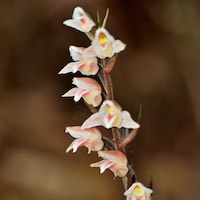
|
Goodyera velutina Maxim syn. G. morrisonicola Hay. Chinese names (in Taiwan): Niaozui Lan (Bird mouth orchid), Rongyebanye Lan (Velvet leaved etched leaf orchid) Herbal usage: TCM states that the whole plant is antipyretic and detoxifies, and that it enlivens the blood. It is also used as a painkiller. It is used to “moisten the lungs”, improve kidney qi and treat haematuria, to improve circulation, reduce swelling, remove toxins, treat tuberculous coughs, bronchitis, dizziness, vertigo, fainting spells, fatigue, neurasthenia, erectile dysfunction, trauma, arthritic pain, sore throat, mastitis, tuberculous lymphadenitis, snake bites and skin diseases presenting with swelling and ulcers. |
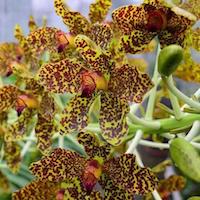
|
Genus: Grammatophyllum Blume The generic name, Grammatophyllum, is derived from the Greek gramma (letter) and phyllon (leaf) referring to the conspicuous marking on the petals and sepals that look rather like letters. In old times, only high-borne court ladies were entitled to sport them in their hair. The flowers were known as bunga putri, or “flower of princesses”. They are distributed in Southeast Asia, Papua New Guinea and the Solomon Islands. |
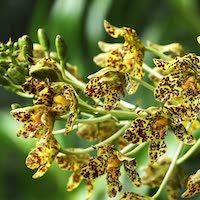
|
Grammatophyllum scriptum (L.) Blume Common Names: Leopard orchid (adapted from Gramm. leopardinum Reichb. f.); tiger orchid (for var. tigrinum Lindl.) Indonesian names provided by Rumphius (1627–1702): Angrec calappa, Angrec lida in Bali; Angrek boki, Bonga boki, bonga putri (Malay); Saja baki, Saja ngawa, Ngawan, Saja ngawa (Ternate), Anggrek kringsing (Bali) Contemporary Indonesian names: Bunga Bidadari, Anggerik Bidadari, Bunga Puteri (Malaka); Anggerik Puteri; Anggerik Matjan; Anggerik Harimau; Anggerik Boki (Maluku); Anggerik Garingsinge (Bali); Anggerik Tiwu Anggerik Susuru (Sunda); Saja Bake; Saja Ngawa; Saja Ngawan (Ternate) Tijgerorchidee (Belanda). Main flowering season is April to May and it is distributed from Borneo eastwards to the Pacific. Herbal Usage: The pulp was pounded together with Curcuma (kunyit, turmeric, Curcuma domestica), for application on fingers afflicted by bacterial infection of the nailbed. Rinsing one’s mouth with sap of pseudobulbs was a remedy for thrush. A poultice prepared from mashed orchid pseudobulbs and ginger was applied to the abdomen as a vermifuge. It supposedly is capable of expelling all bad humors from the bowel and swollen spleen. The paste was applied on swollen legs to drain the fluid. |
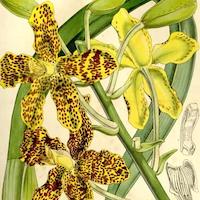
|
Grammatophyllum speciosum Blume Common name: Tiger Orchid Indonesian names; Anggkrek tebu (Malay) (sugar cane orchid); Angkrek tiwu (sugar cane orchid), Kadaka susuru (Sundanese) Malay names: Bunga puteri (Princess flower); Bunga bidadari (nymph’s flower) Thai name: Wan phetchahueng Myanmar name: Kyar ba hone Philippine names: Giant Orchid, Queen Orchid, Sugar-cane Orchid The species is distributed in Burma, Thailand, Laos, Malaysia, Singapore, Indonesia, the Philippine, and Papua New Guinea in the lowlands. In Singapore, it flowers from August to September. Mr. Ridley noted that plants had to reach a large size before they will flower but afterwards they would flower every year. Plants grow very well in Penang in northern Malaysia which has a similar long dry season from November to February. Herbal Usage: The stem of is used to treat fever and anaemia in Thailand. Roots are listed as an insect bite remedy in old Thai drug recipes. Kelabit in Sarawak use the orchid stems (ubud aram) as food, although it is slightly bitter when cooked. |
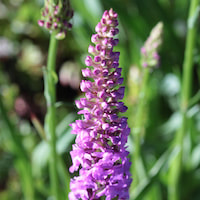
|
Gymnadenia conopsea (L.) R.Br. Chinese name: shou shen (hand ginseng), Shouzhangshen (Palm ginseng), Foshoushen (Buddha hand ginseng), Zhangshen (palm ginseng) Chinese medicinal name: Shouzhangshen (Palm ginseng) Japanese name: Tegata-chidori It is found in open forests, rocky slopes, grasslands and water-logged meadows at 200–4700 m in Japan, Korea, Russia and Europe. Herbal Usage: It is widely used, almost similar to ginseng (Panax ginseng) which is not an orchid. The stem benefits the kidney and is used to replenish the vital essence, stops bleeding, and to alleviate lassitude caused by illness. It is used to treat coughs due to weak lungs, impotence and other forms of sexual dysfunction, discharge, traumatic injuries, thrombosis, chronic hepatitis and failure of lactation. Phytochemistry: Methanolic extract of Gymnadenia conopsea tubers produced an anti-allergic effect. Alcoholic extract protected mice against silica-induced fibrosis of the lungs. |
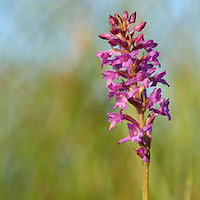
|
Gymnadenia crassinervis Finet Chinese name: Duanjushoushen, Cumaishouz- hangshen (large venation hand palm ginseng), Shou zhang zhen (palm ginseng) Chinese medicinal name: Shouzhangshen (Palm ginseng), Cumaishouzhangshen (large vena- tion hand palm ginseng) The species is endemic to a small region in China. It is found in Rhododendron thickets, in crevices on rocky slopes at 2000–3800 m in west Sichuan, northwest Yunnan and eastern and southern Tibet. Herbal Usage: The Zhongyao Da Cidian states that “there are three types of palm ginseng (Shou zhang shen)- (1) Gymnadenia conopsea (Shou Shen in Chinese), (2) Gymnadenia crassinervis (Shou Shen with coarse veins) and (3), Coeloglossum viride “which has long, concave buds”. All three “nourish wind and blood”, quench thirst, treat weak lungs, coughs, dyspnea, weakness from exertion and weight loss, neurasthenia, chronic diarrhea, blood loss, vaginal discharge, poor lactation, chronic hepatitis. |
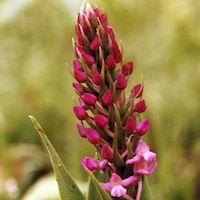
|
Gymnadenia orchidis Lindl. Syn. Gymnadenia conopsea (L.) R.Br. var. yunnanensis Schltr. Chinese names: Shouzhangshen (name also refers to Gymnadenia crassinervis Finet). Xinanshoushen (southwest hand ginseng), Xinanshouzhangshen (southwest hand palm ginseng) Indian names: Salam panja, Salam punja, Salep Nepali names: Hati Jara; Panch aunle (“five fingers”, referring to the root) in Nepali; Ongbu lakpa (Sherpa) This terrestrial orchid is found in thickets and forests along valleys at altitudes of 2400–4000 m. A period of chilling stimulates seed germination, and green pod culture works well in vitro. Herbal Usage: In India, salep is supposed to have aphrodisiac properties. Pseudobulb powder is applied to cuts and wounds in Nepal. A decoction of the pseudobulbs is taken three times a day, in moderation, to relieve stomach ache and liver or urinary disorders. It enjoys a wide application in Chinese herbal medicine, almost similar to that of ginseng. It is used to treat coughs caused by weak lungs, cure impotence and other forms of sexual dysfunction, discharge, traumatic injuries, thrombosis, chronic hepatitis and failure of lactation. The scent is fragrant. It works very well in floral scent due to benzyl acetate, benzyl benzoate, methyl eugenol, eugenol, elemicine, benzyl alcohol, cinnamic alcohol with trace amounts of phenylethylalcohol, phenylethylacetate and (Z)-3-hexenol. |

|
Genus: Habenaria Willd. Chinese name: Yufeng hua (phoenix/heron flower) Japanese name: Mizu Tombo Sanskrit name: Riddhi It thrives in areas with distinct wet and dry seasons. It needs a dormant phase to flower properly, or even just to survive. With the arrival of the first rain, the plant sends out an aerial shoot which grows rapidly during the 2 months of heaviest rainfall, flowers, and when the rainy season is over the aerial portion dies down leaving the underground tuber to await the next rainy season. The generic name is derived from Latin habena (bridle, whip, strap, veins) which describes the thread-like fringe on the lip in some species. |
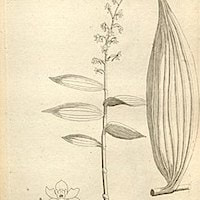
|
Habenaria aitchisonii H.G. Reich. Syn. Habenaria diceras Schltr. Chinese names: Duiduisheng (couple ginseng), Luodijinqian, Shuangxianerye Lan (two threads, two-leaves orchid) Chinese medicinal name: Shangicao (name also applies to H. ciliolaris) The species occurs in forests, thickets and grassland at 2100–4300 m in Guizhou, Yunnan, Sichuan, Xizang, Qinghai and Bhutan, and the temperate Himalayan region of India, Kashmir, Pakistan and Afghanistan. Herbal Usage: Herbs are collected from Yunnan, Sichuan and Tibet. Roots benefit the kidneys. They are also used to treat nephritis and hematuria. |
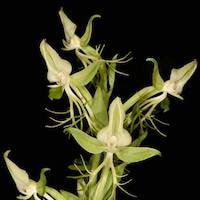
|
Habenaria arietina Hook. f. Syn. Habenaria intermedia D. Don. var. arietina Common name: Reindeer Orchid Chinese name: Mao ban yu feng hua Indian Ayurvedic names: Riddhi, Vriddhi, Laksmi, Mangala, Rathanga, Risisrista, Saravajanpriya, Siddhi, Sukha, Vasu, Yuga. (Note that the Ayurvedic names are identical with those of H. edgeworthii.) Other Indian name: Safed musli (in Garhwal), Dakshinavarta, Himadrija. (Note: Similar Ayurvedic names for Habenaria edgeworthii.) Nepali name: Thunma Pakistani common name: reindeer orchid It is a variable species that is distributed in temperate Pakistan, northeast India, Bhutan, Nepal, Bangladesh, China, Thailand and Vietnam. |
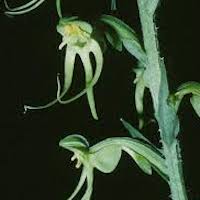
|
Habenaria ciliolaris Kraenzl. Chinese names: Yufeng Lan (jade phoenix orchid), Cugenyufeng Lan (a bundle of roots jade phoenix orchid); Maotingyufeng Lan (Maoting jade phoenix orchid); bird’s bill orchid It is found in Hong Kong and Taiwan around 800 m in exposed areas of forest. It also occurs in shaded locations in forests and along valleys. Herbal Usage: According to TCM, its stem improves weak kidneys, yang elements, removes heat and detoxifies. Herb is used to treat nocturnal emissions, impotence, urinary problems, hernia, leucorrhoea, gonorrhea, stomach ache, tuberculous cough, kidney infection and snake bites. |
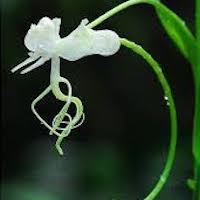
|
Habenaria commelinifolia (Roxb.) Wall ex Lindl. Chinese name: Fueyufeng hua Indian name: Devsunda; Jadu, Jaitjadu (Sadani); Ridhi Vridhi Myanmar name: Kadaw sut Herbal Usage: Plant is eaten as a vegetable and is supposed to be a blood purifier. It is used to cure blebs on the palm. Dried root of the orchid is used to treat spermatorrhoea. It is considered to have an oestrogenic effect because, in India, its bark has the reputation of keeping women youthful and healthy and it is used to treat gynecological conditions. |
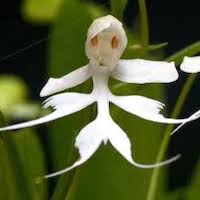
|
Habenaria crinifera Lindl. It flowers in August and September in southern India in the Western Ghats. Usage: Tubers are used to treat headache by the tribes living in the Kudremukh National Park in Karnataka. |
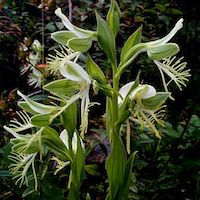
|
Habenaria davidii Franch. Syn. Habenaria leucopecten Schltr. Chinese name: Changjuyufenghua (Long distance jade phoenix flower) Chinese medicinal name; Shuangshencao It flowers from June to August. This endemic species is found in forests, thickets, and grasslands in a crescent from Hubei, Yunnan and Guizhou to Sichuan, Yunnan and southern Xizang Yunnan and Tibet. Herbal Usage: Roots are used in Chi- nese herbal medicine to reduce swelling and to protect the kidneys. The herb is used to treat hernia and firm swellings of the lymph nodes. |
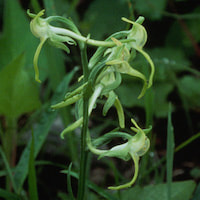
|
Habenaria delavayi Finet Chinese name: Houbanyufenghua (thick petal jade phoenix flower) Chinese medicinal names: Jishenshen (chicken kidney ginseng); Duiduishen (paired ginseng) Flowering season is May to August in China occurring in Sichuan, Guizhou, Yunnan and Tibet. Herbal Usage: Jishenshen is collected in autumn from Sichuan, Guizhou, Yunnan and Tibet. Tubers are either used fresh or dried for storage. Sometimes used as a tonic, it is also suitable for lumbago, weakness of “kidney”, dizziness, tinnitus, hernia and neurosis. It is reputed to strengthen the body. |
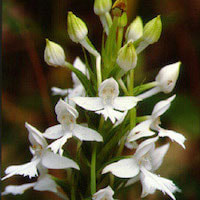
|
Habenaria dentata (Sw.) Schltr. Chinese names: Emaoyufeng Hua (feather jade phoenix flower), Baifeng Lan (white phoenix orchid), Dalucao (large heron grass), Yufeng Lan (jade phoenix), Dongpuyufeng Lan (Dongpu flaked teeth heron orchid); Dongfubaifeng Lan (Dongpu white phoenix/ white heron/phoenix orchid); Chipianlu Lan; Emaoyufenghua (goose-feather jade blossom) Chinese medicinal names: Shuangshenzi (two kidney son); Baihuacao (white flower herb); Tianaebaodan (swan carrying an egg); Yufenghuagen (jade-phoenix-flower root); Duiduishen (double ginseng) Taiwanese name: Bai Feng Lan (White phoenix orchid) Thai names: Naang Oua Noi, Nang ua noi It has a wide distribution that extends from the Ryukyu Islands of Japan to Taiwan and Hong Kong across southern in Fujian, Guangdong, Hong Kong, Guizhou and Yunnan to the Philippines, Indonesia, Indochina, Thailand, Myanmar, Nepal and Himalayan India. Plants for medicinal use are collected in autumn. Herbal Usage: CTM mentions that stems “benefit the lungs and kidneys” and are diuretic, anti-inflammatory and can detoxify. Stems are used to treat weak kidneys, impotence, stomach ache, orchitis, dysuria, swollen kidneys, carbuncles and coughs caused by tuberculosis. |
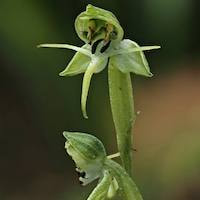
|
Habenaria diphylla (Nimmo) Dalzel Syn. Habenaria humistrata Rolfe ex Downie Thai name: Tupmup mot lin It is found in damp locations and on rocks in forests or valleys. It flowers in June in China, July to September or just August in India. Herbal Usage: The whole plant is used for treating insect bites in Thailand. Flowers popularly known as Jeevahi Purusharatna are used to treat asthma in the Western Ghats. |
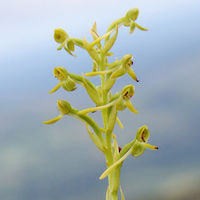
|
Habenaria diplonema Schltr. Chinese name: Xiaoqiaoyufeng Hua Chinese herbal name: Shuangxianerye Lan (two thread, two leafed orchid) An endemic species, found in northern Fujian, southwest Yunnan and southwest Sichuan. Herbal Usage: Herbs are obtained from Yunnan. Roots are used to improve kidney and liver function and to regulate menstruation. |
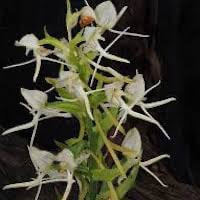
|
Habenaria fordii Rolfe Chinese name: Changjukuorui Lan (long distance broad pistil orchid), Xianbanyufeng Hua Inflorescence is many-flowered. Flowers are white and appear in July and August. It is an endemic species, distributed in uah Guangdong, Guangxi and Yunnan, in damp locations and on soil-covered rocks in forests and along valleys. Herbal Usage: Herbs are obtained from Guangxi and Yunnan. Root is used to treat indigestion in children. |
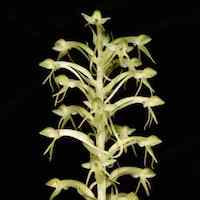
|
Habenaria furcifera Lindl. Syn. Habenaria ovalifolia Chinese name: Mihuayufeng Hua This is a terrestrial herb found in deciduous forests along moist slopes besides streams in western Peninsular India, Pakistan, Nepal, Bhutan, Sikkim, Myanmar, China and Thailand and Laos. Flowering period is August to September in India, with a more extended period in some parts. Herbal Usage: Tubers are used in Ayurveda to treat wasting diseases, fever blood disorders, hemorrhage and fainting. A paste of this orchid is used for cuts, wounds and snake bites. |
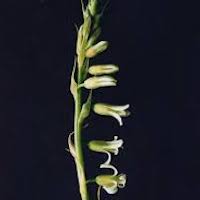
|
Habenaria hollandiana Santapau Plant is robust, erect, terrestrial, with prominent longitudinal veins, that is distributed in eastern Himalaya, Assam and the Eastern Ghats. Herbal Usage: Kondareddies and Valmikis of Andra Pradesh use a fresh paste of the plant to treat scorpion stings. Tubers are also made into a paste to treat scorpion stings and maggot-infected sores in Bangladesh. |
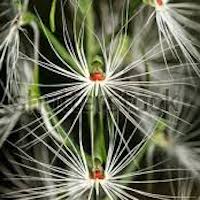
|
Habenaria limprichtii Schltr. Chinese name: Kuanyaogeyufeng Hua A robust terrestrial herb. Floral bracts are large, green, lanceolate. Sepals are light green. Flowering season is June to August in China and July to August in Thailand. The species is found in thickets and grasslands in northern Thailand. Herbal Usage: In China, it is used for “feminine nourishment”, and to treat nephritis and improve renal function. Oestrogens made their first appearance on Earth in fungi and oestrogenic compounds are quite prevalent in plants. |
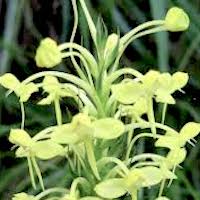
|
Habenaria linguella Lindl. Chinese name and medicinal name: Poshen The species occurs in forests and grasslands at 500–2500 m in Guangdong, Guangxi, Guizhou, Yunnan and Hong Kong; also in Vietnam. Herbal Usage: The plant is used to clear “heaty lungs”. A decoction is made with 9–15 g of the herb. |
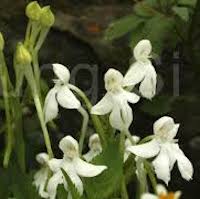
|
Habenaria longicorniculata J Graham Syn. Habenaria longecalcarata A. Rich. Indian name: Devasunda. Tamil name: Kozhikilangu Japanese name: Oze-no-sawa-tombo It flowers in July to September in the Western Ghats; August to November in Tamil Nadu. It is found at 800–1900 m, extending to Orissa and Bihar in the north-East. Herbal Usage: Natti Vaidyas (folk practitioners) reported during a meeting that fresh tubers were eaten to reduce scrotal enlargement. All parts of the plant can be used to control pain and swelling. A paste of crushed tuber is mixed with an equal volume of turmeric powder, and the resultant colored paste is applied to the affected site to correct leukoderma. |
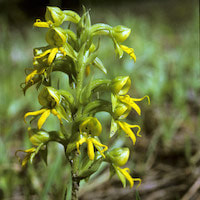
|
Habenaria marginata Colebr. Indian and Bangladeshi name: Humari Common Name: Golden Yellow Habenaria It flowers from July, and fruits ripen by November in India. Flowering season is August to September in Bhutan and October to November in Nepal. It is a small terrestrial herb distributed over a large area that extends from Pakistan across northern India to Orissa, Nepal, Bhutan and Bangladesh to Myanmar and Thailand. Herbal Usage: In the Niyamgiri Hills of Orissa in India, it is used to treat malignant ulcers. It is also reported as being used in Bangladesh to treat malignant ulcers Tubers are cooked and eaten as a vegetable at the Sanjay National Park in Madhya Pradesh. |
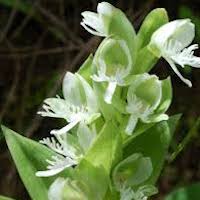
|
Habenaria pectinata D. Don Chinese name: Jianyeyufeng Hua Indian name: Safed musli Plants are terrestrial. Flowering season is August. The species occurs in forests around 1800 m in temperate northeast India, Nepal and Yunnan. It was observed to inhabit shady banks on the edges of temperate forests at 2000–3000 m in Indian Himalayas. Herbal Usage: The leaves are crushed and used to treat snake bites in India. Mixed with condiments, the tubers provide an herbal remedy for arthritis. Its usage in China is different. Here, the whole plant is used to treat coughs arising from weakness, nephritis and pain at the waist. |
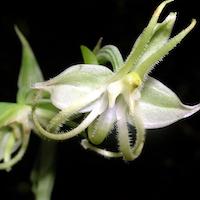
|
Habenaria petelotii Gagnep. Chinese name: Liebanyufeng Hua Chinese medicinal name: Danshencao Taiwanese name: You Mao Yu Feng Lan (Little feather jade phoenix orchid) The species is found in forests and along valleys in the southern provinces of China at 300–1600 m (Anhui, Zhejiang, Fujian, Guangdong, Jiangxi, Hunan, Guizhou, Guangxi, southeast Yunnan) and in Vietnam. Herbal Usage: It is used in China to treat renal insufficiency, coughs from “heat lungs”, external injuries with bleeding, erectile dysfunction, hernia and nocturnal bed-wetting in children. |

|
Habenaria plantaginea Lindl. Bangladeshi name: Kusuma gadda This common Habenaria species is found in the under-storey in the dry zone forests in Sri Lanka, all over India below 900 m (Abraham and Vatsala) and in Bhutan between 1000 and 2500 m. It also occurs in Bangladesh, Myanmar and the Lesser Sunda Islands. Herbal Usage: Tubers are used to treat wasting diseases, fever, disorders of blood, hemorrhage and fainting. In the Eastern Ghats of Andra Pradesh, tubers together with black pepper and garlic, are pounded into a paste and converted into tablets. One or two tablets are given to relieve chest pain and stomach ache. In Bangladesh, tubers are also used to treat chest pain and stomach ache. |
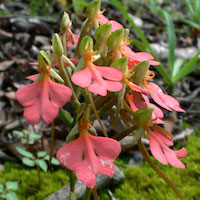
|
Habenaria rhodocheila Hance Chinese name and medicinal name: Chenghuangyufeng Hua Thai names: Sanh hin, Lin mangkon, Pat daeng Thai and Malaysian varieties bear more flowers, and their colour is more intense. Flowering season is September to November. Stem and leaves dry out after flowering and remain dormant during the dry season. When the rains appear in May, vegetative growth begins. The species is widely distributed in Southeast Asia and from Hainan northwards to Guangdong, Hong Kong, Guangxi, Guizhou, Jiangxi and Fujian. Herbal Usage: In China, it is applied on finger ulcers to promote their healing. Decoction prepared with 3–9 g of the herb is used to treat ‘heat-ness’, swellings, traumatic injuries and for pain relief |

|
Habenaria roxburghii, Nicolson Syn. Habenaria platyphylla Spreng It occurs in the plains and scrub jungle up to 800 m, often sheltered within thorny bushes and on exposed rocks. Herbal Usage: In Tamil Nadu, it is used in Ayurvedic medicines. Ayurveda practitioners use the tubers to treat wasting diseases, fever, disorders of the blood, haemorrhage and fainting. About 10–15 g of the tubers is crushed with 2–3 g of pepper and garlic, and the extract is taken orally for snake bites by the Konda reddis in Andra Pradesh. |
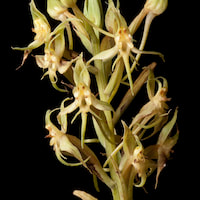
|
Habenaria stenopetala Lindl. Chinese name: Xiabanyufenghua Chinese medicinal name: Jishencao A terrestrial herb of variable height. It flowers in August in Thailand, and to October in China, also August to October in India. It is found in open areas or in dipterocarp forests in Pakistan, northern India, Southeast Asia and in Tibet, Guizhou, Taiwan and the Ryukyu Islands of Japan at 300–1800 m. Herbal Usage: In CTM it is used to treat erectile dysfunction and hernias. It enhances kidney and sexual functions. The medicine is prepared by boiling 3–9 g of the dried plant. There are 54 species of Habenaria in China, of which 13 are used in Chinese herbal medicine. An equal number of Habenaria species are used medicinally in India. The usages in the two large Asian nations do not overlap and many species which occur in both countries may be used in one but not in the other. |
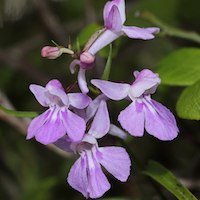
|
Hemipilia cordifolia Lindl. Syn. Hemipelia yunnanensis (Finet) Schltr. Chinese names: Dianshehui Lan (Yunnan beak tongue orchid), Xinyeshehui Lan Chinese medicinal name: Niudanshen Taiwanese name: Yu Shan Yi Ye Lan (Jade moun- tain single leaf orchid) The species is distributed in Nepal, Bhutan, northeast India, Myanmar, Xizang Yunnan, Sichuan at 1500–3500 m and in Taiwan. On the island, it is found in the Central Mountain Range at 2500–3000 m on grassland. Herbal Usage: Chinese herbalists believe that the root benefits the kidney. It is diuretic, and is also used to treat hernia and kidney diseases. A decoction is made with 6–15 g of the herb |
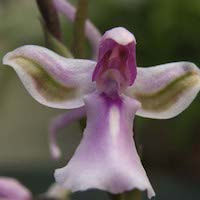
|
Hemipilia flabellata Bureau & Franch Chinese names: Duyeyizhi Hua (one leaf flower), Meteor rain grass, Shanchunshehui Lan Chinese medicinal name: Duyeyizhi Hua (soli- tary leaf flower) It grows in damp, humus-rich soil, sometimes in mossy places on the ground or in rock crevices at the edge of lime-stone forests at 2500–3200 m in Sichuan, Yunnan and Tibet and in the Shan state of Myanmar. Herbal Usage: Herb is obtained from Sichuan, Yunnan and Guizhou. The drug prepared from the orchid is used to “moisten the lungs”, and is used to treat dry coughs, tuberculosis, trauma, excessive sweating and renal colic. |
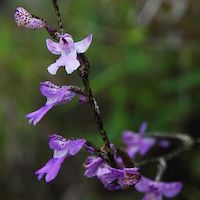
|
Hemipiliopsis purpureopunctata (K.Y. Lang) Y.B. Luo & S.C. Chen Syn. Habenaria purpureopunctata K.Y. Flowering season is June to July. It occurs in broad-leaved evergreen forest, alpine oak forest, grassy slopes and sandy river banks in southeast Xizang and northeast India. Herbal Usage: In China, the herb is used to relax tense muscles. The entire plant is used. |
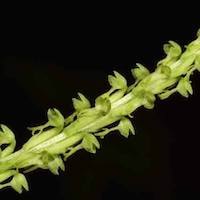
|
Herminium lanceum (Thunb. ex Sw.) Vuijk Chinese names: Shuangchunjiaopan Lan (two lips, angle plate orchid), Shuangshencao (two kidney grass), Chachunjiaopan Lan Chinese medicinal name: Yaozicao It is a terrestrial herb, thriving among grasses in forests, thickets and grassy slopes, and among rocks at 1100–3500 m. It flowers from June to August or September in mainland China, April to September in Taiwan, July to August in Sikkim, July to October in Bhutan and June to August in Nepal. Herb is obtained from Shandong to Tibet and from Dongbei (Northeast China, Manchuria) to Guangxi and Taiwan. Herbal Usage: The root is said to benefit the lung; it is used to treat tuberculosis. It also benefits the kidney, strengthens the muscles and bones and stops bleeding. The decoction is prepared with 6–15 g of the herb. In India, it enjoys usage as a nutrient or a tonic. |
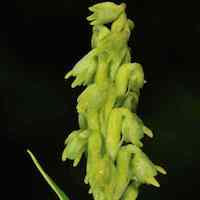
|
Herminium monorchis (L.) R. Br. Chinese names: Jiaopan Lan (angle plate orchid), Ren shen guo Chinese medicinal name: Rentouqi Flowering period is June to September. Two ovoid tubers are formed each season, the larger going on to produce leaves and flower the following season, the smaller detaching to start a new plant. Its principal form of reproduction is vegetative. It has wide distribution across temperate Eurasia from Japan across Korea, northern China and Russia, and all of Europe. It also occurs in central Asia and the Himalayas. This terrestrial orchid is found in moist locations, in damp grassland or short turf, on non-calcareous soils. Herbal Usage: Herb is obtained from the north- ern provinces and the Yangzi region. Entire plant is used to enrich yin. It benefits the “kidney and stomach” and regulates menstruation. It is prescribed for a nervous breakdown, confu- sion, insomnia, thirst, anorexia, and precocious greying of hair, or to strengthen and nourish a weak body. In a small, non-controlled, open trial of 93 patients suffering from chronic constipation, oral treatment with glucomannan 1 g three times a day resulted in improvement and there were no side effects. |
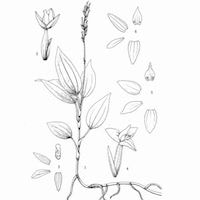
|
Hetaeria obliqua Blume Chinese name: Xiebanfanchun Lan Malay name: Pokok tumbak hutan The species is found in lowland forests in Sumatra, Thailand, Nicobar Islands, Peninsular Malaysia and Borneo. Herbal Usage: Leaves were pounded to make a poultice which was used to treat sores and infected wounds in Peninsular Malaysia. Leaves of a second orchid, Thrixspermum pardale, were added in making the poultice for treating ulcers of the nose by villagers in Malaya. |
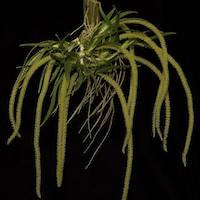
|
Hippeophyllum scortechinii (Hook f.) Schltr. Malay name: Setawar baker perah This epiphytic species is distributed in Sumatra, the Malay Peninsula, Java, Borneo and Sulawesi. It is found in the lowlands of Pahang and Perak in shady locations, usually near rivers. Herbal Usage: Malays in Kuala Lipis, a town in Pahang, Peninsular Malaysia, squeezed the hot juice from heated leaves of this orchid into the ear to relieve earache |

|
Holcoglossum amesianum (Rchb. f.) Christenson Chinese names: Dagencaoshe Lan (big slot tongue orchid), Wanda Lan (ten thousand generation orchid), Diao lan (hanging orchid), Jiegucao (bone setting herb) Chinese medicinal name: Jiuzhualong Myanmar name: Moe kadol It is epiphytic on trees growing on limestone rocks in the shade. Herbal Usage: CTM states the whole plant as an antipyretic. It diminishes inflammation, improves blood flow, and removes gas and humidity. It is used to treat malaria, sore throat, mastitis, urinary infection, rheumatic pain, backache, irregular menses, traumatic bleeding and traumatic fractures. |
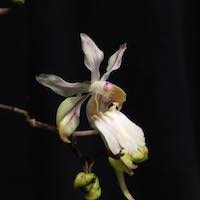
|
Holcoglossum quasipinifolium (Hayata) Schltr. Chinese names: Songye Lan (pine leaf orchid), (pine needle orchid), Qiaochun Lan (sledge lip orchid), Caoshe Lan (slot tongue orchid); Yeludongqing (green leaf pine). This semi-terete leaf orchid, once thought to be was endemic in Taiwan, where it occurs invthe Central Mountain Range at 2000–2500 m, often growing on the branches of Quercus. Herbal Usage: The whole plant is used to remove wind and dampness. It causes diuresis and is used for joint pains. It has a broader range of medicinal usage being also used to treat varied infections (malaria, sore throat, mastitis and urinary tract infection) and bleeding disorders (irregular menstruation and traumatic bleeding). |

|
Ipsea speciosa Lindl. Common name: Daffodil orchid Sinhalese names: Kiri Walla Kada; Naga-maru Ala (tuber causing the sister’s death) Herbal Usage: Tubers are sought after by sorcerers for making charms and love potions and by village quacks and medicine-men for use as an aphrodisiac. The species is already rare, and may be rendered extinct through overcollection. It is said to have aphrodisiac properties. The popular Singhalese name Naga-maru Ala translates as “the tuber that caused a sister’s death”. |

|
Ischnogyne manadarinanum (Kranzl.) Schltr. Chinese name: Shoufang Lan (slim house orchid) Flowering season is May to June. This saxicolous orchid grows on rocks in forest and ravines at 700–1500 m in Shaanxi, Gansu, Hubei, Sichuan and Guizhou in China. Herbal Usage: Herb is obtained from Shanxi, Hubei and Sichuan. In China, the whole plant is sometimes used to treat tuberculous patients who cough, and bronchitis. The herb is obtained from Shaanxi, Hubei and Sichuan. |
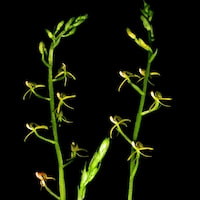
|
Liparis bootanensis Griff. Syn. Liparis plicata Franch & Savat. Chinese name: Lianchiyangersuan (sickle wing goat ear garlic). In Hong Kong and Bhutan Twayblade Chinese medicinal name: Jiuliandeng (nine lotus lamps) Taiwanese name: single leaf Liparis Japanese name: Chi-kei-ran (bamboo grass Cymbidium) Herb is epiphytic or lithophytic, with small, clustered, ovoid pseudobulbs. It is distributed from Nepal to south- ern China up to Hainan, Hong Kong, Taiwan, Japan (Ryukyu Islands, Kyushu), Korea, Indochina, Thailand, Philippines, Borneo, Java, the Langkawi Islands and Myanmar at 800–2300 m. Herbal Usage: Botanically, in CTM, Jiuliandeng, the entire plant is used to treat fever, enrich qi and blood, treat tuberculosis, lymph node enlargement in tuberculosis, sores and ulcers, abdominal pain, distension and schistosomiasis. Cooked with pork, it provides a remedy for coughs and sore throat. |
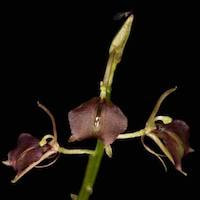
|
Liparis cathcartii Hook.f. Chinese name: Erzheyangersuan (two fold sheep ear garlic It is a small terrestrial herb. It is distributed only in Sichuan and central and northwest Yunnan in China, but it also occurs in Laos, Myanmar, northeast India, Bhutan and Nepal. Herbal Usage: Chinese herbal medicine employs the whole plant to stop pain and to clear colds. |
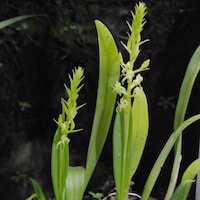
|
Liparis cespitosa (Lam.) Lindl. Chinese name: Xiaohuayanger Suan (small flowered goat ear garlic), Shisuantou (stone garlic), Yeshengyangersuan (goat ear garlic), Congshen-gyangersuan It flowers in September, January and March in Sri Lanka. The species enjoys a wide distribution from East Africa across the Himalayan foothills, southern China and Southeast Asia to the Pacific Islands. Herbal Usage: The whole plant is used in Taiwan to treat fever and remove toxins. In CTM terminology, it cools blood and stops bleeding. |
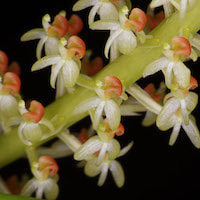
|
Liparis condylobulbon Rchb. f. Syn. Liparis treubii J.J. Smith Indonesian name: Anggrek gajang It is distributed from Myanmar, Thailand to Malaysia, Indonesia, the Philippines eastwards to Fiji. Herbal Usage: Natives in Sulawesi (Indonesia) once believed that chewing on the young pseudobulbs and rubbing the heated leaves of the orchid on the abdomen facilitated bowel movements and relieved a distended stomach |
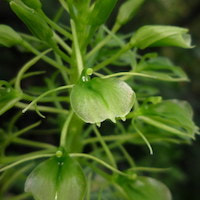
|
Liparis cordifolia Hook. f. Syn. Liparis argentopunctata Aver., Liparis keitaoensis Hayata Chinese name: Xinyeyangersuan (Silver cricket orchid). Phytochemistry: Two alkaloids, keitaonine and keitine were isolated from L. keitaoensis (¼ L. cordifolia). Keitaonine is a pyrrolizidine- based alkaloid, an ester of 3-methoxy-malaxinic acid and laburnine. Keitine is an aglycone of keitaoine but it is possible that it might not exist in the living plant. Herbal Usage: A decoction of the root is a Taiwanese remedy for abdominal pain |
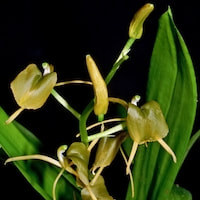
|
Liparis distans C.B. Clarke Syn. Liparis yunnanensis Rolfe Chinese names: Yunnan yanger Lan (Yunnan sheep ear orchid), Dahuayan-gersuan (big flower sheep ear garlic) Yunnan Yangercao (Yunnan sheep ear herb) Chinese medicinal name: Hushitou It enjoys a wide distribution from Guangdong, Guangxi, Guizhou, Yunnan, Sichuan and Tibet in China to Assam, Thailand, Laos Cambodia, Vietnam and the Philippines. Herbal Usage: Herb is obtained from Guangdong, Guangxi, Yunnan, Sichuan and Tibet. Entire plant is used to treat pneumonia. A decoction is made with 6–16 g of the whole plant |
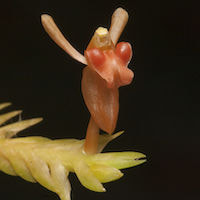
|
Liparis dunnii Rolfe Chinese names: Dachunyangersuan (big lip sheep ear garlic), Fujianyangersuan (Fujian Province goat ear garlic) Chinese medicinal name: Shuangyejinqiang This narrowly-endemic species was originally discovered during a botanical expedition in cenral Fujian province in 1903 growing on rocks at Tze Chuk Hang |
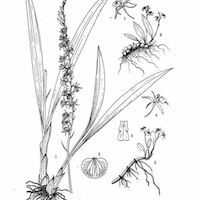
|
Liparis fargesii Finet Chinese name: Xiaoyangersuan (small lip sheep ear garlic) Chinese medicinal name: Shimi It is found at 300–1700 m in Southern Gansu, Guizhou, Hubei, Hunan, Shaanxi, Sichuan and Yunnan. The plant is cold-resistant. Herbal Usage: Herb is obtained from Shanxi, Sichuan and Gansu. Entire plant is used in Chi- nese herbal medicine. It benefits the lungs, reduces heat, stops coughs, and is prescribed for tuberculosis, heat coughs and whooping cough. To prepare a decoction, 6–9 g of the dried herb is used at a time |
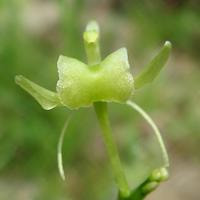
|
Liparis kumokiri F. Maek. Chinese name: Xuesancao (spread snow grass) Japanese name: Kumokiri so The medicinal herb comes from Shanxi It is common terrestrial herb in the Russian Far East, Korea and in Japan between Hokkaido and Kyushu. Herbal Usage: Roots and stem are used to strengthen the constitution, improve blood and air flow. It stops persistent intermenstrual bleeding and cures discharge. |
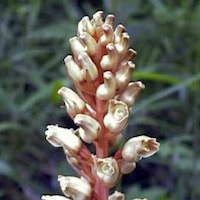
|
Liparis nakaharae Hayata Chinese name: Aochunyangersuan Herbal Usage: It is used in Taiwanese folk medicine to treat cancer. |
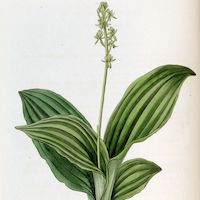
|
Liparis nervosa (Thunb.) Lindl. Syn. Liparis bicallosa (D. Don) Schltr. Chinese names: Honghuayanger Suan (red flowered goat eating garlic), Hei Lan (black orchid), Shixiagong (stone shrimp), Banbian Lan (half sided orchid) Roupangxie (crab meat); Lidihao (well grounded); Maocigu (hairy kind aunt); Yanyu (stone yam); Tiepashu (Steel rake); Daoyanti (dangling on the cliff); Zuozicao (moving seed herb); Roulongjian (dragon meat arrow). In Hong Kong: nerved twayblade, purple star Liparis Chinese medicinal name: Jianxueqing Japanese name: Koku ran Description: A small terrestrial herb that flowers in February to July on the Chinese mainland and in June and July in Taiwan. In Sri Lanka, it flowers in February to March, and again in June to September. It is an extremely variable, pan-tropical species which enjoys a wide distribution throughout the humid tropical and sub-tropical regions. Phytochemistry: Nervosin was isolated from this plant. It is an ester of lindelofidine and nervosinic acid, the latter an arabinosyl-glucosyl derivative of nervogenic acid which is a starting point for alkaloids. All alkaloids of L. nervosa inhibited each of the 12 bacterial and 4 fungal species tested with a paper diffusion method. Anti-oxidant effect ranged from 5 to 93.5 % at concentrations of 0.5 to 100 mcg/ml. Recently, 6 new pyrrolizidine alkaloids and two previously identified alkaloids were isolated that showed antioxidant activity on RAW264.7 macrophages. Herbal Usage: The whole plant is used as an antipyretic, to cool blood, stop bleeding and reduce heat in the lungs. It is used for cramps in children, haemetemesis, coughs, and rheumatic pain. It is also used as an emollient for traumatic injuries, skin infection and snake bites. It is reputed to reduce inflammation, dissolve extravasated blood and cause swellings to subside. The herb is collected throughout the year. For decoction, 3–6 g of the fresh herb or 6–12 g of dried herb are used. For external use, the whole plant is pounded and soaked in wine. Tubers are used to treat stomach disorders and a paste is applied on chronic ulcers in Nepal. |
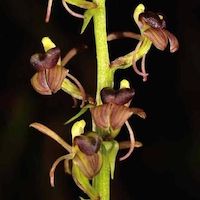
|
Liparis odorata (Willd.) Lindl. Syn. Liparis paradoxa (Lindl.) Rchb.f. Chinese name: Xianghuayangersuan Chinese medicinal name: Erxiantao It is a terrestrial herb, with herbaceous, conspicuously veined, petiole sheath-like. Inflorescence. In India, it flowers from July to September, in Bhutan, from May to September, in Nepal, July and in China, April to July or August. Herbal Usage: Mr. van Rheede wrote in his Hortus Indicus Malabaricus that this species was used to treat elephantiasis. This plant is used in Malabar to treat elephantiasis. Tribals in Karnataka use the orchid pseudobulb. They also use its juice extracted from the leaves, which is used to treat fever and oedema. Juice from the roots was used to treat burns, inflammation, gangrene and tumours.
|
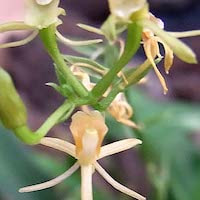
|
Liparis petiolata (D. Don) P.F. Hunt & Summerh. Chinese name: Bingyeyangersuan (handle leaf sheep ear garlic) Description: This is a terrestrial herb with ovoid pseudobulbs. The species is found near streams at 1000–2900 m in Hunan, Jiangxi, Guangxi, southern Yunnan and southeast Xizang. It is also found in Vietnam, Thailand, Bhutan, Nepal and northeast India. Herbal Usage: It benefits the lungs. |
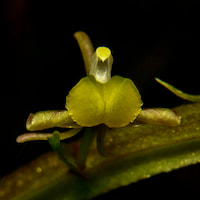
|
Liparis rheedii Lindl. Indian Name: Simil It is a terrestrial herb with pseudobulbs close to one another. The colour of the plant and its flowers is dependent on the amount of light that it receives. Plants growing in the shade are deep purple whereas those growing in the light are a pure green. The species occurs in mountain forests from southern India, across Thailand, Indochina, Malaysia and Indonesia to New Guinea. Herbal Usage: It is widely used as a tonic in Karnataka. It is one of the eight ingredients of the Ayurvedic drug known as Ashtavarga. The root is used by the hill tribes in Orissa to treat cholera. About 250 g of root is decocted in a liter of water until the volume is reduced to 333 ml. After cooling, 5 ml of the decoction is mixed with 2 ml of honey and orally administered twice a day on an empty stomach for 15–21 days as a remedy for cholera. |
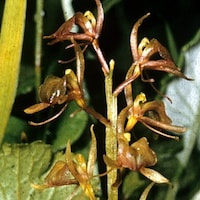
|
Liparis Rostrata Rchb. f. Chinese name: Chitu yangersuan Pseudobulbs are small, ovoid and produces a stem from its base. Flowers are tiny with linear yellowish-green sepals, dark purple, filiform petals. It is distributed from northern Pakistan to western Nepal, southern Xizang and at Gaoligongshan in Yunnan, on soil-covered rocks. Usage: Tubers are used to treat stomach disorders in India and it is also used as a tonic. |
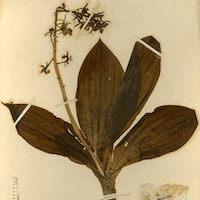
|
Liparis sootenzanensis Fukuyama Syn. Liparis nigra Seidenf. var. sootenzanensis Fukuyama Chinese name: Chatianshanyangersuan; Zhihuayangersuan (purple flower sheep ear garlic). In Hong Kong: giant purple Liparis This robust terrestrial herb is distributed from Yunnan to Guangxi, Guangdong, Hainan, Taiwan, Hong Kong and Lantau Islands. Herbal Usage: The whole herb is used to treat arthritis, numbness and skin disease in Vietnam. |
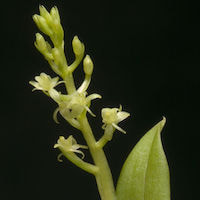
|
Liparis stricklandiana Rchb. f. Chinese names: Shanchunyangersuan (fan lip sheep ear garlic), Luhuayangersuan (green flower sheep ear garlic) It is an epiphytic species distributed from Hong Kong, China (Guangdong, Guangxi, Yunnan) and Tibet, Vietnam, Sikkim, Bhutan and Nepal, at in forests on hill slopes. Herbal Usage: Herb is used to treat sores, abscesses and ulcers. |
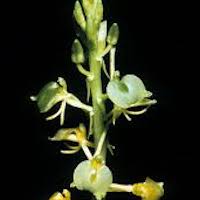
|
Liparis tschangii Schltr. Chinese name: Xizang Yangersuan (Tibetan sheep ear garlic), Zhebao Yangersuan It found in Tibet, south-west Sichuan, Yunnan, Laos, Thailand and Vietnam at 1100–1700 m. Herbal Usage: Herb is obtained from Tibet and Yunnan. Stems are used in Chinese herbal medicine to improve blood flow and stop bleeding, especially persistent vaginal bleeding. |
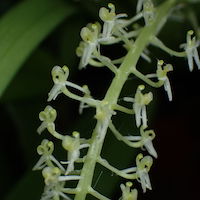
|
Liparis viridiflora (Blume) Lindl. Chinese names: Luhuayanger Lan (green flower sheep ear orchid), Changjing-yangersuan (long stem sheep ear garlic) Plants are lithophytic and have cylindrical pseudobulbs. It flowers in September to December in China, November in Assam and Sikkim and August to September in the Western Ghats. It is an extremely widespread and widely distributed from Sri Lanka and the tropical Himalayas across southern China and Southeast Asia to the Pacific Islands. Herbal Usage: Stems are used to treat coughs, poisoning, fever and fractures. Roots are used to treat hernia. |

|
Ludisia discolor (Ker.-Gawl.) A. Rich. Chinese names: Xueye Lan (blood leaf orchid), Yisexueye Lan (special colour blood leaf orchid), Shishangou (lotus on the rock): In Hong Kong: rock silk-worm, twisty-flowered orchid Chinese medicinal names: Shishangou; Xueye Lan; Shichan (rock moth) Zhenjincao (genu- ine golden grass) Thai name: Wan nam thong Malay names: Beledu merah (red velvet plant), Baldu merah (red plant) (only applicable to some varieties) Plant has a creeping rhizome. It flowers in March in Singapore. Herbal Usage: The whole plant is used in TCM and it may be collected throughout the year. It is used fresh and also sun-dried. It is sweet, slightly astringent, and ‘cool’. It nourishes the lungs, regulates body fluids, purifies the blood, and is anti- inflammatory. In Hong Kong, it is used to treat hemoptysis caused by pulmonary tuberculosis, neurasthenia, anorexia, employing 3–10 g in decoction. It relieves coughs. On the Chinese mainland, entire plant is used in TCM to enrich yin as it benefits the lungs, cools the blood and stops bleeding. It is used to treat pulmonary tuberculosis, anorexia and neurosis. Rhizomes are listed as 1 of 57 herbal remedies for insect bites in old Thai remedies |
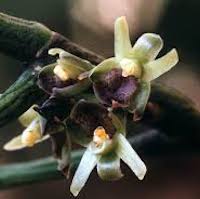
|
Luisia brachystachys (Lindl.) Bl. Syn. Luisia indivisa King & Pantl. Chinese name: Xiaohuachaizigu It is a tough, robust epiphyte with terete stems and leaves. It is distributed in southern Yunnan, Thailand, Bhutan, India, Myanmar and Vietnam, occurring at 600–1300 m. It is fragrant and 2 important chemicals were found for perfumery application. These are- methyl 2,4-dihydroxy-6-methylbenzoate and methyl 2,4-dihydroxy-3,6- dimethylbenzoate. Herbal Usage: it is used as a nutrient and emollient for rheumatic pain. Plant is pounded to make a poultice for the treatment of boils, abscesses and tumors. |
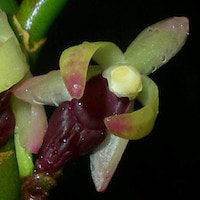
|
Luisia curtisii Seidenf. Thai name: Kho sing It is distributed in Thailand, Cambodia, Vietnam, Peninsular Malaysia, Borneo and the Philippines. Herbal Usage: The whole plant is called diuretic in Thailand. |
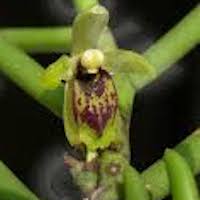
|
Luisia hancockii Rolfe Chinese name: Xianyechaizigu, Qianyechaizigu (slim leaf hairpin) It is an endemic, terete, monopodial orchid which occurs as an epiphyte on trees in sparse woods. Herbal Usage: Entire plant is used to clear gas and phlegm, remove toxins and reduce swelling. The herb comes from Zhejiang Province. |
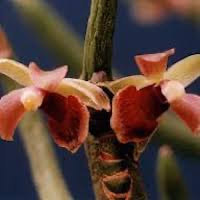
|
Luisia morsei Rolfe Chinese names: Dayangjiao (big goat horn), Chaizigu (hairpin strand), Jinhuancao (gold ring grass), Shucong (tree onion). Chinese medicinal names: Chaizigu (hairpin strand); Jinchagu (gold hairpin section); Sanshi Gen (30 root); Songjisheng (pine para- site); Chongjisheng (worm parasite) Haibanhu (sea strip tiger) Tanxiangxian (sandlewood thread) Longxucao (dragon beard grass) Description: It is an epiphyte from hilly forests of southern China (Hainan, Guangxi, Guizhou and Yunnan), Japan, Vietnam, Laos and Thailand. Herbal Usage: TCM states that the whole plant promotes movement of “wind”, boosts yang elements, and stops vomiting. It detoxifies, removes gas and dampness and is used in Taiwan for the treatment of infantile paralysis, rheumatism, malaria, oedema, hypertension and for removal of poisons. It can also kill bugs. |
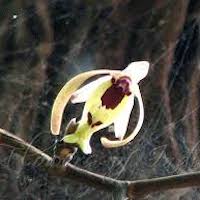
|
Luisia tenuifolia Blume Syn. Luisia birchea Blume This robust Orchid is distributed in southern India and prefers high elevations above 1500 m. It occurs in large clusters on tree trunks and is common in Peninsula. It also occurs in the Andaman and Nicobar Islands. Herbal Usage: The whole plant is pounded for use as an emollient. It is also applied as a poultice to heal swellings such as boils, abscesses and tumors. A powder prepared from the plant is mixed with vinegar to treat kidney disease, scalding, leucorrhoea and gonorrhea. |
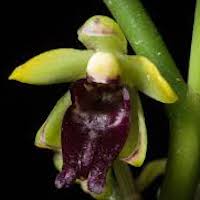
|
Luisia teres (Thunb.) Blume Chinese names: Jinchajiao (gold hairpin), Chaizigu (bunched hairpins), Yuanzhuchaizigu (round pillar hairpin), Yanggunzi (goat stick), Yangangdou (stony long bean), Xiaohuangcao (small yellow grass), Chachunchaizigu This is an epiphyte with long (55 cm), thin (4–5 mm), terete stems that carry many leaves. A Japanese variety has a solid maroon lip. Flowering season is March to May. It is found on tree trunks in exposed locations. Herbal Usage: The entire plant is used to reduce swelling especially edema caused by fractures. It is also used for treating tumors and as a counter-poison. It also prescribed for carcinoma and malaria. Taiwanese herbalists use it to reduce swelling and heal fractures. |
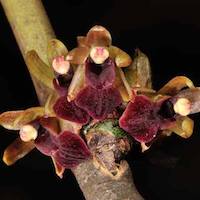
|
Luisia trichorrhiza (Hook.) Blume Nepalese name: Arjona Thai name: Kluai nam thai Phytochemistry: Small amounts of alkaloid are present in this orchid. Herbal Usage: In Thailand, the entire plant is used to treat liver dysfunction and diabetes mellitus. In Nepal, plant paste is applied on painful muscles for relief. In Bangladesh, roots re used to treat jaundice, muscle pain and diarrhea. |
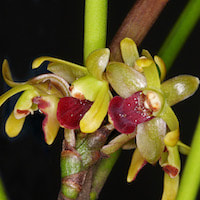
|
Luisia tristis (G.Forst.) Hook. f. Syn. Luisia teretifolia Gaudich., Luisia zeylandica Lindl. Indian and Bangladeshi name: Koira Nepalese names: Bori jhaar, Kuwaa ko keraa Sri Lankan name: Muwa kiriya (Stems like deer horns), soma valli (in Sanskrit) Thai name: Kluai nam thai Chinese medicinal name: Jinchaigu It is distributed from Bhutan, the Sikkim Himalayas to south India and Sri Lanka, and across Bengal and Myanmar to the Andamans, Thailand, Malaysia, the Philippines and New Caledonia. It is found at low elevations. Phytochemistry: A small amount of alkaloid is present. Herbal Usage: It is used in medicinal oils used to treatment of fractures by Sri Lankan Ayurvedic practitioners. A paste prepared with crushed plants is applied to boils, abscesses and tumors in Uttar Pradesh. Emollient made from the plant is used for abscesses and burns in Nepal, and juice from the leaves is used for treating chronic wounds. The juice is also used to get rid of worms. In Nepal, Bangladesh and Karnataka (India), stems are used to treat boils, burns and fractures. A paste of the dried plant with turmeric and ginger is taken three times a day for 10 days to treat jaundice. Root extract is used for myalia, and to stop diarrhoea in cattle. In Bisamkatak Orissa, locals call it koira. Valmikis of Viskhatnam district in Andhra Pradesh use a paste made with the entire plant, egg white, turmeric and calcium to apply as a plaster which is then and bound with a bandage on fractured limbs to set fractures. It is listed as a herbal remedy, Jinchaigu, in Zhongyao Bencao. However, L. zeylandica (¼ L. tristis) does not occur in China, and the herb is imported from India and Myanmar. In Yunnan, it is used to treat ‘heatiness’, remove toxins, cure malaria, pruritus, sore throat, otitis media and food poisoning. |
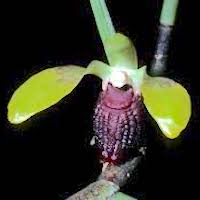
|
Luisia thailandica Seidenf. Thai name: Kluai nam thai yai It flowers in May and June and is found in northern and north-eastern Thailand, Myanmar, Laos and Vietnam. Herbal Usage: In Thailand, the whole plant is sometimes used to treat liver dysfunction and diabetes mellitus. |
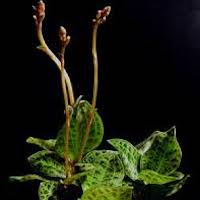
|
Macodes petola (Blume) Lindl. Indonesian names: Daun aksara (calligraphic leaf), Djaksara, Djukut sastra, Ki-aksara, Kidjaksara (Sundanese) Daun patola (Javanese) It is a Southeast Asian Jewel Orchid. It has beautiful, dark green leaves. It is distributed in Malaysia, Singapore and Indonesia. Indonesian legend says that this magical plant first arose from the fragments of a beautiful scarf belonging to a goddess. Herbal Usage: Juice extracted from leaves was recommended to be dropped into the eyes to correct myopia in Indonesia. |
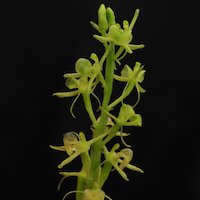
|
Malaxis monophyllos (Linn.) Sw. var. Monophyllos Syn. Liparis japonica (Miq.) Maxim Chinese name and medicinal name: Yangersuan (sheep ear garlic) Japanese name: Seitakasuzumushiso It occurs as a lithophyte on moss-laden rocks in shady locations in China (Dongbei, Shanxi, Hebei, Shaanxi, Gansu, Sichuan and Guizhou) and Japan. Flowering season is June to August. Herbal Usage: Its medicinal properties include- “stimulating blood circulation, regulating menstruation, haemostasis, relief of pain, strengthening the heart, tranquilising, stopping severe diarrhea, alleviating leucorrhea and relieving postpartum abdominal pain. It is also used as an emergency treatment for external injuries”. It can reduce inflammation, dissolve extravasated blood and cause swellings to subside. The whole plant is used to stop pain and bleeding, especially in cases of trauma, continuous inter-menstrual bleeding and discharge. |

|
Malaxis muscifera (Lindl.) Kuntze. Ayurvedic names: Jeevak, Jivaka, Chiranjivi, Dirghayu, Harsanga, Ksveda, Kurchasira, Pranda, Risvak, Sringaka, Svadu, (in Gahwal) Rishbhak, Chiranjiva, Dirghayu, Harsanga, Ksveda, Kurchasira, Pranda, Sringaka, Svadu, Banndhura, Dheera, Durdhara, Gopati, Indraksa, Kakuda, Matrika, Vrisha and Vrishnaba. Nepalese name: Jivaka This has one of the most interesting life-cycle. In the western Himalayas, it emerges a few days after snow melts in April. New plants commence their life by germinating from seed or from dormant apical buds on old pseudobulbs. The species is perennial and remains in vegetative phase during the first 2 years of growth. During the third or subsequent year, a flowering rachis emerges, completing flowering and fruiting in the brief summer. With the onset of winter in September, senescence of aerial parts occurs and underground tubers go into dormancy again. Herbal Usage: Jeevak is one important component of eight vitalising herbs (Jivaniya) mentioned in Caraka Samhita, the original Materia Medica of Ayurveda of Mahakashaya. These eight herbs are collectively referred to as Ashtavarga. Rishbhaka is said to be sweet in taste, and cold in potency. It pacifies varta and aggravates kapha and therefore it benefits hyperactive people but is unsuitable for overweight people. It is used to treat general debility and emaciation. In Garhwal, in Himalayas, the tonic is prepared by mixing dried, powdered pseudobulbs in boiled milk. It reduces fever, promotes spermatogenesis, and considered an aphrodisiac. In modern terminology, it is “anti-oxidant and anti-ageing”. In Nepal, paste is made from pseudobulbs to treat pruritus, fever and sores. In CTM, plant is antipyretic and detoxifies. It promotes regular menses and diuresis, It is used to treat sexual dysfunction, weak kidneys, coughs, discharges, menorrhagia and abdominal pain during the post-natal period |
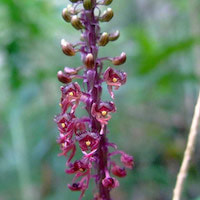
|
Malaxis versicolor (Lindl.) Abeyw. Syn. Microstylis vesicolor Lindl., Seidenfia versicolor Marg. and Szlach. The color of the plant and flowers are influenced by light intensity: pure green in bright light, deep purple in the shade, and yellowish inbetween. Herbal Usage: In the western part of the Indian peninsula, a potion made with the plant is used to treat fever, biliousness and infantile epilepsy. Also called Jeevak, it is a popular India medicinal herb that is used as a tonic and aphrodisiac in addition to its application for diverse medical conditions like fever, dysentery, rheumatism and even minor complaints like insect bites. It is supposed to boost fertility. This orchid (Jeevak) and Crepidium acuminatum (Rishbaka) are two important constituents of Astavarga, an Indian “rejuvenating” tonic that substitutes as aphrodisiac and semen booster |
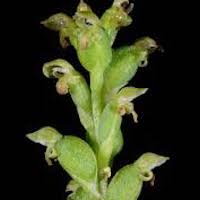
|
Microtis unifolia (Forst.) Rchb. f.Syn. Microtis formosana Schltr. ex Masam Chinese names: Jiuye Lan (garlic leaf orchid), Congye Lan (onion leaf orchid), Chinese medicinal names: Shuangshencao (two-kidney grass); Zhuitaocao (drop peach grass); Yigencong (single piece onion grass); Chengtuocao (weight grass) Maori name: Maikaika Plants intended for medicinal use are collected from the wild in April and May, washed and dried. Herbal Usage: The whole plant benefits the spleen and kidneys, and removes gas and humidity. It is used to treat weak spleen, anorexia, discharges, weak kidneys, backache and pain from hernia. To prepare a decoction, 30–60 g of the fresh plant or 15–30 g of the dried product is used. In Australia and New Zealand, the plant is eaten by Maori children during periods of stress. |
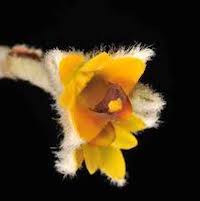
|
Mycaranthes pannea (Lindl.) S. C. Chen and J. J. Wood Syn.: Eria pannea Lindl. Chinese name: Zhiyemao Lan (finger leaf hairy orchid), Zhiyenimaolan Chinese medicinal name: Shucong Malay name: Kura kubong Thai name: Phrom hom mai Although its individual pseudobulb and leaves are small, the running rhizomes of M. pannea can stretch for several metres, completely covering the branches of a big tree. Usage: The plant is boiled and the decoction is used for bathing to relieve bone aches and ague (malaria or an unremitting fever) in Peninsular Malaysia, Thailand and India. The Kampti tribe in the Lohit community of Arunachal Pradesh, fresh leaves are made into a paste which is applied over dislocated joints to relieve pain and swelling. A similar usage is also prevalent in southern China, where M. pannea (Shucong) is used to improve blood circulation and for detoxification, to treat external injuries, fractures, lower back or leg pain, carbuncles and burns. It has a further use as an antidote for poisoning caused by poininous plants like Coriaria sinica, Aconitum carmichaelii, Gelsemium elegans, Corydalis incisa (Duan Chang Cao), phosphorus and zinc. |
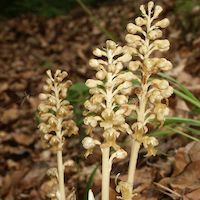
|
Neottia camtschatea (L.) Rchb. f. Chinese names: Kanchajianiaochao Lan (Kamchatka bird’s nest orchid), Beifangniaochao Lan It is found in the northern Chinese provinces of Xinjiang, Qinghai, Gansu, Shaanxi, Hebei and Nei Mongolia, and in Kazakhstan and eastern Siberia. Herbal Usage: The root-like stems are used in CTM to remove heat and toxic materials. |
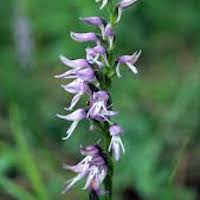
|
Neottianthe cucullata (L.) Schltr. Chinese names: Eryedoubei Lan (two leaf pocket quilt orchid), Doubei Lan (pocket quilt orchid Chinese medicinal name: Baibuhuanyangdan This small terrestrial orchid plant is 8–24 cm tall. It is found in forests, thickets and grassland in the subtropical or alpine forests of China, Nepal and the Eurasian steppes Herbal Usage: Entire plant is used in TCM as a cardiac stimulant, to improve blood flow, clear bruises and rejoin fractures. Its herbal usage extends to coma resulting from trauma. It can supposedly dissolve extravasated blood. The dried, powdered plant can be used as an oral medication. Rhizome are used in Nepal to make a tonic. |
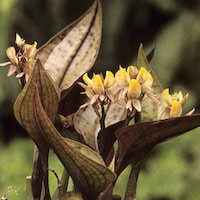
|
Nephelaphyllum pulchrum Blume It has a creeping rhizome, fusiform pseudobulbs and heart-shaped leaves. It is widely distributed in India and Southeast Asia at 300–1000 m. In Peninsular Malaysia and Borneo, it is restricted to the mountains. Phytochemistry: A small amount of alkaloid (0.01–0.1 % dry weight) is present. Herbal Usage: It is used to treat injuries and also considered to be Diuretic |
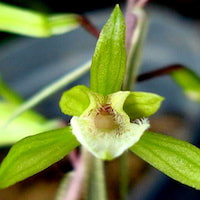
|
Nervilia concolor (Blume) Schltr. Syn. Nervilia aragoana Gaud. Chinese names: Dongyamaye Lan (East Asian leaf orchid), Yidianhong (one dot of red); Yidianguang (one spot of brightness); Qingtiankui (azure sky fan palm); Yu Lan (taro orchid); Yimianluo (gong orchid), Guangbu Yu Lan Chinese medicinal name: Bailingzi Malay names: Daun satu tahun (one leaf a year), Daun sahelai sa-tahun Thai names: Phaendin yen, Bua sandot It is distributed from the Deccan and the Himalayan foothills across Bangladesh, southern China (Xizang, Sichuan, Yunnan, Hubei), Southeast Asia to Papua New Guinea and Australia and to Taiwan and the Ryukyu Islands. Herbal Usage: In China, the whole plant is considered to be antipyretic. It stops bleeding. The herb encourages diuresis and subsidence of swellings and is used in the treatment of discharges, menorrhagia and weak kidneys. Between 9 and 15 g goes into the preparation of a decoction. It kills bugs. In Peninsular Malaysia, where the orchid is found only in the northern half, Malays in Kuala Kangsar boiled the leaves and drank the decoction as ubat meroyan once considered an obligatory protective medicine after childbirth. Pseudobulbs are used in the treatment of “disturbances of cardiac function” in Thailand. Indian traditional medicine man consider the plant to be cooling, and employ it to promote milk production and as a diuretic and tonic. It is used to treat urinary complaints, colic, mental instability, epilepsy, haemoptysis, diarrhea, asthma, coughs, vomiting and “vitiated conditions of pitta”. In Kerala, this is used as ovilattamara (a lotus- like plant characterized by a single leaf and considered to fit the description of padmacarini), an Ayurvedic plant that is cooling, galactagogue, diuretic and tonic. |
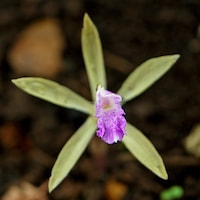
|
Nervilia crociformis (Zoll. and Mor.) Seidenf. Chinese name: Baimaiyu Lan Thai name: Bua sandot (Note: this name is also used for N. aragoana Gaud.) It is found in the tropical and subtropical Old World, in Australia and the Pacific in grasslands. Herbal Usage: Pseudobulbs are used to treat ‘faintness’ in Thailand. |
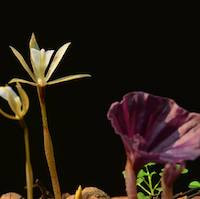
|
Nervilia fordii (Hance) Schultze Chinese names: Maochunyu Lan (hairy lip yam orchid), Qingtiankui (blue sky sunflower), Tiankui (sky sunflower) Chinese medicinal name: Qingtiankui (blue sky sunflower), Tiankui (sky sunflower) Vietnamese names: Cay moi la, Tran chau diep, Bau thooc, Thanh thien quy. Phytochemistry: Seven known flavonoids and one coumarin isolated exhibited antimicrobial activity against Herpes Simples Type-1 virus. 5 flavonoid glycosides, named nervilifordins F–J, were isolated and 2 of these compounds, nervilifordins G and J, revealed anti-inflammatory potential by inhibiting nitric oxide production of lipopolysaccharide-activated RAW264.7 macrophages. Ethanol extract of N. fordii shows significant antitumor activity in vitro. Herbal Usage: Leaves of N. fordii are used in Vietnamese folk medicine for managing tuberculosis and chest complaints, 10–15 g daily in decoction. Leaves are also pounded into a poultice to treat abscesses. In CTM, Qingtiankui is bitter-sweet. The whole plant or stem is used to clear the lungs and stop coughs. It benefits the stomach, relieves indigestion, relieves anxiety, stops pain, clears away heat and toxic materials, and removes toxins from swellings, and is also used to treat pulmonary tuberculosis, bronchitis, pneumonia, mental illness, sores and ulcers, traumatic injury, inflammation of the oral cavity and laryngitis. For stomatitis, it is recommended to chew on fresh pseudobulbs. For infantile malnutrition, malabsorption or worms, 5–10 g (or 6–12 g) of the orchid is cooked with lean pork or hens’ eggs and served as food in Guangxi Province |
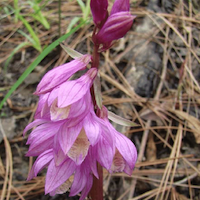
|
Nervilia gammieana (Hook.f.) Pfitzer. Syn. Pogonia gammiena Hook f. Indian name: Shankhaluka It is found in Pakistan, Nepal and Indian Himalayas, at 600–800 m in Garhwal and in pine forest in north-east India. Phytochemistry: Alkaloids are present in this species. Herbal Usage: The tubers are used as salep |

|
Nervilia plicata (Andr.) Schltr. Syn. Nervilia purpurea (Hay.) Schltr. Chinese names: Maoyeyu Lan (hairy leaf yam orchid), Qingtiankui (blue sky sunflower) Chinese medicinal name: Qingtiankui (blue sky sunflower) Note: same name for N. fordii Indian names: Padmacarini (Sanskrit), Oarilai thamarai (in Tamil; vernacular name used by primitive Poliyar tribe) It grows in deep forests, spreading eastwards across Bangladesh, Myanmar, Thailand, northern Peninsular Malaysia and Indochina to Indonesia, the Philippines and Australia. It is also found in rocky, humus-rich soil in hilly forests at 600–1000 m in China, in southern Gansu, Sichuan, Yunnan, Xizang, Guangxi, Fujian, Guangdong and Hong Kong. Plants growing in dense undergrowth with poor light intensity carry leaves which are deep purple to almost black in colour; in bright greenhouses, the leaves are green. Ancient Indian texts mention that this orchid appears suddenly, from nowhere as it were, and in profusion, just like the lotus. Hence, its com- mon name, Padmacarini (resembling the pink lotus) Phytochemistry: N. plicata contains good amounts of alkaloids. Herbal Usage: TCM uses the whole plant to clear the lungs and stop coughs, or to remove heat and toxic materials. In Taiwan, the herb is known as I-tian-hong. There, it is used to treat bruises, weakness, pneumonia and hypertension. An aqueous extract of the leaves is drunk to facilitate childbirth, and chewed leaves are rubbed on the stomach for pain relief in the Philippines. It is an important ingredient of Priyagvadignana, an Ayurvedic preparation mentioned in Vagbhata, but it is not mentioned in the Samhitas of Charaka and Susrutha. Other preparations which include the orchid are Vastyamayantaka ghratham and Satavari Ghrtam. The mucilaginous extract of the pseudobulb is used, sometimes in combination with tumeric, as an infusion, to treat morbid Kapha (cough) and Varta (rheumatism), dysuria, urinary calculi, diabetes, diarrhoea, vomiting, jaundice, epilepsy and illnesses attributed to evil spirits. The drug is hot, bitter and astringent. In the Wayanad district of Kerala in Peninsular India, is is an old, traditional remedy for diabetes. Paste made with the leaves is administered orally to treat skin diseases by the Poliyers, one of the oldest tribal communities in the Anaimalai Hills of Tamil Nadu in southern India. |
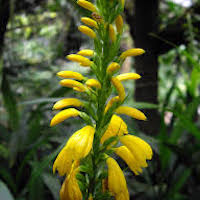
|
Neuwiedia zollingeri Rchb. f. var. Singaporeana (Baker) de Vogel Syn. Neuwiedia singaporeana (Wallich ex Baker) Rolfe Chinese name: Sanrui Lan Thai name: Makphu makmia Flowering season is May to June. It is collected from the wild in Sabah, east Malaysia, have typical orchidaceous mycotrophic protocorms. The species is distributed in Hong Kong, Hainan, southeast Yunnan, Vietnam, Thailand, Peninsular Malaysia, Borneo, Sumatra, the Lingga Archipelago and Bangka Island. Herbal Usage: The stem and roots of N. Singaporeana are used to treat furry tongue in Thailand |
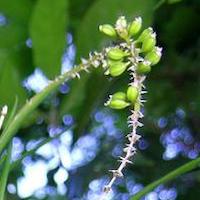
|
Oberonia caulescens Lindl. ex Wall. Chinese names: Erliechunebai Lan (hare lip white orchid), Lieyeyinluo Lan (split leaf jade/ pearl orchid), Yedaiweilan (slim leaf bird tail orchid); Xiaxiaojinerhuan (small gold earring), Hucha (curved hairpin), Yancong (rock spring onion) Xiayeyuanwei Lan It is distributed across northern India, Sikkim, Bhutan, Nepal, Tibet, Yunnan, Sichuan, Hunan, Hubei, Guangdong, Taiwan and Vietnam. Herbal Usage: The entire plant is used to stop bleeding and remove bruises. A paste made from the plant is applied directly on fractures and areas of traumatic bleeding. In India, tubers are used to treat biliary disorders. Tubers are rendered into a paste with black pepper in the ratio of 3:1. Cold water is added and the mixture is drunk before meals. |
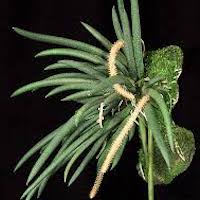
|
Oberonia cavaleriei Finet. Syn. Oberonia myosurus (Forster) Lindl. Chinese name: Bangyeyuanwei Lan (stick leaf eagle tail orchid) Chinese medicinal name: Yancong It flowers from August to October and is found in at 1200–1500 m in China (Sichuan, Yunnan, Guizhou, Jiangxi, Guangxi), Vietnam, Thailand, Myanmar, Nepal. Herbal Usage: Herb is obtained from Yunnan, Guizhou and Jiangxi. It can be harvested the whole year round and used fresh or be divided into sections and dried. Herb is acrid in taste and slightly bitter. Its nature is cool. CTm uses it to clear heat and urinary discharge, stop bleeding from superficial wounds and to remove bruises. It is used to treat traumatic injuries, fractures, and strangury resulting from urinary stones. For the preparation of the decoction, 9–15 g of the orchid is used. It is used as follows:
|
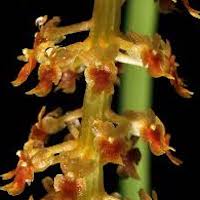
|
Oberonia ensiformis (Sm.) Lindl. Syn. O. iridifolia Lindl. Chinese name: Jianyeyuanweilan Chinese medicinal name: Shubianzhu Flowering season is September to November in China, October in Tamil Nadu, October to December at Palnis Hills, or November in much of India (Sikkim, Orissa, Western Ghats). Herbal Usage: It is used to encourage diuresis, improve blood circulation and to treat cystitis, urethritis, injuries and fractures. |
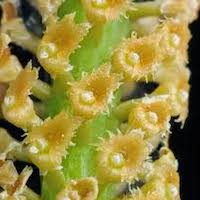
|
Oberonia falconeri Hook f. Indian name: Kanchapra It is distributed from continental India and Yunnan (China) across Bangladesh, Myanmar, Thailand and Indochina into Peninsular Malaysia. Herbal Usage: Plant is used to treat fractures in Indian Himalayas. |
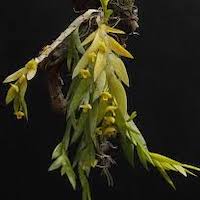
|
Oberonia longibracteata Lindl. Chinese name: Changbaoyuanwei Lan It is distributed from Sri Lanka and the Indian Peninsula across Myanmar to Indochina and Hainan Island. In Vietnam, it occurs in dry lowland Dipterocarp forests as well as in the central Annamese floristic province which experiences high precipitation. Herbal Usage: It is used for scorpion bites in Kampuchea |

|
Oberonia lycopodioides (J.Koenig) Ormerod Syn. Oberonia anceps Lindl. Malay name: Sakat lidah buaya It is a common, sun-loving, lowland, miniature species distributed in Indochina, Thailand, and from Sumatra eastwards to Malaysia, Kalimantan, the Philippines and Sulawesi. Herbal Usage: The pulverized plant was used as a poultice to treat boils and infected wounds in Malaysia |

|
Oberonia mucronata (D. Don) Omerod and Seidenf. Chinese names: Yuanweiyebai Lan (eagle tail leaf, white orchid), Yuanweiyebianzhu Lan (eagle tail leaf, flat bamboo orchid); Yuanwei Lan (eagle tail orchid) It occurs in Yunnan, Laos, Philippines, Malaysia, Indonesia, Myanmar, Bangladesh, India, Nepal and Bhutan. In Yunnan it is epiphytic on trees in forests at 1300–1400 m. Herbal Usage: The entire plant is used in TCM to relieve gas and help in digestion. It clears urinary discharge, stops coughs and pain. It is also used to treat traumatic injuries, fractures and snake bites. |
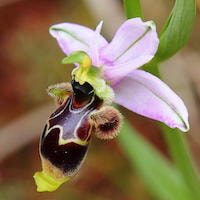
|
Ophrys scolopax Cav. It is a small to medium-sized cold- growing, terrestrial herb. Flowering season is March to June depending on locality. It is distributed from Hungary and the Mediterranean (including Algeria, Morocco and Canary Islands) to northern Iran. Herbal usage: Tubers are used as Salep. |
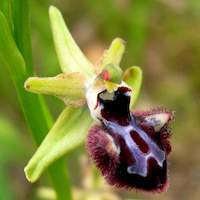
|
Ophrys sphegodes Mill. Common name: Early spider orchid It is distributed from western and southern Europe to northern Iran in well-drained chalky soil in meadows, pastures, fallow and forest clearings; in Italy at 100–750 m. Herbal usage: Tubers are used as salep |
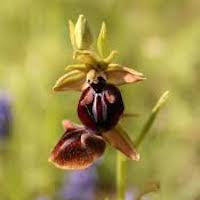
|
Ophrys sphegodes subsp. Mammosa (Desf.) Soo ex E.Nelson Syn. Ophrys mammosa Desf. Flowering season starts in early April in Cyprus. O. sphegodes are pollinated solitary bees, Andrena nigroaenea, that are lured by visual cues and volatile semiochemicals consisting of variable mixtures of alkanes and alkenes, especially the latter. Flower-specific odor variation between plants mimic sex pheromones of individual female bees preventing bees from revisiting flowers and effecting cross-breeding success. It is distributed from south-eastern Europe to Iran, Iraq and Turkmenistan, in open woodland or light scrub in full sun or semi-shade. Herbal usage: Tubers are used as Salep. |
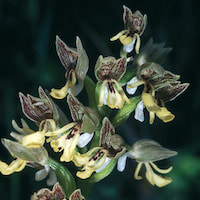
|
Orchis adenocheila Czerkiak It is a small, cool growing terrestrial herb. Flowers are white or pale green, heavily spotted with red on the mid-lobe of the lip. Flowering season is spring. It is distributed from Trancaucasus to northern Iran at 1200 m. Herbal usage: Tubers are used as salep in Turkey and Iran. |
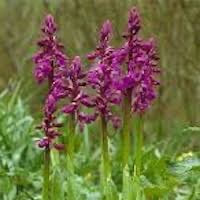
|
Orchis mascula (L.) L. Common name: The Salep Orchid, Early Purple Indian names: Salab Misr, Salep Misri (Hindi), Salum (Bombay) Iranian names: Punjah-i-salaba; Salab The species is distributed throughout Europe, North Africa and temperate Asia to Siberia. Herbal Usage: Salep is considered to be an invigorating substance and an aphrodisiac. It was boiled with milk and administered to people suffering from phthisis, diabetes, chronic diarrhoea and dysentery in India. In Nepal, it is used as an expectorant, astringent and nutrient. The tuber is used as a demulcent, tonic and nutrient, especially when Iraqi infants suffer from diarrhea. Due to its high content of mucilage, salep prepared with this orchid forms a thick jelly even when diluted with 40 parts of water. In the Peloponnesus, the dried root is cooked and eaten. |
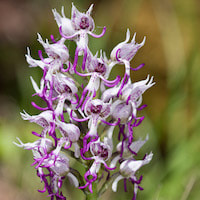
|
Orchis simia Lam. Turkish names: Tavsantopugu, topanbas, solmazsoluk, puskullu It is distributed from Europe to Iran and north Africa, occurring in meadows and sparse forests in sunny locations on neutral soils or limestone from lowlands to 1550 m. Phytochemistry: It contains a phenolic glycoside, loroglossin, coumarin precursors, anthocyanins, cyanin, orchicyanins I and II. Herbal Usage: It is used as Salep in Iran and Turkey. |
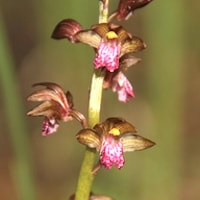
|
Oreorchis foliosa (Lindl.) Lindl. Chinese name: Xiaoshan Lan (small hill orchid), Nangchunshan Lan Chinese medicinal name: Duyeshan Lan Description: A terrestrial orchid, it is found in Japan, Taiwan, Shanxi, Hubei, Sichuan, Yunnan and Tibet, Bhutan, Nepal, northeast India and Pakistan. Herbal Usage: Herb is obtained from Shanxi, Hubei, Sichuan, Yunnan and Tibet. The stem is used by Chinese herbalists as an antidote for snake bites and to treat tuberculosis of the lymph nodes, sores and ulcers. For decoction, 3–9 g of the herb is used. |
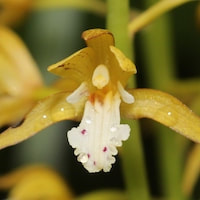
|
Oreorchis patens (Lindl.) Lindl. Chinese name: Shan Lan (mountain orchid), Shuangbanshan Lan (double plate mountain orchid), (fine flower mountain orchid), (orchid herb), (gentle aunt of the mountain), (ice ball) It is found in forests or at the edge of forests at 1000–3000 m from northern Yunnan, Jiangxi, Guizhou, Hunan and Taiwan, northwards into the northern provinces of China, and Korea, Japan and Siberia. Herbal Usage: The whole plant is used as a deoxidant but the herb itself is slightly poisonous. It enlivens the liver, clears phlegm, stops coughs and heals carbuncles and lumps in the skin. It is used to treat swollen lymph nodes, sores and snake bites. It is also used to kill bugs. For decoction 3–9 g, for external use, pulverize and apply on the bites. |
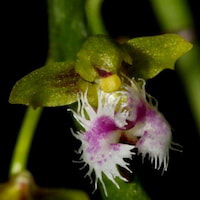
|
Ornithochilus difformis (Wall ex Lindl.) Schltr. Syn. Ornithochilus fuscus Wall ex Lindl. Chinese name: Yixingxiachun Lan (unique shape narrow lip orchid), Yuchun lan (feather lip orchid) Thai name: Soi Thong Flowering period is February to April in the Himalayas, May to July in China, July in Peninsular Malaysia, and July and August in Thailand. It is widely distributed from the tropical Himalayas (Garhwal to Sikkim and Assam) to southern China (Guangdong, Guangxi, Sichuan and Yunnan. Herbal Usage: The whole plant is used to treat rheumatism and arthritis, sprains and soft tissue trauma in China. The herb is collected from Guangdong, Guangxi, Yunnan and Xizang Provinces. |
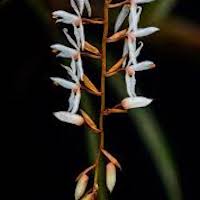
|
Otochilus albus Lindl. Chinese name: Baihua Erchun Lan It flowers in June in Nepal and October to December in China. It is distributed from Nepal to Indochina. Usage: In Nepal, pseudobulbs are used to treat fractures. |
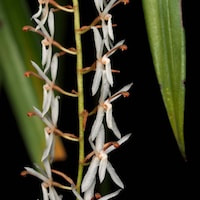
|
Otochilus fuscus Lindl. Chinese name: Xiaye Erchun Lan A terrestrial herb that flowers in December to January in Nepal, and November to January in Bhutan. It is distributed from Bhutan and Nepal to north-east India, Yunnan, Myanmar and Thailand to Indochina. Herbal Usage: Pseudobulbs are used to treat fractures. |
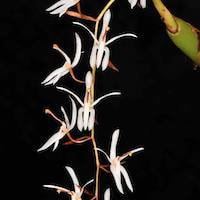
|
Otochilus porrectus Lindl. Chinese name: Erchun Lan It flowers from October to December in Nepal. The species is distributed from Bhutan and Nepal to north-east India, Myanmar, China (Yunnan) to Thailand and Indochina. Herbal Usage: In Nepal, pseudobulbs are used to treat sinusitis, rheumatism and as a tonic. |
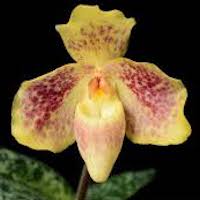
|
Paphiopediulun concolor (Lindl. ex Bateman) Pfitzer Chinese name: Tongseduo Lan (uniform colour pouch orchid) Chinese medicinal name: Bazhangcao, Shizilixian The species is distributed in Guangxi, Guizhou, Yunnan, Indochina, Thailand and Myanmar on limestone. Herbal Usage: According to CTM, nature of the herb is “hot and neutral”. Entire plant is used to relieve coughs and asthma, clear gas and for pain relief. It is used to treat pulmonary tuberculosis, bone and joint pains, rheumatoid arthritis and chronic gastroenteritis. It is not used in isolation but together with other herbs. The fresh plant is pounded and used (1) to treat soft tissue trauma, add alcohol to the mashed plant; (2) for sores, add red sugar; (3) for snake bites, mix 30–60 g pulverized whole plant with 30–60 ml of white wine. Drink the juice and apply the residue to the area of the bite. |
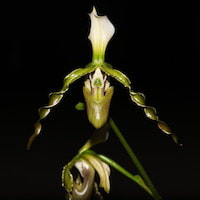
|
Paphipedilum dianthum Tang et Wang syn. Paphiopedilum parishii (Rchb. f.) var. dianthum (Tang et Wang) Karasawa & Saito Chinese name: Changbanduo Lan, Shuanghuadou Lan It is a green-leaved epiphytic–lithophytic species. that occurs in south-west Guangxi, Guizhou and southern Yunnan at 1000–2300 m on trees and rocks in open forests. Herbal Usage: In China, it is used to treat swollen liver and spleen. |

|
Paphiopedilum insigne (Wall. et Lindl.) Pfitzer Chinese name: Naoquehua (noisy sparrow orchid), Bobandou Lan This terrestrial, variable species is distributed in north-west Yunnan (at 1200–1600 m), Guangdong, Guangxi, Nepal and north-east India (Meghalaya) on grassy, rocky slopes. The species has been widely used in hybridization. Herbal Usage: This is natural pesticide. The whole plant is boiled or soak for 4–5 h with rice or wheat. They are used to kill sparrows (Naoquehua) and cockroaches which are regarded as pests and vectors of disease. |
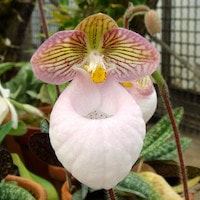
|
Paphiopedilum micranthum Tang et Wang Chinese name: Xiaohuadou Lan (small flower pouch orchid) Chinese medicinal name: Huayezi It is a newly discovered, unique, terrestrial–lithophytic species distributed Yunnan, Guizhou, Guangxi and Vietnam. The flowers are not scented and carry no nectar, and attract pollinators through food deception by floral mimicry. Herbal Usage: It is bitter and cool. The whole plant is used to remove heat and toxins. It is believed to benefit the brain and has the ability to calm the nerves. It is also used to treat pneumonia, measles and neurosis. For decoction, 10–15 g of the orchid is used. |
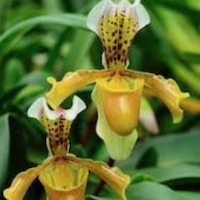
|
Paphiopedilum parishii (Rchb f.) Pfitzer Chinese names: Luoxuandoushe Lan (spiral tongued orchid), Duolan (pocket orchid); Banye Lan (mottled leaf orchid), Piaodaidou Lan Chinese medicinal name: Qianlinglan Thai names: Rongtao Naree Nuad Rue-Si, Rongtao Naree Chieng Dao, Rongtao Naree Muang Gaan. It is found in northern and western Thailand, Laos, Myanmar Yunnan and Assam, in montane forests at 1200–2200 m, on trees or boulders in dense shade and high humidity. Petals are long, twisted, greenish-yellow with dark purple spots proximally, and solid purple distally. Herbal Usage: Entire plant is used as an antipyretic and to detox, to relieve unease of body or mind, skin rash, weak kidneys and dry cough. It is used to dispel heat and for detoxification. It is said to have a tranquilizing effect and to treat febrile rash, pneumonia and depression. It is bitter and cool. Between 6 and 15 g of the fresh plant is used to prepare a decoction. |
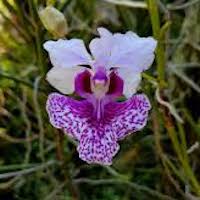
|
Papilionanthe hookeriana (Rchb.f.) Schltr. Syn Vanda hookeriana Malaysian names: Kinta weed, pokok tulang (bone plant) Indonesian names: Anggerik pensil (pencil orchid), Potloodorchidee (in Dutch) A native plant of the mangrove swamps of Kinta Valley, in Peninsular Malaysia. It occurs in swampy, open, sunny areas with high rainfall amidst thickets and shrubs in peninsular Thailand and Malaysia, Sumatra and Borneo and Indochina. Herbal Usage: A hot paste is used for treating painful joints in northern Peninsular Malaysia. |
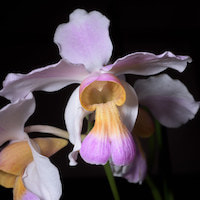
|
Papilionanthe teres (Roxb.) Lindl. Syn Vanda teres Roxb. Chinese names: Banghua Lan (stick flower orchid), Jianyewandai Lan (sharp leaved ten-thousand-generation/Vanda orchid, Bangyewandai Lan (terete leaf Vanda orchid); Bangyeyu Lan (terete leaf jade orchid), Fengdie lan Indian names: Chaitek Lei in Manipuri, cylindri- cal Vanda Indonesia: Anggerik pensil; (Belgian): Potloodorchidee Nepalese names: Harjor, Thurjo in Nepali, Harjor (Gurung) Formerly known as Vanda teres, this is parent of a very important flower- i. e. Singapore’s national flower, the Vanda Miss Joaquim. It is distributed from the foothills of the Himalayas to Upper Myanmar, southern Yunnan, Laos, Vietnam and Thailand at 600 m, and has been cultivated as a garden plant for centuries. Phytochemistry: Eucomic acid [(2R)-2- (p-hydroxybenzyl)malic acid)] and vandateroside II isolated from stems. This compounds oxidase activity and/or expression without enhancing cellular mitochondrial content in a human immortalized keratinocyte cell line (HaCaT). Decline in mitochondrial functions occurs with age and may be an underlying cause of age-related changes in the body. Eucomic acid and one of its three glucopyranosyloxybenzyl eucomate derivatives (vandateroside II) are candidates as new natural ingredients for “anti-ageing” preparations to remedy age-related disorders such as skin aging. The discovery of anti-ageing agents in P. teres are likely to lead to its incorporation in cosmetic preparations. Herbal Usage: Stems and leaves are used to improve blood flow and reduce swelling. A paste made from the plant is used to treat dislocated bones in Nepal. In northeastern India, leaf paste is also applied to the forehead to reduce fever. Tribal peoples tie a length of the orchid stem to their loin to protect themselves from coughs and colds. |
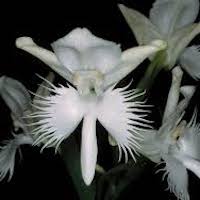
|
Pecteilis susannae (L.) Raf. syn. Habenaria susannae (L.) R. Br. Chinese names: Longtou Lan (dragon head orchid), Baidiehua (white butterfly flower), Emaobaidiehua (goose feather white butterfly flower), Emaoyufenghua (goose feather jade phoenix flower) Chinese medicinal names: Tu er cao (rabbit ear herb); Heqicao (friendly herb); Tuyuzhu (mud jade bamboo); Baidiehua (white butterfly flower) Indian medicinal name: Riddhi Vriddhi; also Hukakanda (Bihar), Waghchoora (Mumbai) This is a large, robust plant is distributed from Pakistan, the Deccan Peninsula and Assam, through Myanmar, southern China. Herbal Usage: Roots are collected and used fresh or saved after sun-drying. In CTM, the root are believed to benefit “kidney”. It also strengthens yang and benefits the “spleen”. The taste is sweet and ‘slightly warm’. In India, pseudobulbs are used to treat blebs or bullae on the palm of the hand. It is used in the treatment of low backache, chronic nephritis, impotence, nocturnal ejaculation, orchitis, hernia and indigestion. Pseudobulbs are used to make Salep by the jungle tribes. |
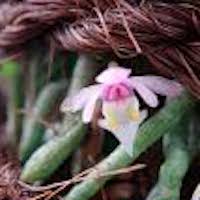
|
Pelatantheria scolopedrifolia (Makino) Garay syn. Cleisostoma scolopedrifolium (Makino) Garay Chinese name: Wugong Lan (Centipede Orchid) Small epiphyte distributed from Japan and South Korea to Shandong, Jiangsu, Anhui, Zhejiang, Fujian and Sichuan provinces in China. Herbal Usage: Herb is slightly bitter and cool in nature. Its main functions are to clear internal heat, detoxify, sooth the lungs and arrest bleeding. It is used to treat sore throat, mouth ulcers, running nose, tonsillitis, blood in the sputum, infections of the gall bladder and kidneys, and convulsions in infants. |
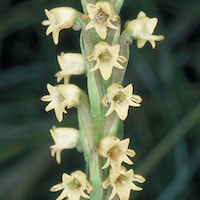
|
Peristylus affinis (D.Don) Seidenf. syn. Peristylus sampsonii Hance Chinese name: Xiaohuakuorui Lan (small flower broad pistil orchid) Description: Plant slender with flowering season from June to September. Herbal Usage: Entire plant is used in Chinese medicine to clear heat and remove toxin. It is used in the treatment of nephritis, weak kidneys and backache. |
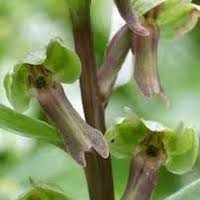
|
Peristylus bulleyi (Rolfe) K. Y. Langherbal syn. Herminium bulleya (Rolfe) Tang & F.T. Wang Chinese names: Tiaoyekuorui Lan (stripe leaf broad pistal orchid), Tiaoyejiaopan Lan (stripe leaf angle plate orchid), Chinese medicinal name: Zhulancaoz This endemic Chinese species is found in pine forests and grassy slopes at 2500–3000 m, in southwest and west Sichuan and north and NW Yunnan. Flowering season is July and August. Herbal Usage: CTM doctors use the whole grass use to enrich kid-ney. It invigorates the kidney, strengthens the loins, and is used for the treatment of lumbago and asthenia of kidney. It is especially well regarded as a remedy for impotence. |
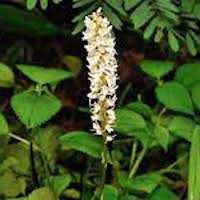
|
Peristylis constrictus (Lindl.) Lindl. Bangladeshi name: Bhuinora (Tanchinga tribe), Cha-muinda (Marma tribe) Chinese name: Dahuakuorui Lan It is found on slopes at 1500–2800 m in Yunnan, Cambodia, Vietnam, Thailand, Myanmar, Bangladesh India, Nepal and Bhutan. Herbal Usage: The Marma tribe in the Chittagong Hill Tracts make pills from the whole plant with leaves of Plumbago indica and employ them as contraceptive pills which are taken for 2–3 days after the period. An extract of the roots is applied to boils in Bangladesh |
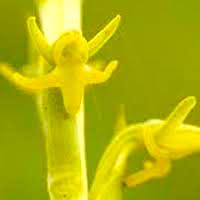
|
Peristylus densus (Lindl.) Santapau and Kapadia syn. Platanthera stenostachya Lindl. Chinese names: Xiasuikuorui Lan, Xiasuilu Lan, Xiasuishechun Lan (narrow tassel tongue lip orchid), Xiasuilu Lan (narrow tassel heron orchid), Xiasuiyufenghua (narrow tassel jade phoenix flower) Herbs are obtained from China’s southwest. Herbal Usage: The herbal prescription from the Yunnan Shi Mao CTM requires 15–30 g of plant to be cooked with meat. The is used to treat physical weakness, fortify stomach and spleen, correct malnutrition and poor digestion in children, as well as for diarrhea and rheumatism. |
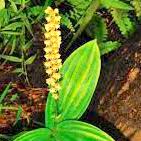
|
Peristylus goodyeroides (D. Don) Lindl. Chinese names: Luhuakuorui Lan (green flower broad pistil orchid), Yuanjukuorui Lan (round distance broad pistil orchid), Banyeyufeng Lan (spotted leaf jade phoenix orchid), Banyekuorui Lan (spotted leaf broad pistil orchid) Chinese medicinal name: Shanshajiang It is a medium-sized herb with oblong-ovoid tubers. Flowering period is May to June in Thailand, July to August in China, August in India, and December is mentioned for Tamil Nadu. Herbal Usage: Herb made from root is used to remove toxins from swelling. For decoction, 6–15 g of the herb is used. Also used externally after pulverization of fresh herb. The tubers are used as a tonic in India. |
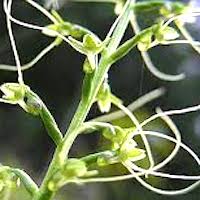
|
Peristylus tentaculatus (Lindl.) J.J.Sm. Chinese name: Chuxukuorui lan It grows on rocky soil at the edge of forests at 500–1400 m in southern Yunnan, Guangdong, Hainan, Macau and Hong Kong; Indochina and Thailand. It is common in wet places or wasteland in Hong Kong. Herbal Usage: The plant has many uses in China. A Chinese Herbal mentioned that P. tentaculatus is analgesic, anti-inflammatory and promotes healing, haemostasis, and circulation of qi, and improves kidney function. |
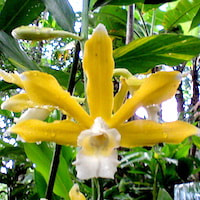
|
Phaius callosus Lindl. Indonesian: Angkrek lemah (Sundanese) The species is found in the Malay Peninsula, Sumatra, Java, Kalimantan and Sulawesi. Herbal Usage: Its roots are “tart and sternutatory”. They can cause sneezing if placed near the nose. They might be used to rouse someone who had fainted. |
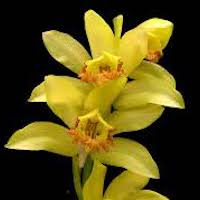
|
Phaius flavus (Blume) Lindl. Chinese names: Huanghe Lan (yellow crane orchid), Huanghuaheding Lan (yellow flower crane top orchid), Banyeheding Lan (spotted leaf crane top orchid), Jiuzi Lan (nine sons orchid), Xiaohuaheding Lan (small flowered crane top orchid) Myanmar name: Nay myo new thitkwa It is found in shady, moist locations in forests at 300–2500 m in Japan, China, Taiwan, Vietnam, Laos, northern Thailand, Myanmar, Northeast India, Sri Lanka, Sumatra, Malaysia, the Philippines and New Guinea. Herbal Usage: Taiwanese herbalists state that stems are antipyretic and have the capacity to detoxify. In Taiwan, they are used to treat sores and mouth ulcers. |
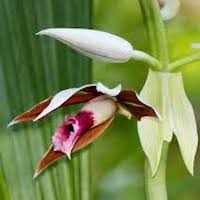
|
Phaius tankervilleae (Banks) Blume Chinese names: Honghe Lan (red crane orchid); Guaiziye (twisted leaf orchid); Dabaiji (large stone orchid) Chinese medicinal name: Hedging Lan (crane top orchid) Indian name: Tipui Indonesian names: Indonesia name: Angkrek apuj (Sundanese) (fire orchid), Anggerik Betul, Angkrek Bener Japanese name: Kaku ran, kwaku ran, Kwa ran, Kakuchoran Myanmar name: Zayti thitkhwa Papua New Guinea: Kongimongo (Ialibu tribe); common name—Kunai orchid It flowers at different times in Thailand (January to March) and later in China (March to June). It is distributed in the lowlands (up to 1500 m) from Indonesia northwards to southern China and Taiwan and eastwards to Australia and the Pacific Islands. Herbal Usage: Pseudobulbs are sun-dried for future use. The bulb is acrid and “warm’. It is mildly toxic. It is antitussive, promotes circulation and is haemostatic. A decoction is used to treat fever, for detoxification and to prevent wet cough. In northeastern India, pseudobulbs are used to treat fractures and dysentery. A paste of the pseudobulbs is also used to treat swellings of the hands and legs, as vermifuge and for treating abdominal disorders. It is used to treat sores and infected wounds in Peninsular Malaysia, and to relieve the pain of abscesses in west Java. The flower is heated in the smoke of a wood fire and eaten with any type of food by Ialibu women in Papua New Guinea believe that this makes it easier for them to conceive. At the same time, it is also reported that, in the southern Highlands of Papua New Guinea, smoked flowers are eaten for contraceptive purposes. Phytochemistry: Alkaloids are present. Phytanthrin A and tryptanthrin present in the pant, exhibited moderate cytotoxicity against several human cancer cell lines. |
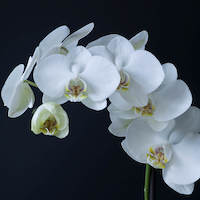
|
Phalaenopsis amabilis (L.) Blume and Phalaenopsis aphrodite (L.) Blume) Common name: Moth orchid Indonesian name: Anggerik bulan (moon orchid); Tapak Djalak in the Sunda Islands, Anggrek poeti (an old name recorded by Rumphius in 1701) It is a robust epiphyte with a short stem and large, oblong leaves. Flowering season is February to May. Phytochemistry: An alkaloid, Phalaenopsine La is present. Herbal Usage: It is used as a poultice for headaches, and as a plaster for backache and chest pain. In India, it has been reported to be used as a shampoo to kill and remove leeches and as a poultice for insect bites |
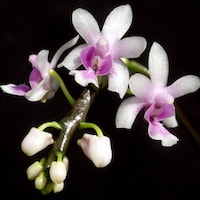
|
Phalaenopsis deliciosa Rchb. f. syn. Kingidium deliciosum (Rchb. f.) Chinese names: Xiaoe Lan (small moth orchid), Dajiannanghudie Lan This is a small flowered plant. Plants are short and form clumps by basal shoots. This is the most widely distributed species in its types. It is distributed from Sri Lanka and India across Yunnan, Myanmar, Thailand, Indochina, Malaysia and Indonesia to the Philippines in riverine forests from sea level to 300 m. Plants need light and humidity but not water-logging. Herbal Usage: The whole plant is used in Taiwan to dispel cold and wind, and clear dampness. |
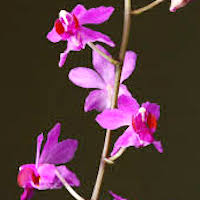
|
Phalaenopsis pulcherrima (Lindl.) J.J.Sm. syn. Doritis pulcherrima Lindl. Chinese name: Wuchun Lan Thai name: Ma wing Plant tends to develop numerous offshoots so that it soon becomes a community, and numerous roots are produced at the base. It is widely distributed in the lowlands throughout Myanmar, Thailand, Indochina, Hainan, northern Peninsular Malaysia and Sumatra. These are loved by the hybridizers in orchid flower industry. Phytochemistry: An alkaloid, Phalaenopsine 1A, has been isolated. Herbal Usage: Leaves are used to treat ear infections in Thailand. |
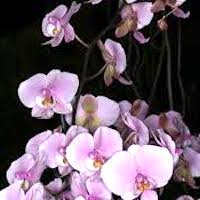
|
Phalaenopsis schilleriana Rchb. f. This is a beautiful, pink Phalaenopsis with an upright, monopodial habit and mottled leaves. It occurs in Luzon and Mindanao in the Philippines at 800–1200 m. Flowering period is February to May. Phytochemistry: Two alkaloids, Phalanopsine La and Phalaenopsine T, have been isolated from this orchid. Herbal Usage: It is used to counter poison. A heated leaf of the orchid is placed over centipede bites in the Philippines. Decoction of the leaves is also used for phthisis, and for stomach ache. |
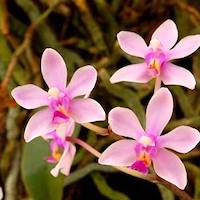
|
Phalaenopsis wilsonii Rolfe Chinese names: Die Lan (butterfly orchid), Huaxidie Lan (Western China butterfly orchid), Huaxihudie Lan (Western China moth orchid) Chinese medicinal name: Die lan A small Chinese species is found as an epiphyte on trees in sparse woods or as a lithophyte in shady spots along ravines in Yunnan, southeastern Xizang, western Guangxi, western Sichuan, southwestern Guizhou in China and in northern Vietnam. It does not get killed by bacterial rot, is immune to fungi, and it is not attacked by arthropods, snails and slugs . Leaves are used as a salad in Java. Phytochemistry: It is promising as a source of secondary metabolites because many alkaloids (17) were found. Most ofthem in excess of 0.1 % of total weight. Phalaenopsine is the major alkaloid (more than 90 % of the alkaloid content) and is present throughout the plant. This makes the extraction very easy. Two phenanthropyran derivatives have been isolated from P. equestris. They are 3-methoxy-2,7-dihydroxy-5H-phenanthro(4,5-bcd) pyran and 2,3,7-trihydroxy-5H-phenanthro (4,5-bcd)pyran. Naturally occurring pyrolizidine alkaloids from plants are generally poisonous and are known to cause fatalities in grazing cattle, and liver cirrhosis and cancer in humans. However, the pyrolizidine alkaloids present in orchids are thought to be non-toxic (International Program on Chemical Safety, WHO, 1988). Plant is used to treat headache in some countries. This is a very fragrant species. Geranyl diphosphate synthase is the precursor of monoterpenes, the major scent compound in strongly scented P. bellina. It also has geraniol and linalool. |
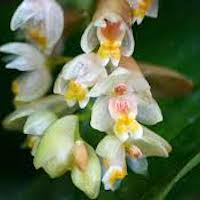
|
Pholidota articulata Lindl. Chinese name: Jiejinshixiantao (node stem, rock-living Immortal peach) Chinese medicinal name: Shilian (stone lotus), Shibangtui Indian name: Harjojan; Jivanti Myanmar name: Kwyet mee pan myo kywe Nepalese name: Thurjo, Pathakera It is found growing on trees or shaded rocks at 800–2500 m in India, Nepal and Bhutan, across the provinces of southeast Tibet, southwest Sichuan and Yunnan in China to Myanmar (Kachin, Kayin and Mon states), Thailand, Cambodia, Vietnam, Malaysia and Indonesia. Phytochemistry: Two 9,10-dihydrophen- anthrenes, namely, isoflavidinin and iso-oxoflavidinin A and a novel 9,10- dihydrophenanthrene derivative named flavidin, were isolated. Pseudomonas, Flavobacterium, Stenotro- phomonas, Pantoea, Chryseobacterium, Bacillus, Agrobacterium, Erwinia, Burkholderia and Paracoccus strains of bacteria were found colonising roots of P. articulate. Herbal Usage: The whole plant, 30–50 g is used in decoction. The paste of whole plant is also used for external application. It is supposed to enrich yin, remove gas and reduce swelling. It is used to treat coughs caused by body heat, headache, diz- ziness, traumatic injuries, sores and ulcers, irreg- ular menses and uterine prolapse. In Uttarakhand in the western Himalayas, it is used to treat fractures. It is also a stimulant, demulcent and tonic. In Nepal, it is regarded as a plant for making tonic. Paste made with pseudobulbs of the variety griffithii is applied on dislocated bones. In this Himalayan villages, powder prepared from the roots is used to treat cancer; whereas juice prepared from the capsule is used to treat skin eruptions and ulcers. These bacteria produce indole-3-acetic acid (IAA), the highest concentration of auxin being produced during the stationary phase of the orchid. IAA stimulates root formation and growth. It showed antibacterial activity against Staphylococcus and Bacillus subtilis at a concentration of 5 mg/ ml. |
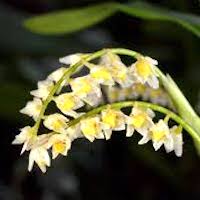
|
Pholidota cantonensis Rolfe Chinese names: Xiyeshixiantao (fine leaf rock- living Immortal peach), Yandou (rock bean) Chinese medicinal name: Xiaoshixiantao (small rock-living Immortal peach) This lithophytic Orchid grows on rocks in forests at 200–900 m in Zhejiang, Jiangxi, Fujian, Guangdong, Guangxi Hunan and Taiwan. Phytochemistry: Four active compounds were isolated from P. cantonensis, namely, pholidonone (1), ephemeranthoquinone (2), orchinol (3) and batatasin III (4). Pholidonone is a new compound. Other compounds are- densiflorol, 3,5-dimethoxy-4-hydroxy- propiophenone, cinnamic acid, syringaaresinol, 24-methylenencycoartanol, ergosterol peroxide and beta-sitosterol. Herbal Usage: Whole plant is used to treat high fever, eczema and hemorrhoids. |
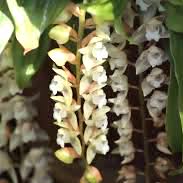
|
Pholidota chinensis Lindl. Chinese names Datiao Lan (large hanging orchid), Foushihu (floating shihu), Shanxi xiantuo (Shanxi’s Immortal stone peach), Chuanjiacao (Sichuan’s real grass), Maliugen (horse pomegranate root) Chinese medicinal names: Shixiantao (Immortal stone peach); Shishanglian (lotus on the rock); Shiganlan (Rock olive); Shichuanpan (rock piercing plate) Shiyurou (rock dog- wood); Guoshangye (leaf above the fruit); Qiannianai (thousand year short); Xiaokouzi Lan (Small button orchid); Fu Shihu (floating shihu); Chuanjiacao (Sichuan’s real grass), Maliugen (horse pomegranate root) Myanmar Name: Kwyet mee pan myo kywe (Note: The Myanmar name for P. chinensis and P. articulata are identical.) This epiphytic orchid with a creeping rhizome, grows on the trunk of medium-sized trees or on rocks in sparse forests and on the edge of forests. It is distributed from Zhejiang to Fujian, Guangdong, Guangxi and Guizhou to Yunnan and Tibet, and southwards to Hainan, Vietnam and Myanmar. It is common in Hong Kong as well. Phytochemistry: A benzoxepin derivative, bulbophylol B. is useful in inhibiting nitric oxide production and in radical-scavenging activity. It reduced nitric oxide synthase mRNA expression. Three more new stilbenoids showed strong cytotoxicity than the original stilbenes. Coelonin, batatasin III and pholidotol D present in stems and roots enhanced GABA-induced chloride currents in Xenopus laevis oocytes. GABA is an important inhibitory neuro-transmitter in the brain, this finding suggests that P. chinensis may have a useful role in the treatment of neurological conditions. Batatasin III has pain-relieving properties for toothache, traumatic injuries, or abdominal colic. Herbal Usage: Plants are used fresh and dried. It is cooling, pleasant and bland to taste. It nourishes the yin, moistens the lungs, cools the blood and promotes. TCM practitioners use the whole plant to treat tuberculosis-associated haemoptysis, acute or chronic bronchitis, dry cough, pharyngitis, tonsillitis, toothache, peptic ulcer, gastroenteritis, dizziness, headache, post-concussion syndrome, neurasthenia, osteomyelitis and trauma. In India an aqueous extract is taken for scrofula, fever, stomach ache and toothache, while a tincture is used to arrest bleeding, and treat asthmatic coughs, tuberculosis and dysentery. |

|
Pholidota imbricata Hook. f. Chinese name: Subaoshixiantao Sri Lankan name: Necklace Orchid Nepal name: Syalamba, Timyuno (in Tamang) Papua New Guinea: Necklace orchid It has creeping rhizome, tightly spaced, broadly ovoid-conical pseudobulbs and is found on trees and karst formations at 1000–2700 m from southwest Sichuan, Yunnan and eastern Xizang in China through the Himalayas to Sri Lanka, Southeast Asia, New Guinea and Australia. In Sri Lanka, it is a common epiphyte on trees and rocks in moist areas up to 1200 m. Phytochemistry: A 9,10-dihydrophenanthre derivative (imbricatin) was isolated. Imbricatin is a phytoalexin which is bacteriostatic. Coelonin was also isolated. Herbal Usage: On the Malabar Coast of India, crushed roots are applied on the head, or the entire plant applied to the soles, to relieve fever. A poultice made from the entire plant is applied to the loins to facilitate childbirth, induce menstrual flow and diuresis. The fruit was used as a sedative. Both fruit and pseudobulbs were used to treat ulcers. The plant is also used to prepare a tonic. Also used for rheumatic pain. In Nepal, juice from pseudobulbs is applied to boils, or over the navel to relieve navel, abdominal and rheumatic pain. Leaves and roots are made into a paste for treating fractures in Bangladesh. |
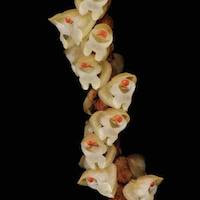
|
Pholidota pallida Lindl. Chinese name: Eumaishixiantao It is distributed from central Nepal, Bhutan, northeast India across south and southwest Yunnan to Myanmar, Thailand, Laos and Vietnam in forests at 800–2700 m in Yunnan and 500–2000 m in Nepal. Herbal Usage: Paste of root and pseudobulb is used to relieve fever, powder to induce sleep and relieve abdominal pain. Juice is used for abdominal pain at the navel. |
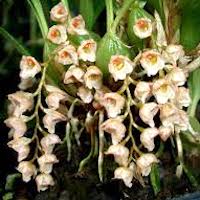
|
Pholidota yunnanensis Rolfe Chinese medicinal name: Shizaozi It has creeping rhizome and grows on karst formations and tree trunks in sparse woods at 1200–1700 m in southeast Yunnan, southwest Guizhou, Guangxi, Hubei and Hunan and in Vietnam. Phytochemistry: 4 stilbenes, phoyunbene A, B and C, a bibenzyldihydrophenanthrene ether designated phoyunbene D, and a bis(dihydrophe- nenthrene ether, phoyunbene E, all natural resvera- trol analogues were found. These all possess anti-oxidant properties. Nitric oxide production in the murine macrophage-like cell line RAW 264.7 activated by lipopolysaccharide and interferon-gamma was inhibited by the stilbenoids. 8 compounds fund also showed DPPH free radical-scavenging activity. Phuyunbene B prevented cell division (induces G2/M phase cell cycle arrest), caused programmed cell death (apoptosis) and inhibited invasion of liver cancer cells. These are important properties if they can be translated into clinical efficacy. Herbal Usage: Entire plant is cooked in pork porridge which is served to treat ordinary coughs and asthma. CTM herbalists recommend Tincture of the Pholidota (in distilled rice spirit) as an alternative to Tincture. This is consumed with rice as a tonic for internal injuries. |
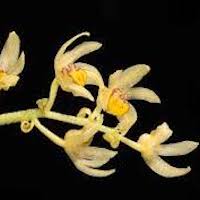
|
Pinalia graminifolia (Lindl.) Kuntze Syn. Eria graminifolia Lindl. Chinese name: Heyemao Lan (grainy leaf wooly orchid), Heyiping Lan Medicinal name: Heyemohu (grainy leaf black epiphyte) It is robust orchid which grows in large communities found in central and eastern Himalayas at 2000–3320 m, Myanmar, Tibet and Yunnan. Usage: The whole plant is used as a tonic. It helps digestion. A decoction is prepared with 3–9 g of the orchid. It is used to nourish the stomach, promote the production of body fluids, and to treat hot flushes, fever, sweating, malaise and anorexia. |
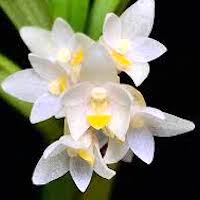
|
Pinalia spicata (D.Don) S.C. Chen & J.J Wood syn. Eria spicata (D. Don) Hand.- Mazz. Chinese name: Mihuaping Lan Phytochemistry: It contains nudol, erianthridin, sitosterol, erianol and an uncharacterized fatty alcohol. Herbal Usage: In Nepal, stems are rendered into powder and consumed to treat stomach ache, or are made into a paste and applied as a poultice for the relief of headache. |
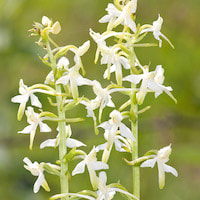
|
Platanthera bifolia (L.) Rich. Scandinavian name: Nattviole (night violet) German name: Waldhyazinthe (wood hyacinth) Chinese name: Xijushechun Lan Phytochemistry: Loroglossin, a phenolic glycoside, and phytoalexin are present. Leaves contain two flavonols, quercetin and kaempferol. Fragrant Species: It has beautiful floral fragrance that attracts the silver moth (Autographa gamma). Chemicals responsible for this are- benzyl benzoate, benzyl salicylate, cinnamyl alcohol, lilac aldehydes, methyl benzoate and methyl salicylate and lilac aldehydes. Herbal Usage: It is used as salep in Turkey and Iran. |
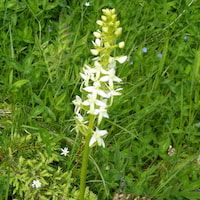
|
Platanthera chlorantha Cust. ex Rchb. Chinese name: Eryeshechun Lan Chinese medicinal name: Tubaiiji The herb is usually collected from August to October, after the flowering season from north and northeast China, Shaanxi, Gansu, Sichuan, Yunnan and Tibet. Herbal Usage: It is commonly used in Xizang (Tibet) as a decoction to nourish the lungs, to treat people who cough up blood, vomit blood, or bleed from their nose. The plant is also ground and made into a poultice to treat lacerations, skin infections and burns. |
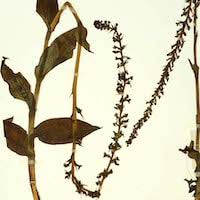
|
Platanthera clavigera Lindl. syn. Habenaria densa Wall. Chinese name: Zangnanshechun Lan Chinese medicinal names: Jishencao (chicken kidney grass); Jishenzi (chicken kidney); Yaoshenzi (waist and kidney); Shuangren (double kernels); Shenjingcao (kidney herb) It occurs in Kashmir, Nepal and Bhutan at 2300–3400 m. Jishencao is collected in August and September for medicinal usage. Herbal Usage: The entire plant is used to strengthen the kidneys and loins, especially for the impotence or sexual dysfunction, hernia, and enuresis affecting children. It nourishes the lungs and kidneys |
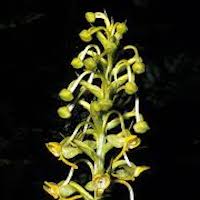
|
Plantanthera edgeworthii (Hook f. ex Collett) RK Gupta syn. Habenaria edgeworthii Lindl., Habenaria acuminata (Twaites) Trimen Indian Ayurvedic names: Riddhi, Riddhi Vridhi, Laksmi, Mangala, Rathanga, Rissisrista, Saravajanpriya, Siddhi, Sukha, Vasa, Yuga, Kakoli. (in Garhwal): also Pranda, Talgranthisamakand, Vamavartal, Vrisya It is distributed from China to the northwest Himalayas, and also in Anamalai Hills of Tamil Nadu. Herbal Usage: Riddhi is an important medicine in the Ayurvedic tradition. Roots are eaten as food or a tonic. It is also used as an aphrodisiac. It is sweet in taste, and “pacifies vata and pitta but aggravates kapha”, which translates as meaning that it is good for slim or driven people, but bad for those who are laid back or obese. It is cooling and promotes semen production. Leaves and roots are used for treating ‘diseases of the blood’. In Garhwal, Indian Himalayas, the powdered orchid pseudobulb is added to Ashtavarga and Swarnabhashma (from gold calcinations) to pre- pare a potion to promote milk production. Vriddhi is used as brain tonic, general tonic, depurant, appetiser, “rasayan” and emollient. Oral dose is 2–3 g of powdered tuber. It features in Astavarga churna, Chyavanprash rasayan and Mahamayura ghrita. |
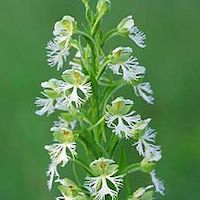
|
Platanthera fuscescens (L.) Kraenz.] syn. Platanthera souliei Kraenz., Tulotis asiatica Hara Chinese names: Qingting Lan (Dragonfly orchid), Zhuye Lan (Bamboo leaf orchid), Qingtingshechun lan Chinese medicinal name: Qingting Lan Korean name: Broad leaf dragonfly orchid It occurs in Korea, Japan and Siberia in open grassland, where the orchid plants are well shaded by taller grass. Herbal Usage: Whole plant is used to treat burns. |
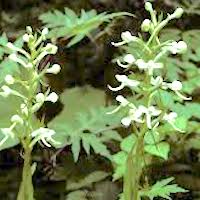
|
Platanthera japonica (Thunb.) Lindl. Chinese names: Changju Lan (Long distance orchid); Shuimaidong (water winter wheat); Shechun Lan (tongue-lip orchid); Qimashen (horse riding ginseng); Longzhuashen (dragon claw ginseng) Chinese medicinal name: Guanyinzhu It is found in forests and on grassy slopes of hillsides in Japan, Korea, the Chinese provinces. Herbal Usage: In western China, the whole plant is cooked by boiling over a slow fire, and eaten to improve the circulation and hasten recovery from injuries or sickness. A decoction is also used in Shaanxi Province to nourish the lungs, relieve coughs and phlegm and breathlessness. Also used for detoxification, healing toothache and snake bites. The herb may be used in decoction or as a poultice for application. |
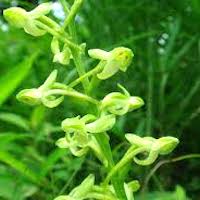
|
Platanthera minor (Miq.) Rchb. f. Chinese names: Dayizhijian (big arrow), Luanchunfendie Lan (soft lipped, pink butterfly orchid), Xiaoshechun Lan (small tongue lip orchid), Guanyinzhun (Guanyin bamboo), Chinese medicinal name: Zhuliaoshen It flowers in early summer and is found in China, Korea and Japan. Herbal Usage: In CTM, it is supposed to enlivens yin elements, benefits the lungs, improves air currents and promotes salivation. It is used to treat weak bodies, mental weakness, nocturnal emission, discharges and infants with hernia. It helps to strengthen kidney and lungs, relieves asthmatic coughs, kidney weakness and lower backache, dizziness, people recuperating from long illness and nocturnal emission. For decoction, 15–60 g of the plant is used. |
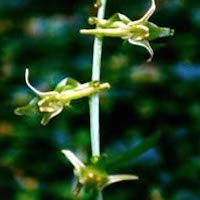
|
Platanthera sikkimensis (Hook f.) Kraenz. Chinese name: Changbanshechun Lan Herbal Usage: Tubers are used as a tonic in Nepal. |

|
Platanthera stenoglossa Hayata Chinese names: Xiabanfendie Lan (slim petal pink butterfly orchid), Xiachunfendie Lan (slim lip pink butterfly orchid), Xiasuishechun Lan (slim spiked tongue, lip orchid) It is found in Taiwan (only in Ilan) and the Ryukyu Islands of Japan. Usage: The entire plant is antipyretic and detoxifies, clears phlegm, stops coughs, improves blood flow and stops bleeding. |

